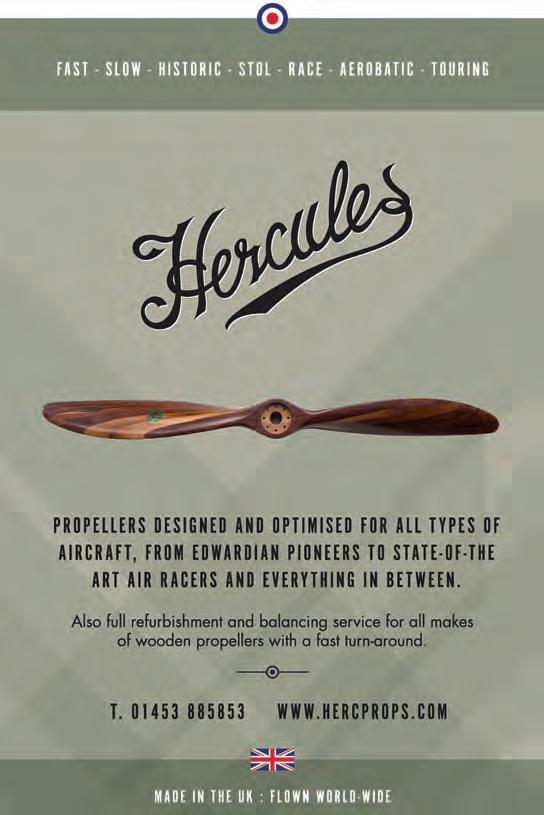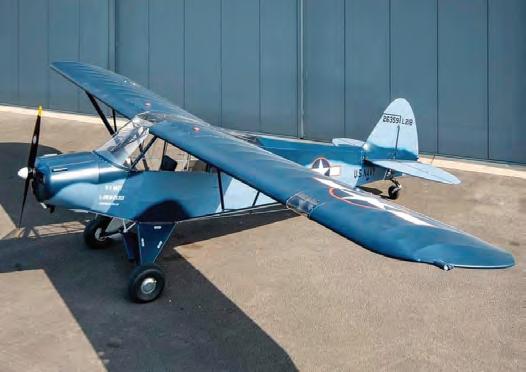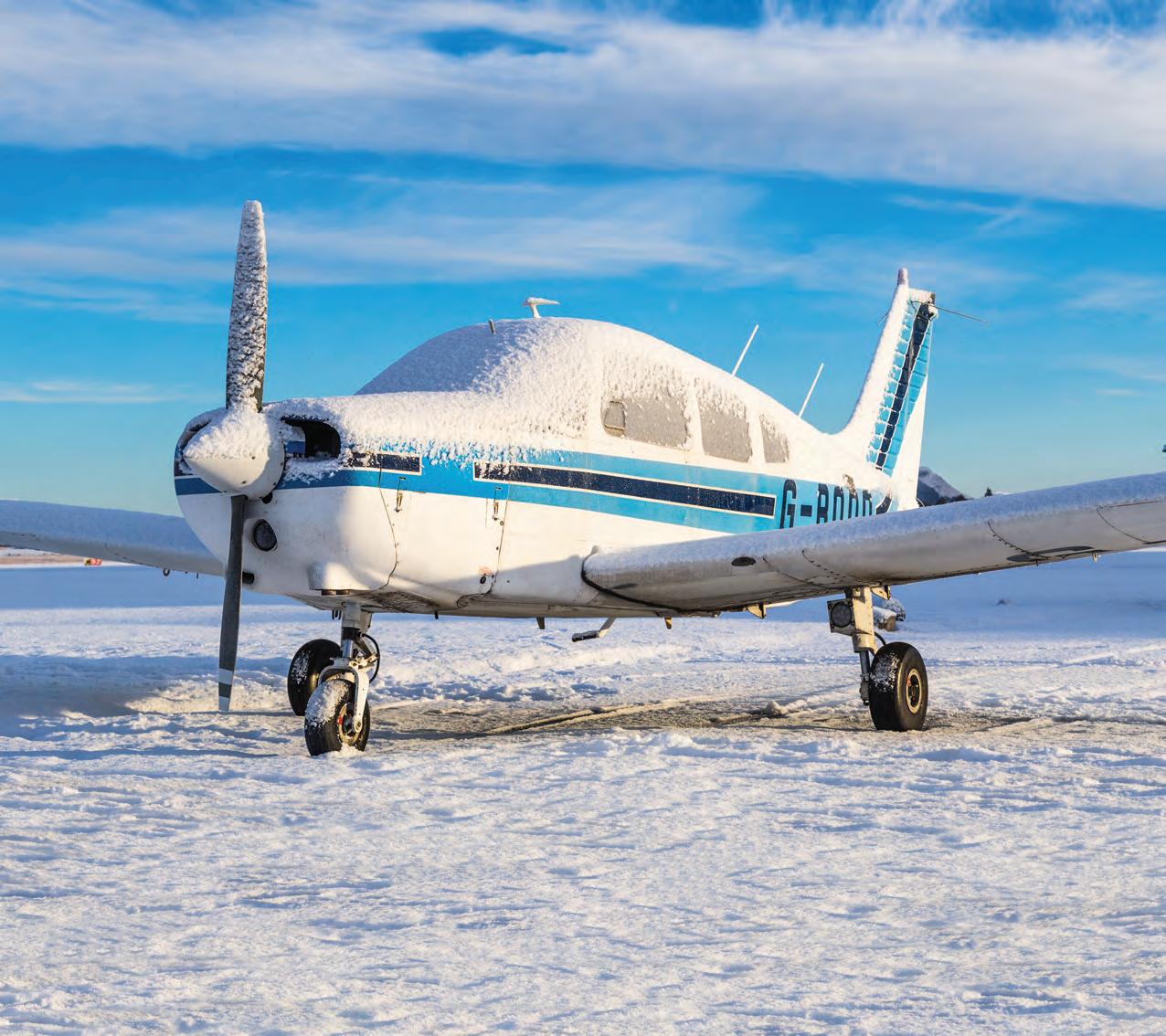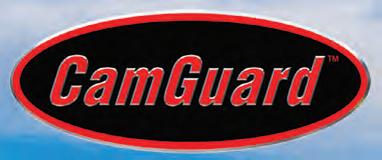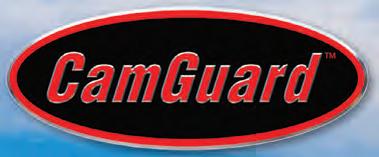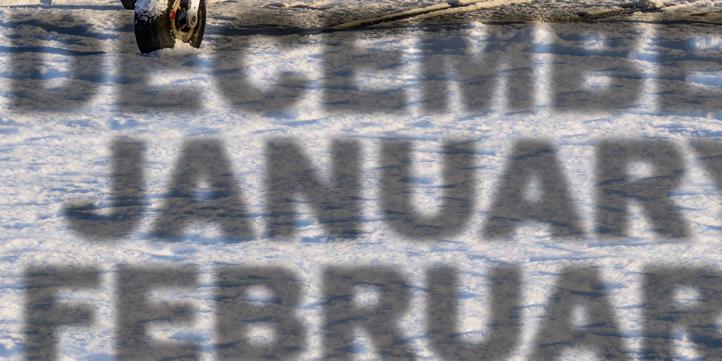Francis






Francis





The CAA is offering a rebate of 50%, up to a maximum of £250, to pilots purchasing Electronic Conspicuity Devices including those listed below. Equipment purchased from 1st October 2020 until 28 February 2021 will be eligible for the rebate.
uAvionix SkyEcho 2 Electronic Conspicuity

• ADS-B Transceiver and FLARM Receiver
• TSO-C199 GPS (SIL=1)
• Barometric Altimeter
• Up To 12 Hour Battery Life
• Use With SkyDemon, ForeFlight and more

The AGM passed by almost unnoticed with only 70 members logging into the Zoom event, most of those being from the usual hard core of active members who show up on a regular basis. I had hoped that the ability to ‘attend’ without having to leave the comfort of your favourite armchair might elicit a rather healthier showing, but I suppose after more than three decades of attending PFA and LAA AGMs myself, I should have realised that unless there’s some sort of upset, interest in how the Association is managed scores pretty low on our personal agendas.
Don’t get me wrong, if as members you are satisfied with the LAA, and I think on the whole most of you are, it’s up to you if the preference is to leave it to that oft overworked ‘someone else’ to take responsibility for the direction the organisation travels. I just happen to believe that it would be healthier if a broader spread of ideas and critique were at play, after all, they do say that ‘together we are stronger’. We have a brief AGM report on page 9.
re-christened G-KIRB, has finally been completed and flown.
Another particularly interesting aeroplane was also completed and flown this year, although it was a rebuild rather than a new build. The prototype Beagle Pup, G-AVDF, only flew for a couple of years in the late 1960s before it was pensioned off, having served its purpose.
It had heralded a new dawn, a post-war dream that Britain could once again become a major player in the light aviation industry, able to take on and beat anything the rest of the world had to offer. Sadly, it came to nought, the enthusiasm not being supported by sound financial sense, and only 175 Pups being produced before the house of cards collapsed.
The prototype was fortunate to survive and commitment, hard work and good fortune have seen it finally brought back to flying condition, resplendent in the same red and white scheme it left the Shoreham factory with in 1967. Francis Donaldson, a former Pup flying group member as a young man, regales us with the Beagle Pup’s fascinating story.
Many will recall the A Plane is Born documentary series in which Mark Evans built and flew a Europa XS; believe it or not, that was 20 years ago. It was a not particularly well-kept secret that the aircraft that Mark flew at the end of the series was not the one that he was seen building –project timetables work out just as badly for television as they do for the rest of us! So, what happened to the actual build project? Well you can read about that in our Project News Special on page 46 where the star of the show, G-OIZI, subsequently
Take care and be safe, Brian.
 Brian Hope
Meet the Members’ Frank Cox taxies in at Lundy in his superbly restored Fairchild Argus. Photo: Neil Wilson
Brian Hope
Meet the Members’ Frank Cox taxies in at Lundy in his superbly restored Fairchild Argus. Photo: Neil Wilson
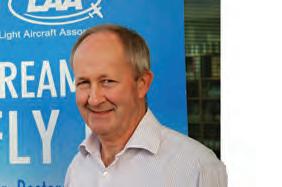
Greetings all, and a special thank you to those who were able to join us for our e-AGM (is that an actual entity?). Procedurally, all went well, and we were able to inject some animation into the event but it’s clearly no substitute for the real thing, which we hope we will be able to deliver next year. I was also pleased to hear support for keeping a remote AGM function even if we are able to meet physically, I think this is most appropriate for such an extensive organisation as ours with members and Struts so widespread.
We received some positive reaction to the delivery of this year’s AGM on the day, however, in the spirit of openness, we would welcome any further comments and thoughts, regarding how we might be able to improve future meetings.
Now that the AGM is out of the way, the LAA team has much to focus on, apart from all of the considerations thrown up by renewed restrictions and new ways of working. For this forthcoming year we have the 75th Anniversary celebrations, working with the CAA on the new 600kg class and ab initio in permit aircraft and more –there’s so much to look forward to.
On the latter points, we have had some positive discussions recently with colleagues from the CAA’s General Aviation Unit (GAU) on how we might progress the development of our sector of GA, both from the perspective of a broader base of types, and how as an association we must step up to the challenges this development will bring.
Right now, we are starting a review process of our airworthiness oversight permissions with the GAU designed to help us with further privileges, such as initial permit issue, transfer of types to the permit scheme and, of course, the 600kg class and ab initio. We must take advantage from this process, and this will no doubt require some changes to the way we do things in future. We will keep you updated as we progress.
In the meantime, I hope you can get out and fly as much as possible, as the days get shorter and the weather unfortunately deteriorates. It seems we are ending the year in the same way we started it with heavy rain, but I noted in my logbook that in the last three years, I was still able to fly through until the New Year before the grass runways and taxiways gave up the unequal struggle and became waterlogged, so here’s hoping!
VAC member Dave Scott is seeking an unserviceable Hewland three-cylinder two-stroke engine (as used in the ARV) for use as an exhibit at the Museum of Berkshire Aviation at Woodley. If you can help please contact Dave at: davescott321@btinternet.com
06 NEWS & LETTERS
Electronic Conspicuity rebates, A/I Bursary recipient gains PPL
09 AGM REPORT
A report from the LAA Ltd virtual AGM
10 PROJECT NEWS
KFA Safari update, Eurofox 912iS, X’Air Hawk, Cleared to Fly and New Projects
16 EC: UPDATE
The state of play with EC in light of the new CAA/DfT equipment rebate scheme
20 HEATH PARASOL
We dive into the archives to look at a very early LAA type – the Heath Parasol…
24 MAKING A PASS – TWICE
A post-pandemic challenge to drive and fly Austria’s tallest mountain – with a Kitfox and a Morgan…
28 COACHING CORNER
COVID-19 concerns impact on everyone. David Cockburn, PCS Head of Training, looks at continuing to fly safely…
30 NEVER GIVE UP!
After a lifetime of longing to become a pilot, with numerous setbacks, Gillian Boston obtained her well-deserved PPL…
36 STRUTS4U
Anne Hughes profiles the activities of the Struts, making good use of social media
38 FLIGHT TEST
Francis Donaldson flies the recently rebuilt prototype Beagle Pup, bringing back memories aplenty
46 PROJECT NEWS SPECIAL
A TV ‘star’ languishing forgotten in a hangar for years, has finally been completed
50 REFUELLING CONUNDRUM: 2 More ideas from members about refuelling at private airstrips…
54 SAFETY SPOT
The importance of thorough inspection – it’s not just a tick box!
60 MEET THE MEMBERS
Frank Cox, former Fleet Air Arm, corporate jet pilot and restorer / owner of a Fairchild Argus
66 CEO THOUGHTS
Steve Slater on contingency planning…




Electronic Conspicuity has become an increasingly important topic in recreational flying over the last few years. It is seen as a useful tool not only in the open FIR for collision avoidance, but also within controlled airspace as a means of accurate position identification of all traffic by all traffic as well as ground controllers. From the recreational pilot’s viewpoint, it is also hoped that it can more readily open up access to more of that airspace.
In order to encourage engagement with EC technologies, the DfT has made funding available in the form of a 50% rebate up to a total £250 (a £500 spend) on the purchase of EC equipment. This includes the Pilot Aware Rosetta, uAvionix SkyEcho, Power Flarm, ADSB Out capable transponders, and approved GNSS position sources such as Trig’s TN72.
The scheme is being managed by the CAA and opened on 5 October and will run till 31 March 2021, and

will cover purchases from 1 October until 28 February 2021. Conditions for application are:
■ The equipment must be carry-on or aircraft-fitted devices.
■ A single rebate of 50% – up to £250 per applicant.
■ Only equipment purchased from 1 October 2020 until 28 February 2021 will be eligible.
■ You must produce a proof of purchase receipt.
■ You must hold at least one of the following UK issued UK or EASA Part FCL pilot licences: Private Pilot’s Licence
In a recent update on licensing, the CAA offered the following advice to GA pilots.
We recognise that COVID-19 remains a significant challenge for the foreseeable future and we remain committed to continuing to provide as much support as possible to GA. For procedural, legal and safety reasons, we are not able to provide exemptions in perpetuity and the GA sector needs to prepare for an ending of certain exemptions soon as part of the return to a more normal operational and licensing framework.
GA organisations, operators, pilots and students are encouraged to review their own circumstances now in order to decide how they can best prepare themselves for the ending of exemptions which have extended the validity of some

pilot licences (which would otherwise have expired) to 22 November 2020 and some medical certificates (which would otherwise have expired) to 31 December 2020.
Noting the unpredictability of the British
(PPL), Commercial Pilot’s Licence (CPL), National PPL (NPPL), Sailplane Pilot’s Licence (SPL), Balloon Pilot’s Licence (BPL), Light Aircraft Pilot’s Licence (LAPL), or be a registered member of either the British Hang Gliding and Paragliding Association (BHPA) or the British Gliding Association (BGA). UAS/ UAV operators must hold an authorisation issued specifically to them by the CAA.
Full details on those eligible to apply, EC devices and how to claim a rebate are available on the CAA website at www.caa.co.uk/ec
weather, particularly in the winter, and the potential for future COVID-19 measures to unexpectedly curtail planned flying, pilots whose ratings may lapse soon or over the winter months are advised to take early action to revalidate their ratings if they have the opportunity to do so.
Blessed relief to those flying EASA aircraft comes in the issue of an updated ORS4 No 1421 to replace No 1370. This effectively allows pilots with a UK issued PART-FCL PPL or LAPL to continue to exercise LAPL privileges (only) in G registered EASA aircraft in UK airspace without the appropriate Medical Certificate, provided they have made a valid Medical Declaration to the CAA and not withdrawn it. The exemption expires on 31 March 2021.
LAA members Keith Vinning (left), of PilotAware, and Tim Dawson of SkyDemon, received OBEs in the Queen’s Birthday Honours list for services to aviation safety.
Keith commented “It was a great honour and privilege to be able to accept this award not only for myself, for Lee Moore and
our small team at PilotAware, but also for the aviation communities who have supported the PilotAware infrastructure over the last five years.”
Tim said “It means a great deal to be recognised in this way by Queen and country. I could not have made the
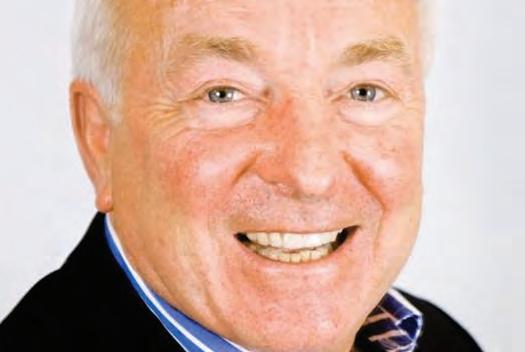
Iwas awarded one of the 2019 Armstrong Isaacs Bursaries, to a value of £1,500, to help me through my PPL training. The bursary allowed me to complete all of my training towards the navigation phase of my PPL, including my qualifying cross-country. I completed my training at Bristol Aero Club (Gloucestershire Airport).
On 13 October I passed my skills test, and on the 16th I passed my RT practical exam. I have just finished the application for my licence, and I hope to receive it before my 18th birthday!
This bursary was an amazing help and gave me that final boost that I needed to get my PPL completed; I believe it would be incredibly beneficial to others to benefit from the same bursary in the future.
I can’t wait for the LAA Rally next year, and hope to fly myself (COVID-19 restrictions permitting). Thank you so much again, this bursary has helped set the foundations for an exciting future in aviation. Kind Regards, James Gunn
(The 2020 crop of Armstrong Isaacs Bursary applications will be assessed during November and five £1500 bursaries awarded. Recipients will be notified in December. Ed).
contribution I have to aviation safety without my wonderful team at SkyDemon.”
Heartiest congratulations from everybody at the LAA, not only for the awards, but for two excellent products that have made our pastime appreciably safer and more enjoyable.


Dear Editor The hand wringing over airspace busts continues (Letters, LA News, September 2020) with yet another study into the ever-upward trend of infringement underway – but even the researcher admits ‘there appears to be no simple explanation.’
I’d suggest that there is at least one simple explanation – the absurdly complicated way in which UK controlled airspace is designed.
Take a look at Doncaster Sheffield’s airspace. The lucky controllers there preside over not one but two CTR segments and – if you can believe this – no less than 12 CTA segments of every imaginable shape and size. And they are far from being alone –Solent’s bizarrely-shaped airspace includes 10 CTA segments of assorted shapes and sizes. And don’t get me started on Farnborough…!
Now take a look at the chart for Nashville International’s controlled airspace, it’s blissfully simple – just three segments.
So, is it because Sheffield and Solent are so incredibly busy that they need all that super-complicated controlled airspace?
Hardly. Combined movements at Southampton and Bournemouth in 2019 were 76,359. At Sheffield Doncaster they had just 36,473 movements to justify hogging all those weird chunks of air. By comparison, Nashville International with its simple layout managed to cope with more than 230,000 movements.
Typically, airspace around airports in the US is designed based on an ‘upside-down wedding cake’ model – simple to read and understand, resulting in infringements being relatively rare.
We in the UK seem to have a knack of making everything more complicated than it need be. Those who design our airspace could do worse than look at the way they do things in the US. Until then, for as long as our controlled airspace resembles a collection of jigsaw puzzles, infringements by confused pilots will continue. Regards, Tim Watson.
Dear Brian, the article by Ian Fraser on GPS jamming trials and the potential effects for navigation in the October edition of Light Aviation was very interesting and thought provoking, especially raising the old debate about whether pilots should carry a paper chart on flights as a back-up.
The comment regarding the difficulty in obtaining information on these trials, or indeed many other things of interest to GA pilots, can more readily be delivered to electronic devices direct from the CAA by registering at http://skywise.caa.co.uk and as it states on the website: Aviation is a dynamic industry, and SkyWise allows you

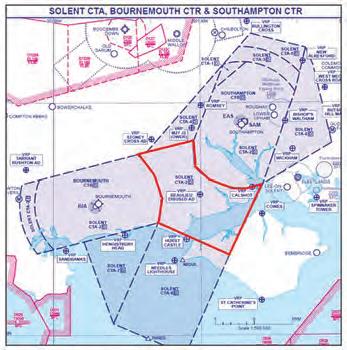

to stay up-to-date with news, safety alerts, consultations, rule changes, airspace amendments and more from the CAA.
Advance information on the jamming trials is also sent by this means, well in advance of the trials taking place and I recommend LAA members to use this facility.
The information comes as a short resumé and, if the recipient decides it is not relevant to them, they can just delete the email, but if useful, opening it will provide full details.
Another useful source of information is the CAA Airspace & Safety Initiative website at https://airspacesafety.com
Regards from John Broad.
(Useful info John, thanks, but if something is flight safety relevant, it should be Notamed! Ed)
Hi Brian. Always enjoyed the mag and still do. Just an idea – is it possible that the CHIRP GA edition could be published in the mag? I used to enjoy reading the CHIRPs when they came as hard copy inserts and
realise why they stopped around Credit Crunch time and money for anything ‘non-essential’ (since when is safety a luxury?) disappeared, but I still miss reading something REAL. I try to keep up with CHIRP electronically, but it just isn’t the same!
I don’t think I am a ‘flat-Earther’ or hopelessly behind the times – I am a software developer, albeit one in my 50s.
Like a lot of people, I stare at screens all day and it’s nice to have something on paper to read when it comes to reading for pleasure. It would probably increase CHIRP’s readership, which can only be a good thing. Regards, Rob Swain.
(I am sure many of us appreciate the tangibility of a paper magazine, so I do wonder whether the likes of CHIRP and the Airprox reports suffer from poor take-up. Though I am averse to simply publishing their content en masse, I wonder whether particularly relevant to LAA material might be usefully included. What do members think? Let me know. Ed)
The pandemic forced the Association to take a new route to holding its 2020 AGM and for the first time it was held virtually, with attendees logging in to a Zoom conference from the comfort of their homes. Technically it worked very well, with Chairman Tim Hardy and CEO Steve Slater hosting the event from Turweston HQ.
The meeting started on time, 1000, and Tim announced that he had received one apology for non-attendance from John Mangham.
With only 68 members in attendance, less than the required 1% of the membership, it was not quorate and, in accordance with the Articles of Association, 20 minutes had to elapse before he was permitted to rule that the meeting could go ahead. The time was usefully taken up by Steve Slater presenting his CEO’s Report.
CEO Report: Steve congratulated the LAA staff on managing to maintain a good level of service to members despite having to work from home for two months during lockdown, and the subsequent COVID-19 safety requirements once back at HQ. The Association saw a significant drop in income over the first six months of 2020, but has recovered well latterly, with only 100 less aircraft being permitted (2,600 instead of 2,700) than in 2019. Membership has fallen by about 100 over the same period, almost certainly due to all the events where
we recruit new members unfortunately being cancelled.
Although sadly, this included the Rally, we are already forging ahead with plans for 2021, the Association’s 75th Anniversary, and events will include a special Anniversary Dinner, a Round Britain Flying Rally, and of course a bumper celebration Anniversary LAA Rally at Sywell.
The AGM was officially opened at approximately 1030.
Tim Hardy welcomed those in attendance and also commended the LAA staff on a job well done throughout a difficult year. He also passed on the thoughts and best wishes of the Association to all members and their families, some of whom will sadly have been adversely affected by COVID-19.
Voting this year was, of necessity, by proxy form only, sent in prior to the meeting and 247 completed forms had been received.
The vote to approve the Minutes for the 2019 AGM was announced, see the table (below) for details.
Treasurer’s Report: Will Garton-Jones reported that our finances remained in a strong and stable position, despite the fact that although COVID-19 followed on from a very wet winter, resulting in income being down 50% in the first half of the year, subsequently we had made a strong
recovery. We had also not had to furlough staff as previous investment in Cloud technology had enabled them to work effectively from home, and thus maintain member services.
Reporting on the 2019 financial performance we had made a planned deficit of £49,502 against an income of £1.3m after a number of very profitable years. The decision had been taken to invest in a succession plan – three additional engineering staff members – as several of our engineering team were nearing retirement. For 2020, our planned deficit will, as a result of COVID-19, be greater than planned which will mean a necessary change in plans for 2021, and an increase in subscriptions is being considered. For further details of the 2019 financial performance, please refer to the July 2020 issue of Light Aviation
The remaining votes were presented at this point – which completed the official business, and a members’ forum commenced, allowing an opportunity to raise a variety of topics.
Tim thanked those who had attended and commented that hopefully next year we could return to the AGM Day format with guest speakers etc., and the ability to fly in. A virtual element would, however, usefully be continued for those who were unable to attend in person.
The Meeting officially closed at 1130. ■


n the past, particularly with early scratch-built aircraft, the engine would be a project in its own right – adapting a car engine, maybe a VW Beetle, or perhaps rebuilding a tired existing aero engine and improving its electrical and ignition systems with after-market components. Coincident with the maturing of quick build, often high-performance aircraft kits, the Rotax 9-series four stroke engines really came of age, and itself matured into more sophisticated, higher power, more complex variants. Dare I say a little boring, a true Germanesque creation, an Audi of aero engines, fantastically dependable but perhaps a little dull. Costing maybe as much as a basic airframe kit, they are so reliable and expensive that they don’t seem to attract the bloke in a shed with an eye to making improvements.
In the UK, the only long-term tuning part available has been an alternate ignition module to tame the 912’s gruff starting habits. Of course, it goes without saying that most of us are more than happy with reliable uniformity, but some of us ‘old school’ engineering types do enjoy a bit of experimentation.
More recently Edge in Norway seems to have had more of a profile with their 912 aftermarket fuel injection and turbo kits . Their website proudly states that they have been interfering with Rotax engines since 2007, so clearly there is a tuning and modding world out there for the Rotax.
The build of my Safari is progressing well. There is a fair amount of work involved with the fitting of the butt ribs (the ones either side of the fuselage centre section), cockpit roof, windscreen, boot cowl and rear turtle deck. The design is rather clever, and a great deal of thought has been put into gaining access to the forward fuselage for maintenance.
Whilst the roof and butt ribs are painted prior to riveting to the fuselage, the rear turtle deck is removable, which is necessary for wing folding. The really clever thing though is that the boot cowl moulding, which covers the fuselage top and sides from the firewall to the door pillars, is removable, giving superb access to the rear of the instrument
Now, an Italian company, Vz Power, are also in the aftermarket Rotax business, producing a retrofit turbo kit. And it is a Vz engine that Dudley Pattison has chosen to hang on the front of his KFA Safari.
Thus far, Dudley has provided a couple of updates on his Safari, the first UK example to feature in Project News , and below he outlines how he is tackling the forward fuselage, wing covering, and preparing to hang that hot 912 lump up front.
We also hear from Peter Harvey, who provides an overview of his Eurofox project and the impact both Brexit and COVID-19 has had upon it. The very lucky chap now has a gorgeous Rotax 912iS powered Eurofox in which to fly around his local Cornish skies a nd the convenience of a workshop in his garden, sounds like flying heaven to me!
And finally, Dave Western and John White have built X’Air Hawk G-CLDR between them – and found it to be all they hoped for. I know from personal experience that these airframes come together at lightning speed and then take a little longer to commission with engine, instruments and paperwork. Bolted tube and fabric sock style, they are the Ikea of aircraft construction.
To get in touch with Project News , and tell your story, report a milestone or just to send a picture, email: projectnews@laaarchive.org.uk . Please share your story!
panel, fuel lines and valves, rudder pedals, header tank etc.
Once the firewall and engine mount have been fitted, the boot cowl is screwed to the preformed flange on the firewall and to lugs welded at strategic locations to the fuselage framework.
Bending the 3mm polycarbonate windscreen around to meet the fuselage members at each of its rear edges is a bit fright making, but it works, and with the aid of a few speed clamps it is possible to do this solo. The bonus is that if you wreck your screen by spilling fuel on it (how many times have you heard of that happening to someone?) the screen can be easily removed and used as a pattern for its replacement.

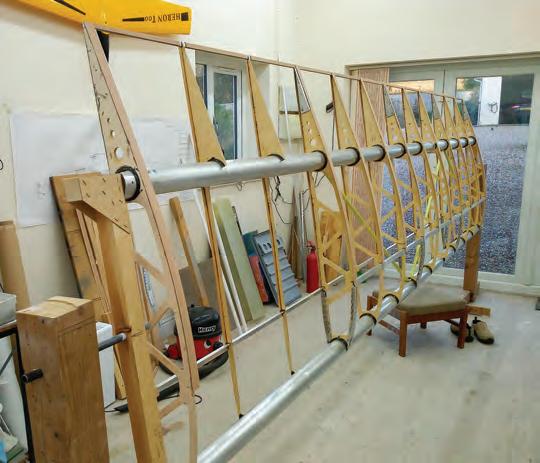

So, the fuselage is sitting in the garage ready for the Vz Rotax to be hoisted into position. This engine came from the Vz Power company in Italy, who take an 80hp 912, add their turbo to it and the 80hp becomes 115hp. The plan is to fit an FP propeller, which is a fully automatic variable pitch propeller which, I am told, will not allow the pilot to over boost the engine. Sounds like the one for me. This propeller is currently being flight tested with the aim of gaining LAA approval.
A few days ago I brought the first wing from the garage into the workshop for covering. This is another first for me as I have never covered an under cambered wing on a full-size aircraft before, models yes, but this wing panel is quite large at four metres. The under camber isn’t heavy though, and no difficulty has been encountered as yet (my fingers were crossed as I typed that, and that is difficult…).
As I have mentioned in a previous Project News , I am using the Poly-Fiber covering system with single pack Polytone paint. Polytone doesn't have a high gloss finish, more a subtle eggshell finish, which in my eyes better suits the types of aircraft I usually build (Van’s excluded).
This paint is very easy to apply and the chances are you won’t die spraying it. One problem that it does
Above The wing is covered in two pieces starting with the under cambered section of the underside. Here the spar position, ribs and trailing edge are pre-glued Polytak. The fabric is then laid on and a 50/50 mix of MEK and Polytak is brushed through the fabric to bond with the pre-glued areas. Photo:
Above right Vz Rotax lump ready to be lifted in. The roof is nearly finished, and the screen and boot cowl fitted. Access is given to the footwell and rear of the instrument panel by removing the boot cowl.

throw up is that it doesn’t stick to metal components very well. There is a way around this that is not too onerous, and worth doing in my opinion, to keep the other benefits of Polytone. The metal parts are prepared in the usual way, sanding, etch primer, grey primer etc. When at the stage that you would normally apply the topcoat, it is sprayed with Poly-Fiber EP-420 epoxy primer. While this primer is still tacky, a light coat of Polytone is sprayed onto it. It doesn't mean you need two spray guns though, as you have time to clean out the epoxy from the gun and refill with Polytone. It is all in the detailed Poly-Fiber manual.
So, when the two wings are covered and have the Polybrush applied, I will take them back to the garage and bring the fuselage into the workshop, after hoisting the engine into position. They will reside there during the winter as my spray shop is actually ‘the great outdoors’, meaning I will have to wait for warmer weather to Polyspray and Polytone them.
With the fuselage indoors, I can start on the instrument panel and finish the forward fuselage. I missed school the day electrics was taught, luckily Merv White attended, so he is going to help in that department. I have often said that I don’t know how it is possible to build aircraft without friends!
Building my own aircraft has been an ambition of mine for a number of years – but a passion not shared by my wife! But, by 2018, rather as water dripping on stone will eventually wear a hole, I won her over. Over previous years I had researched a number of options and knew that by this time I didn’t want to take many thousands of hours building essentially from scratch. A flight with Roger Cornwell convinced me of the merits of the Eurofox, as well as making my decision on colour scheme an easy one too; I simply copied his aircraft as I thought it looked stunning.
I have always been a fan of new technology, and I found the reviews of the 912iS very interesting, particularly the ability to abandon carb heat and mixture control. Additionally, the Eurofox team had very much led the way with introducing the 912iS into the UK, so I knew that I would be in good hands when the inevitable queries arose.
At one level the engine is extremely easy to install, no carb balancing, only a single (throttle) cable. Admittedly there’s a plethora of sensors and with everything controlled by the box of electronics, a distinct lack of user serviceable parts. I had to work quite hard to make sure the panel wiring didn’t become a nest of rats’ tails!
Below Always a benefit if our creation has room to spread its wings in the garden. Photo: Peter Harvey
On the advice of Eurofox, I combined the 912iS with Kanardia instrumentation, an EMSIS unit for all the engine parameters, and a HORIS which is linked into the same system and gives a DI, horizon, ASI and Altimeter. It additionally provides the GPS feed for the ADS-B out on the f.u.n.k.e. transponder.
Obviously it is still very early days, but to date the engine performance has been faultless. Starting is easy, it appears to be extremely economical, burning just nine litres/hour at 4,000 revs, which is enough to bimble around at 90mph. At around 4,500rpm that rises to 12 l/hr as the speed increases to 100mph. The Eurofox is a draggy machine and high top-end speed was never part of the design criteria.
Take-off performance and climb rate are both excellent, it’s no wonder that the aircraft has proved so popular with gliding clubs around the country as a tug.
So how exactly did Brexit and COVID-19 play a part? Those of us with long memories will recall we were originally set to leave the EU at the end of March 2019. It seems that the factory in Slovakia decided that UK buyers would change their minds about importing aircraft once that happened and put all UK orders on hold. Whilst this was sorted out quite quickly, it did mean that my kit didn’t arrive in the UK


in June, as originally planned, but in November. By that time, Rotax was having supply problems with the fuel pump units, so that didn’t appear until sometime later.
December, January and February were always going to be full of other commitments, so initial progress was quite slow. Then the nationwide lockdown was introduced, but luckily for me my build workshop is at the bottom of the garden, so I spent most of the lockdown happily building Foxtrot X-ray.
Then I had to hit the pause button as my Inspector wasn’t able to travel to sign off the work. Up to that point we had had numerous phone calls, swapped photos and managed to overcome all the problems/ queries I’d encountered. However, as any builder will know there can be no substitute when it comes to finally signing off the project.
By this time the LAA were back working in Turweston HQ but there was a further delay in issuing the Permit to test fly whilst one or two queries, mainly about whether I could test fly the aircraft myself, were sorted out.
Then the insurers seem to have their own COVID-19 ‘moment’, but thankfully all the pieces of paper did duly arrive and, despite Brexit, COVID-19, Rotax fuel pump problems and such, Foxtrot X-ray took to the sky, with me at the controls, on 4 September.
To anybody thinking of building, I would encourage you to take the plunge. I’m no engineer by training, although I
Above The panel as a work in progress.
Below The Kanardia EMSIS and HORIS, well-suited for teaming up with the Rotax 912iS. Photo: Peter Harvey
do like to think that I’m quite practical. There is a plethora of advice available out there, and the choice of kits seems to grow every year. I was looking for a taildragger that had good short strip performance and that, in truth, would probably spend most of its time bimbling around the superb Cornish coast, yet had sufficient load carrying capacity and range to take me further afield if I wanted. The Eurofox fits the bill perfectly…
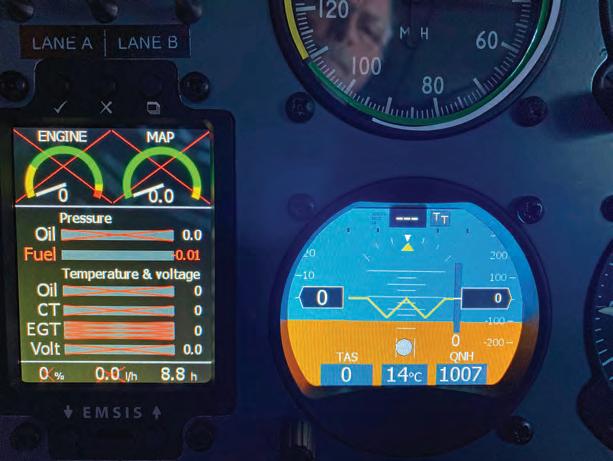
We decided that we would, between us, construct an aircraft, and both leaned towards a rag and tube kit, of which there are many on the market. However, after a phone call to Gordon Salter of Wessex Light Aircraft Co, we went down to his strip, viewed an X’Air Hawk kit, and were taken up in his demonstrator. The decision was made. The kit comfortably beat all the competition on price, was easy to fly, and again compared well to other similar types. Of course, it also helped to know the importer was friendly and helpful, and perhaps more important, knowledgeable.
Due to his work involving a desk, PC, telephone and photocopier, it was decided that John would handle the paperwork, for which I am grateful. I, on the other hand, would do the bulk of the build, because as a small boy I had owned a Meccano set… I hasten to add that I also went into the Fleet Air Arm as an aircraft mechanic as my first post-school occupation.

If your aircraft has been featured in the New Projects list, please let Project News know of your progress at: projectnews@laa-archive.org.
uk
n Pitts Model 12 (LAA 349-15719) 28/09/2020
If your aircraft has featured recently in the magazine and has subsequently completed its maiden flight, Project News would like to hear from you at: projectnews@laa-archive.org.uk
n G-JOET Eurofox 912S (LAA 376-15691) 24/9/2020
Mr Joseph Thomas, Rose Haven, Bourne Lane, Hamstreet, Ashford, TN26 2HH
n G-LLYN Eurofox 912iS (LAA 376-15678) 29/9/2020
Mr Dewi Griffiths, Bryn Haul, Dinas, Pwllheli, LL53 8UB
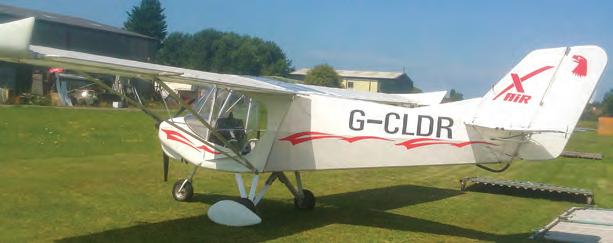
Above The Hawk is almost ready to test fly.
Left The X’Air product line has always been blessed with a very roomy cockpit, and the Hawk is no different.
Photo: John White
The build itself was straightforward, as any builder will tell you, and after quite a short period the fuselage is up on its wheels and you feel the rest will follow very quickly. Sadly, this isn’t the case. For many weeks to follow, nothing seems to change, appearance-wise, as your time is taken up with engine installation, controls, wiring etc.
However, the time eventually comes when you start to build the wings, and then things develop more quickly, until all that is left to do is the paperwork. At this point don’t get too excited, the paperwork is a major task. Then there is the test flying, which we left to Gordon, since he has flown more X’Airs than I’ve had hot dinners. We have to say now that she’s complete, it’s probably the best flying experience we have ever had. She is fast enough to get us anywhere we are likely to go in decent time, fuel burn is very good, stability and manoeuvrability excellent, and she’s a good looker too.
Thanks to Gordon Salter, the importer, who must have answered the phone to me 100 times, yet always found time and patience to solve my problems, and to Miles our Inspector. Also thanks to all at Westonzoyland Flying Club, who followed the build with interest and encouragement.
Flt Lt C Altass, 31 Herrick Road, RAF Brize Norton, Carterton, Oxfordshire, OX18 3FF
n Sling 2 (LAA 399-15717) 01/09/2020
Mr P G Hooper, 44 Lynford Avenue, Weeke, Winchester, Hants, SO22 6BN
n G-PLJR Pietenpol Aircamper (PFA 047-13426) 29/9/2020
Mr Patrick Taylor, 6 Swan Lane Marsh, Gibbon, Bicester, OX27 0HH
n G-SEKR ISA 180 Pocket Rocket (LAA 408-15535) 11/9/2020

Northern Aircraft Company Ltd., Sunnyside House, Hutton-LeHole, York, YO62 6UD
n Van’s RV-14 (LAA 393-15720) 30/09/2020
Name & Address held by LAA Engineering
n Van’s RV-7 (LAA 323-15718) 15/09/2020
Name & Address held by LAA Engineering
n G-CKCF Scintex CP301-C1 (s/n 557) 11/9/2020
Name & Address held by LAA Engineering
n G-CLKN Supermarine Spitfire MK26 (PFA 324-14634) 9/9/2020
Name & Address held by LAA Engineering
n G-REVV Van’s RV-7 (LAA 323-15588) 7/9/2020
Name & Address held by LAA Engineering
n G-VXXY Aeroprakt A32 Vixxen (LAA 411-15702) 29/9/2020
Name & Address held by LAA Engineering
n G-YELA Van’s RV-8 (s/n 2002509) 24/9/2020
Name & Address held by LAA Engineering



Following on from my previous articles I continue to monitor Electronic Conspicuity (EC) as it evolves in today’s aviation environment. As an engineer, I like to make decisions for my aircraft’s equipment based on an understanding of what is actually going on, rather than sales literature and blogs. In this article I focus on some key aspects of ADSB.
Recently there have been a couple of announcements on EC, the most headline grabbing one being the CAA / DfT announcement of a subsidy of up to £250 to help equip you with EC. This will cover 50% of EC-related purchases, up to the maximum £250 subsidy (https://tinyurl.com/ CAA-EC-offer). The other, announced in last month’s LA magazine, is a revised procedure for the LAA on installation of EC equipment on your aircraft (TL 3.03 section 9). For details see https://tinyurl.com/LAA-TL-3-03
Electronic Conspicuity is a concept in which radio beacons in our aircraft send out information about our current position, and radio beacon receivers in other aircraft, or on the ground, tell their crews where we are relative to them and display this information on a traffic radar display, an electronic map or via an audio warning device. ‘EC Utopia’ is when all beacons and receivers work together, everyone has one, they all work properly, and everyone can detect a collision risk if there is one. At the moment however, there are at least three competing standards which are not visible to one another.
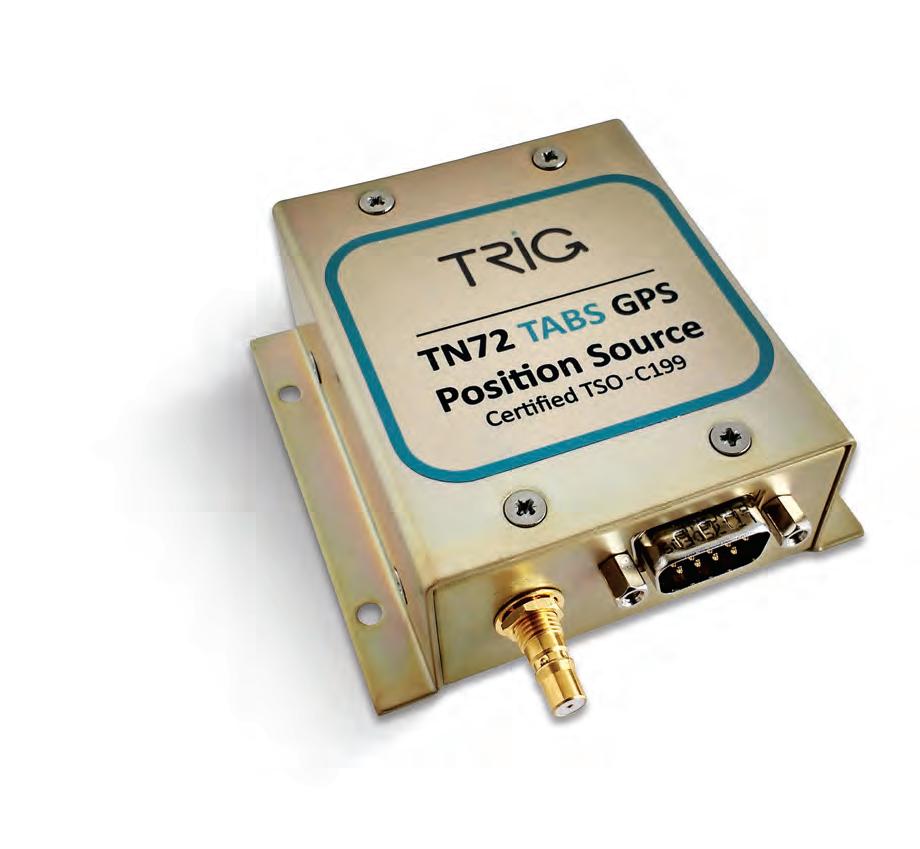
EC is a dystopian world full of jargon, acronyms and confusion, and is a long way from being able to achieve the high standards expected of it. The CAA’s initiative can help improve EC by encouraging purchase or upgrade of either a beacon, receiver or both, but before you spend your share of the money, make sure you understand what the gadgets will do for you.
There are lots of dialogues on the aviation forums on the subject of EC equipment and which is best. The RV forum is just one example, and has recently been dominated by a ‘my solution is the best thing since sliced bread’ ping pong about FLARM, PilotAware and ADSB. They all have their strengths and weaknesses, so I won’t repeat the numerous articles written in this and other mags.
However, a significant issue which is increasingly being discussed, and is indeed important, is an obscure setting in the ADSB messages called, ‘SIL’. So, what is SIL all about? And what is its significance to EC, and indeed you, in the decision-making process of getting on board with EC?
Above The Trig TN72 is a certified GPS position source that will enable your ADSB ready transponder to transmit on SIL 1.
SIL
SIL (Surveillance Integrity Level) and its associated SDA (System Design Approval) are terms you will see referred to constantly almost everywhere ADSB is mentioned. They are simple numbers that define how reliable your transmitted position information is, and hence what it can be used for. They are determined by the approval standards TSO (Technical Standard Order [FAA]) or ETSO (European [EASA] TSO) of your GPS and Transponder, broadcast in the ADSB radio data message, and tell the recipient how reliable the GPS derived position information is that you are sending them. That in turn is used by the recipient’s equipment to decide what it can do with it, e.g. just provide awareness via a map or radar display, generate an alert, or form the basis of formal collision avoidance advice.
In some parts of the world where EC has become mandatory, SIL also determines if you are allowed to enter restricted airspace. Plus, keep this in mind for our future too, SIL is, in most cases, operator settable on your transponder, but there are rules governing what you can set. SDA, the other mysterious acronym, is an automatically generated value based on your SIL setting and a hardware value for your transponder. It is not operator settable, so while it forms part of ADSB jargon, we can ignore it and just concentrate on SIL.
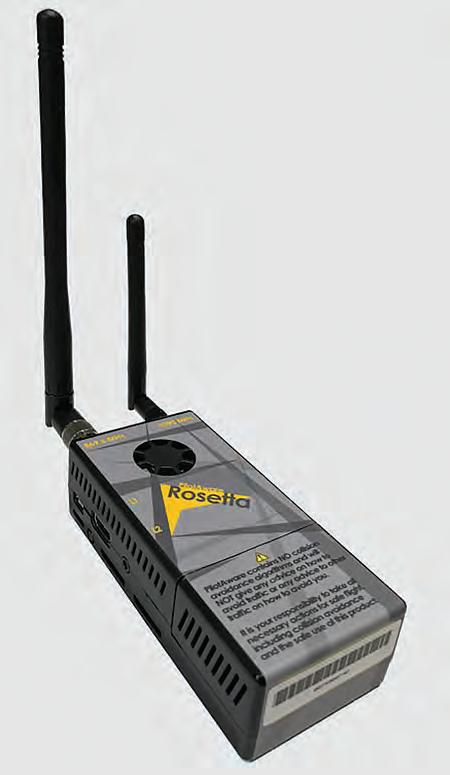
Your SIL setting is key to being universally conspicuous and it has just four values, and they equate to a statistical probability of the position you transmit achieving a level of consistent accuracy. In other words, are you actually where you say you are? SIL 1 for example, indicates that there is less than a 1x10 3 per hour chance of your position report being outside a predetermined radius of your real position.
SIL 0, however, is the basic level output by a device with an uncertified GPS and implies that the position information you are transmitting has no known pedigree, so it cannot be totally relied upon by the other parties to make safe traffic avoidance decisions. In other words, your position message is only good enough to tell the recipient crew that you are close, but not necessarily (or accurately), where to look for you. Despite your portable GPS’s position accuracy display (it is just a theoretical calculation), you could be several hundred metres from where you report that you are, which could be due to satellite problems, reception problems, weather, interference – or more worryingly – jamming. This could result in an avoidance manoeuvre by another party, based solely on your reported position, actually causing rather than avoiding a collision.
It has long been said by various aviation safety agencies that awareness of traffic presence could make a valuable contribution to safety, and through CAP 1391 the CAA permitted the use of non-certified GPS’s to be connected to a Mode S transponder to affordably achieve this traffic awareness aim.
To identify such systems, the CAA mandated that a message reporting their status be transmitted with the position information – and they used GPS integrity indicators SIL 0 and SDA 0. They were previously a fault condition but have now become a valid status. However, most certified (and some uncertified) ADSB-In devices (receivers) still treat it as a fault status and completely

Top left The PAW is a rightfully popular device but it lacks ADSB-Out capability.
Top right No transponder? The UAvionix Sky Echo 2 beacon with a certified GPS is a lower cost alternative for ADSB-Out.
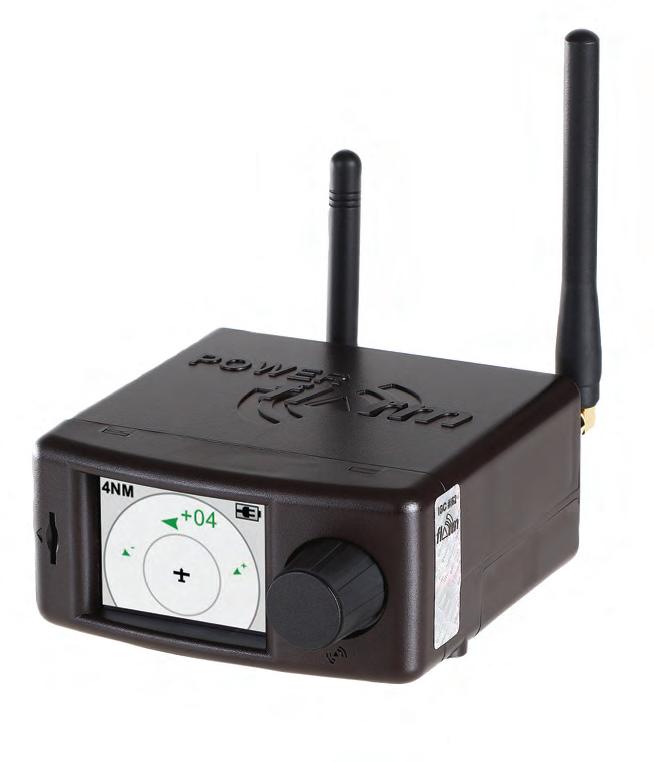
Above The long established FLARM and Power FLARM are also not ADSB-Out compatible.
ignore a SIL 0 message so, despite transmitting ADSB, you remain invisible to them.
To overcome these weaknesses, a process of constantly checking a GPS’s reported position was developed called Satellite Based Augmentation System, or SBAS. The US version of this, WAAS, is the best known but there are several other versions. SBAS predicts and refines the
accuracy and consistency of your position by using the same GPS satellites you are using to measure the position of a ground station. Any errors seen in its GPS position in comparison to its real surveyed position are processed and routinely transmitted to your GPS / SBAS device via one of the telecoms satellites. These reports are used by your GPS to correct the satellite error or prevent the output of an incorrect position.
If your source GPS has certified satellite augmentation its position reports are given a higher status of SIL 1 or above. The first level of this is defined by TSO (or ETSO) C199, and any device approved to this standard (or above) can be set to report a position integrity of SIL 1.
SIL 1 transmissions are used by ALL certified receiver equipment to produce traffic information or warnings, but not collision avoidance advisories, and are not legal for use in USA 2020 ADSB mandatory airspace. The latter requires a higher standard, typically defined on TSO C145 or above, and are allowed to transmit SIL 3. These higher standards are not really relevant to GA in Europe and afford you no more benefits or rights than those achieved by a SIL 1 transmission. TSO C145 devices are normally much more expensive to buy and require installation and maintenance by a certified avionics engineer.
Meanwhile, whether we like it or not, the CAA’s future airspace strategy and policies propose electronic conspicuity as a major contributor to future aviation safety. ADSB is their preferred solution (see AIC 141/2019) and, while not compulsory yet anywhere in the UK, some of their recent papers intimate that mandatory EC will be in place as early as 2023 for certain choke points. Add to that the current commercial pressures on NATS due to the lower levels of passenger revenue, we can expect an acceleration of EC as a replacement for their expensive to own and operate radar systems. Such EC will almost certainly have to be certified if used in controlled airspace. I expect this to be a mode S ES transponder with ETSO C 199 GPS (outputting SIL 1).
Don’t just look at Class D airspace when determining the impact of this on your flying; consider also the upcoming airspace grabs, expanding Class E, TMZs and TRAs, and possibly military airspace. Airspace modernisation won’t go away just because of COVID-19, and they are all potential candidates for mandatory EC in the next two or three years. While the CAA sits firmly on the fence on the matter of solutions, it is unlikely that a PilotAware or FLARM beacon in their current formats will be adopted as a standard due to regulatory constraints outside their control.
So, to enable and to futureproof your conspicuity, you need an ADSB-Out device capable of operating on SIL 1. You will then be visible to all who need to see you, and where you can go will not be constrained by a lack of equipment.
So, to be clear, if you currently have no ADSB beacon (FLARM and PilotAware are not Transponders or ADSB beacons) or have a SIL 0 transponder, you are invisible to certified traffic and their collision avoidance systems. You are also vulnerable to potential exclusion from our ever-expanding restricted airspace in the near future. TSO C199 approved devices e.g. Trig’s TN72 GPS (£400) to connect to your existing Mode S ‘ADSB ready’ transponder, or a freestanding UAvionix Sky Echo 2 TABS beacon (£500) that meets this standard, are now available and, with the CAA subsidy, are a very low-cost solution to
this vulnerability. I recommend that, before you plan anything else with this subsidy, you ensure that you can output ADSB SIL 1. That is where your future freedom lies.
In view of all this, the LAA has revised its procedures for approval of installed EC equipment in section 9 of TL 3.03. EC devices transmitting SIL 0 and 1 remain similar to the LAA’s normal transponder installation and approval process. They require a modification application, inspector approval of the installation, flight tests for transponder functions and for ADSB-Out, they require an additional ground test that you can do. The ground test requires either a software package (which my PC’s antivirus program rejects) or a PilotAware device (another item for the CAA’s £250). The additional check is simply to demonstrate and record that the transmitted position is roughly correct and SIL / SDA data is appropriate for the standard of GPS used. In other words, the data can’t be mistakenly used for a TCAS advisory.
However, for SIL / SDA greater than 1 they have an added requirement that a test must be conducted by a licensed avionics engineer with the correct certified test equipment. This is enshrined in EASA Acceptable Means of Compliance procedures and cannot be changed. This requirement has caused some concern among several builders planning to use a certified device, such as the Garmin GTX 335, which can have an internal certified GPS. If it does, Garmin recommends it be set to SIL 3 / SDA 2.
I asked a licensed engineer what was involved and it appears they will do a very similar ADSB test to that the LAA specify for SIL 0/1 devices. It will probably take about an hour and cost under £100. However, he also said that he would set SIL back to 1, which I suspect is because equipment with higher value settings for ADSB in Permit aircraft will not have fully complied with EASA AMC 20-24, so he can’t approve it at SIL 3 anyway. I checked with Garmin to see if I could set SIL 1 on a GTX 335 and they eventually conceded that it can be done. The picture below shows the configuration page of a GTX335 with internal GPS set to SIL 1. With such a setting it can follow the normal home install and test procedure.
This begs the question ‘are we really allowed to transmit greater than SIL 1 from a Permit aircraft?’ If you really think you need a SIL 3 capability, talk to your equipment supplier and CAA engineer first, it’s actually their call.
I firmly believe that the key to affordable near future conspicuity for GA is an ADSB SIL 1 beacon or transponder. SIL 0 ADSB, FLARM or PAW as beacons don’t enable all traffic to see you, while SIL 3 adds unnecessary complication, process and cost.(See Steve Slater’s comments re interoperability for an alternative view: p66. Ed.)
Sorry about the jargon, it is a complex, but nevertheless important, subject to those of us who like to understand what is actually going on and make decisions based on that concept, rather than sales literature. As usual, I’ll start a thread on the forum for members to air their views. ■
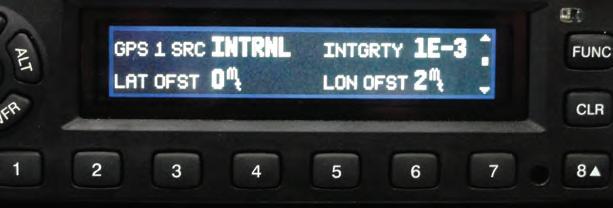
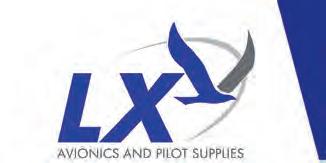



SkyEcho II ADS-B transmitter at Sil 1. ADS-B, Flarm, UAT receiver. Carry on and connect with Wi-FI to display traffic on SkyDemon, Runway HD, EASY VFR, Foreflight, Airmate. From £479.00 Inc. VAT. £239.50 with CAA claim!

ADS-B, Mode C/S, Flarm receive and Flarm transmit. Needs display. £1500.00 £1362.00 Inc. VAT. £1112.00 with CAA claim!

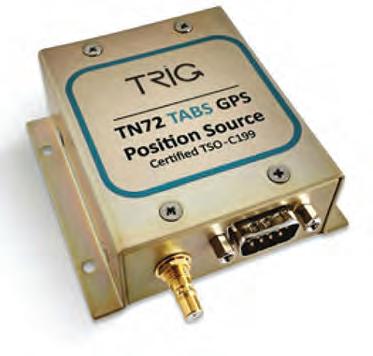

Save 10% off PowerFlarm Core and Portable in addition to CAA contribution on orders placed by 30th November 2020.


TN72 TABS certified GPS for Sil 1 ADS-B out from your Trig Mode S Transponder.
£348.00 Inc. VAT, £174.00 with CAA claim!

ADS-B, Mode C/S, Flarm receive and Flarm transmit, with inbuilt display. £2220.00 £2016.00 Inc. VAT. £1766.00 with CAA claim! Trig


Garmin GTX335* £2754.00 Inc. VAT £2504.00 with CAA Claim!
*GTX335 is currently under promotion, and includes GA35 WAAS antenna for ADS-B out, worth £280.00.

Very few people in the UK will have heard of a Heath Parasol, let alone seen one.
There have been two registered in the UK, but since they ceased flying many years ago even LAA’s files on them are contained in buff folders with carbon copy flimsy paper now brown-tinged with age. The aircraft is a single-seat parasol monoplane similar to the Luton Minor and Corben Baby Ace, but its construction has a steel fuselage of bolted tube, rather than the more usual welded construction and a wooden wing.
This US design goes back to 1926, although Ed Heath set up his first aviation company in Chicago in 1913. The Parasol was designed by Heath and Claire Linstead and the prototype used a set of lower wings from a ThomasMorse Scout. This technique of borrowing bits and pieces from existing aircraft was used by many amateur aircraft builders in the 1920s and 1930s, not only in the USA but also in the UK, for example, the Blake Bluetit and the Martin Monoplane. The engine for the original Heath Parasol was a converted Henderson motorcycle unit.
It became a great success due to publicity in various magazines, and a series of articles on how to build one in Popular Aviation (now Flying), which started in December 1930. The aircraft could be bought complete or as a set of drawings, and Heath also turned it into the first kit-built
aircraft in the world – without an engine it sold for just under $200. You could also buy various sections piecemeal, meaning the cost could be spread over time.
There are a few examples in existence in the USA, though it has never had the following that Bernie Pietenpol’s Aircamper has had in the post-WWII period. For more information about the Heath visit http:// jimforeman.com/Stories/heath.htm. The Heath company name still exists in the DIY area with Heathkits, who have for decades sold electronics kits.
The aircraft featured in this article became G-AFZE and was first registered to Robert Parker on the 23 August 1939 – unfortunate timing for any new project as it would not fly before all civil flying ceased at the outbreak of WWII.
The correspondence we hold at LAA on this aircraft gives an insight into the emergence of our Association as a body that has been intimately involved in the airworthiness of the UKs fleet of amateur constructed aircraft from very humble beginnings. It must be remembered that over the time covered by this article, the Engineering function was a task taken on by qualified individuals working as volunteers in their spare time.
This aircraft’s origins are not exactly clear but it came to light at the time that the Flea era of the 1930s was drawing to an end as a result of its widely publicised fatal
accidents. A company called Puttnam Aircraft was formed in March 1936 in Hornsey, North London with Stephen Appleby as its Technical Director. Stephen was a leading figure in the Flea movement and flew Flea G-ADMH across the Channel in December 1935. One of the first projects of Puttnam Aircraft was to offer their factory premises for amateurs to build their own Flying Flea.
The company did not last long and was put up for sale in August 1936, due to the ill health of Stephen Appleby, who returned to live in France but came back to the UK in 1938, when he joined De Havillands. The advertised sale of the factory for £1,000 included: ‘A practically complete new design, strut braced orthodox control monoplane and five Fleas, plus staff and equipment’. It is thought that this ‘new design’ was Robert Parker’s Heath, with the construction number P.A. 1. It is this construction number that has led to the link between ‘FZE and Puttnam Aircraft, though the Fleas they built had serials PAC 1 to PAC 5. However, it could have been a new project and the P.A. in the construction number could have been for Parker Aircraft, but at this time we have no further information, so the link is a little tenuous.
After the outbreak of war, nothing is known about ‘FZE until the registration was cancelled in December 1946 by the Secretary of State in the clear out of lots of dead wood registrations in the immediate post-war period. At the time, the Ultra-Light Aircraft Association was being formed by Ron Clegg, eventually becoming the PFA and now LAA. Robert’s project was revived through the embryonic association, and a letter was sent by Ron Clegg to the Air Registration Board (ARB, now the CAA) requesting clarification on what evidence was required to allow the Heath to fly in the UK.
At the time, the authorities seemed determined to kill off any repeat of the Flying Flea mania, and decided that new homebuilt aircraft were not going to be allowed post-war. The only concession was an allowance that aircraft having flown pre-war could be given permission to fly – thus the only route initially to fly ultra-light aircraft was to buy a Comper Swift, Aeronca 100 or, as Arthur Ord-Hume explained in his articles in Light Aviation and his delightful book On Home Made Wings, to buy a pre-war Luton Minor and rebuild it, often with very little surviving of the original.
Heath ‘Parasol’ was not issued with a Permit to Fly by the Air Ministry and therefore is outside of the terms and reference, and in any case what little knowledge we have of the Heath ‘Parasol’ leads us to think that it was not a satisfactory type of aeroplane in that the stall characteristic left very much to be desired, and you will no doubt recall that the designer, Mr Heath, was killed when one of his aircraft broke in the air, but it may well be that the one he was killed on was of a type other than the ‘Parasol’. In the circumstances I regret I cannot agree to recommend the issue of a Permit to Fly.
Yours faithfully…

Not to be put off, Robert Parker re-registered his project as G-AFZE in November 1948, and at the same time, the ULAA received a letter from the ARB noting that there were two Heaths in existence in the UK, G-AJCK being the other one. They state that as the ULAA are presumably keen on assisting both aircraft to fly, are they satisfied that the current engine / airframe combinations are satisfactory, and are they prepared to take responsibility to nominate a test pilot.
It thus appears that negotiations had gone on since the original letter to give some hope that they could after all be cleared for flight.
Built from scratch
G-AJCK, this second Parasol, was being built from scratch by the South Hants Ultra-Light Aircraft Club at Christchurch, whose members were in the industry, i.e. Airspeed and BOAC
Airspeed was at this time effectively controlled by De Havillands, though it was not fully integrated until June 1951. It is possible that Sir Geoffrey De Havilland, who was a member of the ULAA, put in a good word with the authorities and, as it was being built by ‘professionals’ they let it through, which was fortuitous for Robert Parker and the ULAA. At this time, ‘JCK was not that advanced and seems ultimately to have eventually been cleared directly with the ARB rather than via the ULAA.
Maurice Imray, the Hon. Sec of ULAA, confirmed to the ARB that the centre of gravity of Robert Parker’s ‘FZE had been checked and that Mr C Debenham had been nominated as its test pilot. At the time, the aircraft was fitted with a Blackburn Tomtit inverted V-twin engine.
It was most important to have this pre-war link, however tenuous, but the problem with the Heath was that whilst registered, it had never flown pre-war, nor had any of the type in the UK. However, ULAA decided it should be considered, given that the design had been successful pre-war in the USA, and a letter was duly sent to the ARB.
Four days later, a letter came from the ARB quoting their letter of the 5 May and stating: As you know, the
A subsequent visit by the ARB surveyor to inspect the aircraft at Elstree noted four defects and stated that they were not completely satisfied with the centre of gravity position, and thus it was suggested that Robert Parker should bring the required calculations with him to a further meeting, which Robert suggested to be the following Saturday.
The ARB curtly replied that they did not do inspections at a weekend, and they were greatly concerned over the mud on the floor of the hangar that prevented a proper inspection! However, eventually, on 7 January 1949, a letter was received from the Ministry of Civil Aviation (MCA) enclosing permission for test flights to verify the engine/ airframe combination. The first flight took place
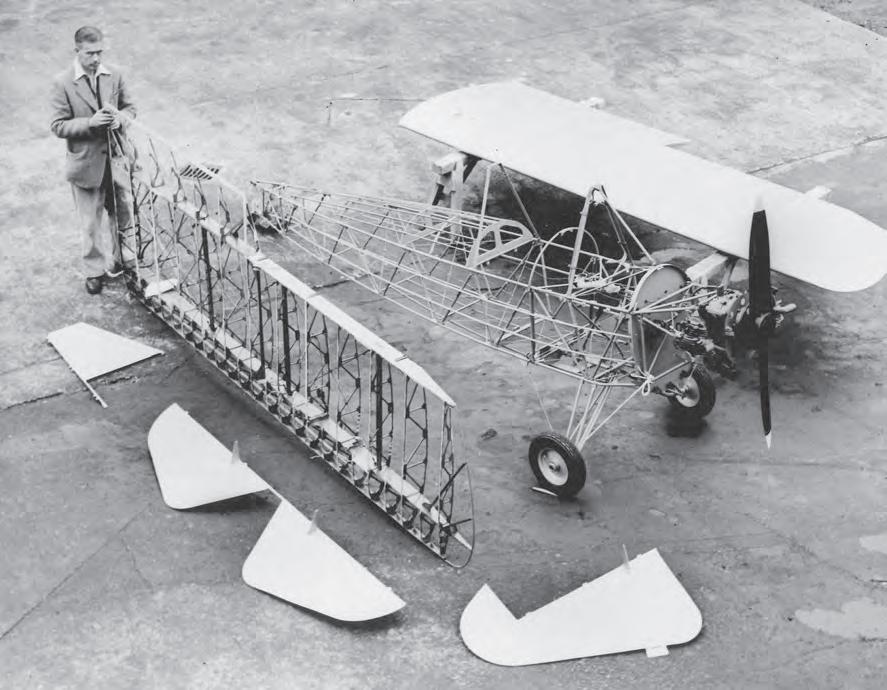
on the 9 January, followed by a second on the 16th. Pictures
Left is the flight test report submitted by Mr C Debenham on 20 January 1949.

An eye witness view of these flights, from Arthur’s book On Home made Wings, gives an idea of the precarious nature of these flights, which may well have ended up in the reservoir at the end of the runway at Elstree today, but fortunately it had not then been constructed.
The test pilot’s report is not so negative, but the ARB, in a letter, had uncomplimentary observations on its performance and stated that the aircraft should not fly or be sponsored by ULAA. They did, however, allow the ULAA to continue if they were prepared to make a firm recommendation for a further Test Permit.
A further letter from ARB on 24 January 1949 relating to the other Heath Parasol, G-AJCK, stated that its construction was a ‘first class job’. Its original engine, a twocylinder ABC Scorpion, had proved unsatisfactory when test flown by Airspeed’s Chief Test Pilot, Ron Clear and the ARB letter stated that the South Hants group were proposing to re-engine it with a JAP J99. The ARB further confirmed that ‘FZE was unsatisfactory with its Tomtit engine but that if trials with the JAP J99 in ‘JCK proved satisfactory, then that might be a way forward for ‘FZE. They advised waiting for the outcome of the ‘JCK trials. Maurice Imray for the ULAA, accepted their conclusions and stated that ULAA sponsorship of the design would be discussed at a forthcoming meeting in the light of the test pilot’s report.
We’ll conclude this vintage tale next


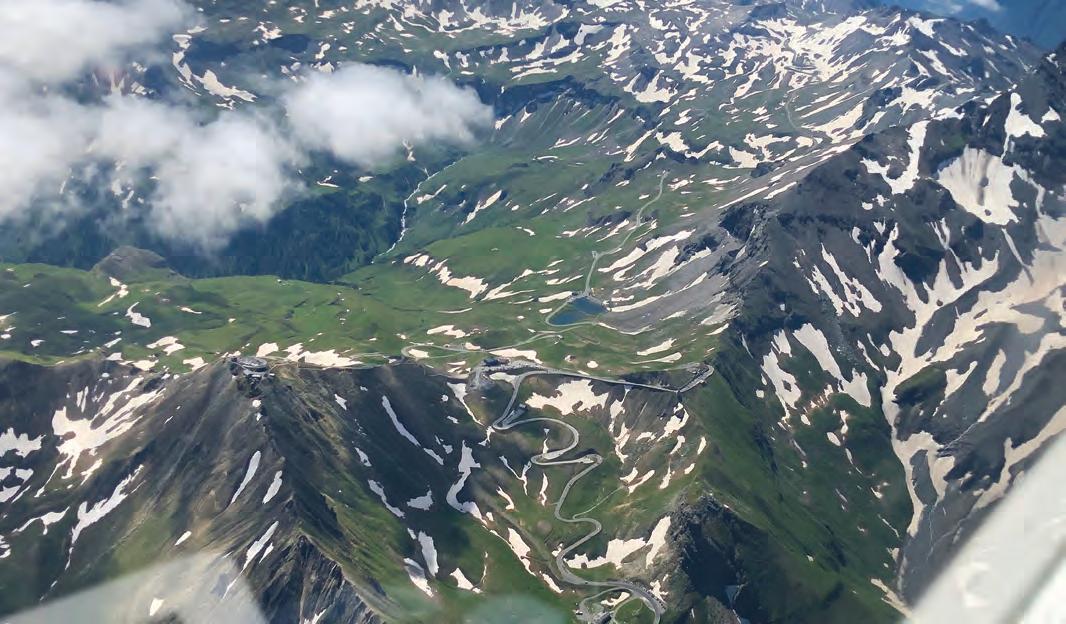
Kerry Skyring reports on the post-pandemic challenge – to drive and fly Austria’s tallest mountain – with a Kitfox and a Morgan…
Readers may recall the tale of Australian Kerry Skyring, resident in Austria, who flew his Kitfox to the 2019 Rally and won the Most Meritorious Flight award (November 2019). So, seeking a challenge in these most of unusual of circumstances, he decided to fly, and drive, Austria’s tallest mountain – the Großglockner. Kerry takes up his story.
A spring of cancelled trips and fly-ins due to COVID-19, led firstly to a bout of frustration, followed by obsessive hiking in the Vienna Woods. As lockdown dragged on towards summer those walks went deeper and deeper into the green hills, but creative inspiration eluded me. Each day I returned without a waltz or even a single tale from those woods. Another COVID-19 escape strategy was needed.
In mid-May Austrian aviators were again allowed to exercise their wings, and at the same time travel by ground-bound vehicles was also given the green light. But HOW to make the most of these freedoms was the conundrum. Around that time my flying buddy, Martin Hirczy, mentioned his failed attempt to fly over the Großglockner. His choice of aeroplane was probably not ideal – the not very powerful Motorfalke. A lack of thrust,
along with cloud obscuring the pass, forced his retreat from the snowy heights.
Martin has flown many hours with me in the Kitfox including a test flight to establish the service ceiling, so he knew running out of puff before the summit would not be an issue. We agreed to tackle the ‘Big Bell’ in the Kitfox as soon as work and weather provided the necessary window.
The following week, during a conversation with motoring mates, isolation-busting plan number two was born. Why not drive Austria’s highest Alpine pass as well as fly it? There were four of us, all Morgan owners, whose plans to drive to the Le Mans Classic race meeting in France this summer had been stymied by COVID-19 restrictions.
To drive the route of the historic GrossglocknerHochalpenstrasse would provide some compensation.
Maps were consulted, cars were serviced, and partners pacified. As with the flying attempt, weather would determine the dates – there’s no point viewing dramatic Alpine scenery from the inside of a cloud. Our first ground assault, scheduled for early July, coincided with poor conditions and so was abandoned, leaving the aerial reconnaissance in pole position.
The Grossglockner, literally Big Bell, at 12,461ft (3,798 metres) is Austria’s highest mountain. By comparison, Europe’s tallest mountain, Mont Blanc in France, is 4,810m. The historic ‘high Alpine road’ passes to the east of the peak, climbing to 8,215 ft (2,504m) via the Hochtor Pass, linking the provinces of Salzburg and Carinthia. Proposed in the 1920s as a scenic toll road and job creation project, the idea was ridiculed by many. However, completed in 1935 it was an immediate success and traffic, mostly motorcycles at first, began rolling over those cobblestones, which had been laid with such care and toil. Today the road attracts tourists from all over the world who pay a hefty toll to drive its sweeping curves.
Perfect weather window
Sunday 5 July brought perfect flying weather to all of central Europe, so we seized the opportunity and at 0930 the Kitfox lifted off from our base at Stockerau, 30km north-west of Vienna.
With full fuel (100L) we were about 30kg under MTOM with nearly 2.5 hours flying ahead of us to reach the start of the historic Hochalpenstrasse. At about 7,000ft we followed the east-west passes through the main Alpine range, the peaks in this area varying from around 6,000 to 8,000ft. The higher terrain, including the Grossglockner, lies further to the west so we delayed our climb to 10,000ft until approaching Zell am Zee. Some of you will be familiar with this lakeside tourist town and its popular airfield.
The original plan had been to land at Zell, drink coffee, breathe deeply of the mountain air, then we would take off, climbing in the valley to attain 10,000ft before heading south into the pass, which would take us past the peak.
However, approaching Zell we were already at 10,000ft, and quite comfortable, and could see no point in throwing away 7,500ft only to scale those heights again. A call to Wien Information advised them we were changing the flight plan and would now land at Lienz-Nickelsdorf (LOKL) on the southern side of the Alps, about 20km from the Italian border. This was accepted as a diversion and we began to focus on finding the correct valley to enter. It was important to get this right as there are two north-south routes across the Alps in this area, a modern one to the west of the Grossglockner peak and the historic route, the one we wanted to follow, to the east. There are also several valleys which, like the sirens of Greek mythology, will lure aviators into their beautiful interiors but fail to provide an exit.
Martin was an aircraft accident investigator in a previous life and reckoned that Greek sailors could blame
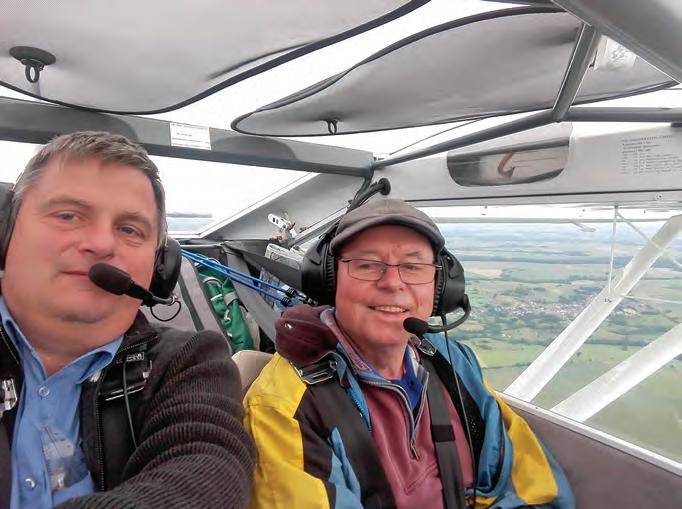

their shipwrecks on sirens. However this excuse would not read well for us if we became an ‘accident report’. After a little probing we found the siren-free valley, stoked the Rotax fire, and began a steady climb towards the peak.
The weather was as suitable as it could be, little wind, quite warm on the ground but pleasant at altitude, with downy clouds draped across the higher peaks. Bliss. But as the altimeter edged past 12,000ft the atmosphere in the cockpit lacked not just oxygen but composure as well. There were several reasons. About 15 minutes earlier, before turning south, the Rotax had given a little cough. Not a dry, virus-style cough,
more like a polite little attention grabbing ‘ahem’. Martin raised an eyebrow. I raised my best sangfroid. A few minutes later there was another little clearing of the Rotax throat. I explained to Martin that the motor had done this on a previous trip to the mountains and this was ‘just a little ice’ being swallowed… We talked about it. The 912 ULS installation in the Kitfox keeps the motor nice and cool in the summer but just a little too cool in winter. The carburettors at the rear of the motor rely on warm air gathering there to keep ice at bay – there is no separate carburettor heat system. In winter, I partially cover the oil cooler and coolant radiator with aluminium tape, raising
the under-cowl temps sufficiently for carb ice not to have been a problem in 300 hours of flying. But on this summer day at 10,000ft, with clouds forming over the peaks, we experienced excellent icing conditions while providing insufficient heat under the cowls. The solution was to climb harder using lower airspeeds and a higher power setting to generate sufficient heat to melt the ice. Obviously, this has its limitations as sooner or later one has to descend, but it solved the problem on this flight. A better solution is being investigated…
Also introducing edginess into the cockpit was the confined route we were forced to fly. Austria created a special bird sanctuary (within the High Tauern National Park) around the peak in 1986 and, although we had wings, the Kitfox does not appear on any list of protected species. Only in a narrow corridor of airspace above the winding 1930s-built road could we mix it with bearded vultures and golden eagles.
But where was the road? Raising the nose and power levels to keep temperatures elevated meant limiting
forward visibility. Can you see it? You must be able to see it! Of course, it was right there directly under us and some gentle turns revealed those looping curves, like a draper’s carefully folded cloth, a legacy left by men from our great-grandfathers’ era who, with picks and shovels and sticks of dynamite, laboured through searing summers and withering winters. It took them five years to build Europe’s highest alpine road and, when they were done, well, they weren’t! In the winter of 1935, the first after the opening of the road, 350 men picked up their shovels and tossed aside 350,000 cubic metres of snow to keep one lane open. Talk about bleeding blisters.
Last year around 900,000 people crossed the Alps via this employment project of the depression era.
Nature’s grand cathedral
Meanwhile, back in the Kitfox, euphoria replaced edginess. Who could fly through nature’s grand cathedral and not experience some sort of tingling? Hang on, could we be confusing religious ecstasy with hypoxia? Actually, we were both quite
cool – and not just because the Kitfox has no heater. As best as we could judge, we’d not experienced any oxygen deficiency symptoms. We’d been at 10,000ft for about 30 minutes, climbed to a maximum altitude of 12,216ft for an unrecorded number of minutes – maybe five – and then begun our descent into the valley of the Drau on the southern side of the Grossglockner, enjoying the long gradual descending turns between steep valley walls to achieve a circuit height of 2,000ft. I plonked the aeroplane down without finesse (OK, I bounced) on Lienz’ short tarmac strip and we broke out the stale sandwiches and warm ‘iced’ coffee. After filling the tanks and taking a short rest, we were off again, debating, and finally agreeing, on the best alpine passes to take us home to Stockerau. At the end of the day our flying time was had logged at 5.5 hours, but our living and learning time was immeasurable.
Ten days later, four old Morgans drove the Hochalpenstrasse over the Grossglockner. Starting in Vienna, the trip took three days and covered 1,000 non-autobahn km. But that’s another story!
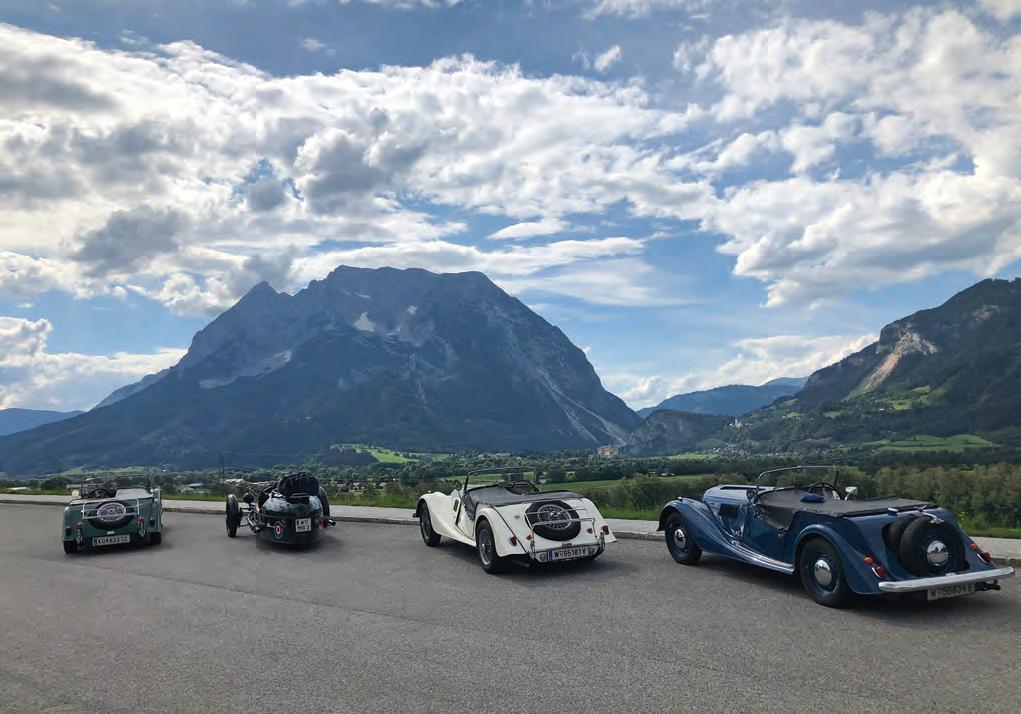
The first to flight over the Alps took place on 28 September 1910 by French-Peruvian pilot Jorge Chávez Dartnell, who launched his Bleriot from
Brig in Switzerland and crash landed at Dormodossola in Italy, 51 minutes later.
He collected the large cash prize, for which he was competing, but sadly died
four days later from injuries suffered in the crash.
It’s reported his last words were ‘higher, ever higher’…


provides

The FLYER Club was created by pilots for pilots and its goal is to bring like-minded people closer together.
For many members, it's a social thing, others enjoy the free landing fee vouchers, some like the advice and info webinars we've started organising, and some like the exclusive discounts. As the FLYER Club community grows, it will become more useful, more valuable, more fun and have more opportunities to join in.
Whatever your reason might be for joining The FLYER Club, we would love to have you on board!
 Ed Hicks Editor - FLYER Magazine
Ed Hicks Editor - FLYER Magazine

COVID-19 concerns are all encompassing for everyone. David Cockburn, PCS Head of Training, looks at continuing to fly safely…

However much I’d like to avoid the subject, it seems that COVID-19, with its consequent Government restrictions, is going to be with us for some time yet. Not only have many projected relaxations been discarded, we are seeing a growing number of localities being given additional restrictions, and have been warned that similar, or more stringent, restrictions may be implemented nationally.
I fear that, even though we can hope to avoid the return to the lockdown which prevented all but absolute essential flying in the spring, we ought to be prepared for the possibility, and I hope most of you were able to take advantage of the good weather in the past few months to reach an adequate level of currency.
The CAA has produced exemptions to allow pilots to maintain their licence rating privileges during the restrictions, and I hope these have allowed you to keep flying.
However, I know of several pilots who were approaching the end of their rating validities and were planning on obtaining the necessary hours and flights with instructors at just the time that became impossible. While being a few hours short has been assisted by ORS4 Nos 16 and 18, that has not helped everyone.
Not that that ought to be a massive hindrance to maintaining licence privileges; a proficiency check with an examiner is not something to be feared, and if a pilot feels he isn’t ready for such a check, our Coaches are able and willing to brush up one’s skills beforehand.
I should also point out that, even though one can fly legally, that does not mean one can necessarily fly safely! For example, it is quite possible for a PPL holder to fly legally when he or she has not handled the controls for the previous 35 months. And after three successful (?) take-offs and landings on their own, they can carry passengers!
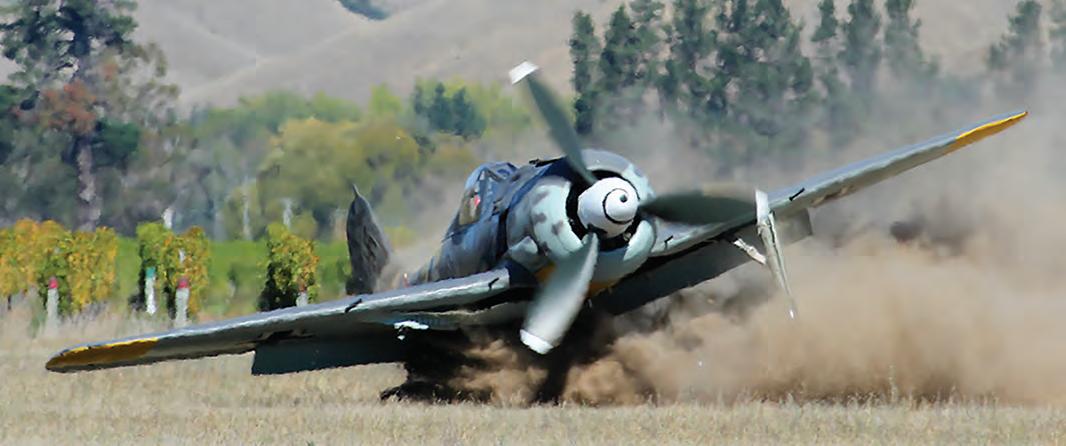
Sadly, the late summer has seen several minor accidents, and not a few airspace infringements. Were these the result of pilots being less able to cope with demanding situations than they thought they were?
Although I do not have definitive investigation reports to hand, I certainly believe that to have been the cause of several of these incidents and accidents. When we are less current than usual, not only do our handling skills fade, but our reactions slow and our inflight decision-making process becomes less efficient. If pilots are getting less flying than usual, and this applies to instructors as well, safety margins reduce.
Can we increase these safety margins, even though we are less current than usual? Well, probably not. However, if we avoid flying in challenging situations when we are less current than usual, we stand a chance of maintaining an adequate level of safety. Be more ready to avoid potential trouble, whether it be a forecast of a marginal cloudbase, a crosswind close to our own perceived limits, a fuel load close to minimum required, or any of the thousand and one possible ‘gotchas’ which we routinely cope with as pilots. It is better to be ‘down here’ wishing one were ‘up there’, than the other way around!
And why not use the services of a Coach to brush up your skills and knowledge before you challenge yourself? We should not think of a ‘flight with an instructor’ as an unfortunate necessity, but as an opportunity to hone our skills and either learn something new or refresh what we may have forgotten. Look on the LAA website under ‘Find a Coach’ and take advantage of the experience available. However, in these troubled times some Coaches may be unwilling or unable to travel or fly, so keep trying.
Unfortunately, not everyone believes that a flight with an instructor can be of benefit. I quote from an email I received concerning the required flight with an instructor for rating revalidation. “I will never understand why this nonsense was ever brought in as it isn’t in any way instructional, but life is full of having to live with pointless regulations.”
That pilot is probably speaking from experience, and that really concerns me. If pilots want to use the services of an instructor, whether a LAA Coach or otherwise, they are entitled to value for money. While items are recommended for inclusion in revalidation flights, the instruction should be tailored to the pilot’s needs, and Instructors should try to identify what these are, brief accordingly, and provide guidance during the flight and post-flight debrief.
Mind you, it may not always be the instructor’s fault if
Above This is the time you realise that perhaps you should have had a refresher on your crosswind landing technique…
a flight offers little value. The pilot is paying for the service (even if only the fuel for the flight) so should offer some guidance to the instructor. You may be confident you can carry out the exercises listed in the CAA’s TrainingCom (see https://skywise.caa.co.uk/), but what skill, manoeuvre or radio procedure do you not usually practice on your own? What problem do you hope you never encounter, and what skill do you hope you will never need to exercise for real? The instructor is not there to assess your capabilities but to help you improve, so talk beforehand and give him or her the chance to prepare a suitable flight and brief you on the items you want to include.
Members are frequently confused by the various different regulations to which our variety of pilot licences are subject. Despite the expertise which I am rumoured to possess, I must admit to misunderstanding them myself on several occasions. I discovered one such case recently, so to avoid others being under the same misapprehension, I thought I should clarify that particular situation.
The LAA arranges with the CAA to give all Coaches ‘R examiner’ privileges in order to sign rating revalidation pages on licences. However, those privileges are confined to ratings on UK licences such as the UK PPL and NPPL. The privileges arranged by the LAA do not apply to EASA licences, so our R examiners are not able to use that qualification to sign rating revalidation pages on EU licences.
Nevertheless, many Coaches have their own privileges as listed monthly in the relevant sections of CAP 1585. In addition, all Coaches should also have ‘FCL.945 privileges’, which allows them to sign rating revalidations on EU licences if they have just completed the mandatory instructional flying for revalidation by experience as the final requirement for that revalidation.
Of course, if all UK issued EU licences become UK licences on 31 December, the situation should become a lot simpler!
Not everyone may be aware that the CAA recently issued and updated ORS4 No 1421 to replace No 1370.
This effectively allows pilots with a UK issued PART-FCL PPL or LAPL to continue to exercise LAPL privileges (only) in G registered EASA aircraft in UK airspace without the appropriate Medical Certificate, provided they have made a valid Medical Declaration to the CAA and not withdrawn it.
Details are on the CAA website, and the exemption expires on 31 March 2021. ■
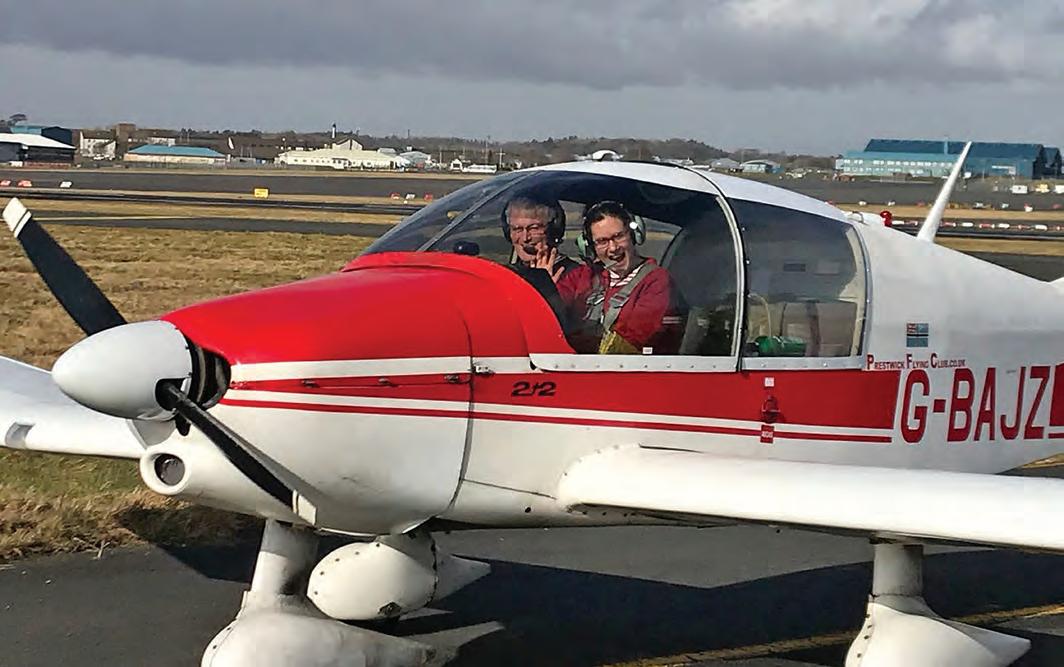
After a lifetime of longing to become a pilot, despite weather, unserviceable aircraft and COVID-19, Gillian Boston achieved her goal this summer and obtained her PPL…
Ever since I was wee I always wanted to fly. I grew up in Prestwick, Scotland, and spent most weekends at the end of the runway with my dad and brother, marvelling at the different types of aircraft and waving at the pilots. My mantra was ‘when I grow up I want to be a pilot’!
There used to be fantastic airshows held at Prestwick Airport each year, and best of all was when Concorde came up for annual training. It was hard to beat the feeling of standing on the small railway bridge beside the caravan park watching Concorde take off from Runway 30, and literally seeing it accelerate right in front of my eyes.
Throughout secondary school, my passion for aviation continued, so much so that I’d always get told off during physics lessons for watching aircraft out of the classroom window. I thought it was brilliant that I could see the runway from the classroom – my physics teacher was not so enthusiastic…
By the time I went to university, British Aerospace had brought its flying school to Prestwick, but alas it wasn’t to be for me. My dreams of becoming a commercial pilot
Above Gillian embarks on her lifelong ambition in the Prestwick Flying Club’s Robin DR400.
Top right Scotland is a great place to fly. Here we are at Glenforsa, Isle of Mull.
Right Returning from her third attempt at the QXC – the weather played ball.
were shattered when I found out that I had a serious eye condition which, even with corrective surgery, would mean I could never attain a Class 1 Medical. I must, however, stress that I am well within the limits of my Class 2 Medical!
With my hopes of a flying career dashed, I headed to the bright lights of London and pursued a career in finance and latterly, in technology, which also took me overseas. But my enthusiasm for flying never waned. I would always find my way on to the flight deck when flying home for a visit or going on holiday. One of my most memorable experiences was coming into land at Heathrow in the jump seat of a British Airways Airbus, and hearing Concorde directly behind us on final.
Fast forward and after many years away, I took the decision to move back to Ayrshire. I was so happy and excited when my husband got me an air experience flight at Prestwick Flying Club as a Christmas present during our first year in our new home. You shouldn’t be surprised to hear that my home is under the departures and arrivals flightpath of Prestwick Airport.
Never

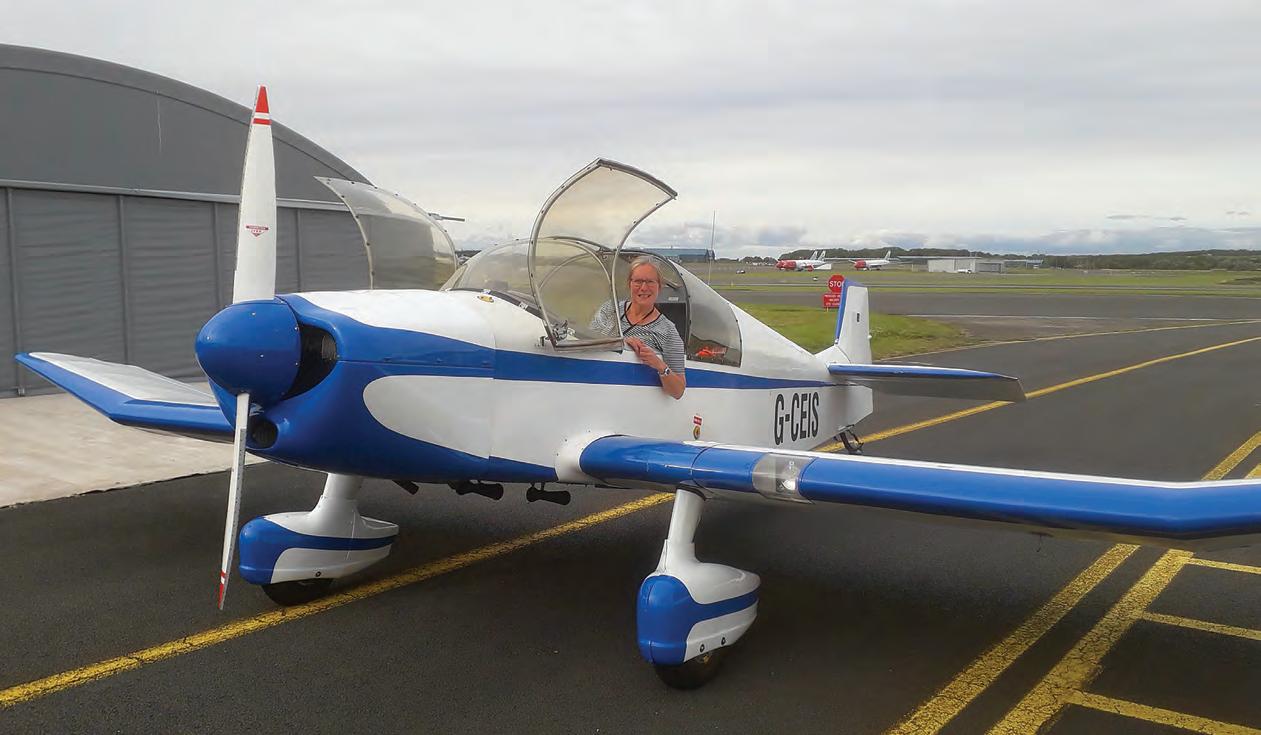
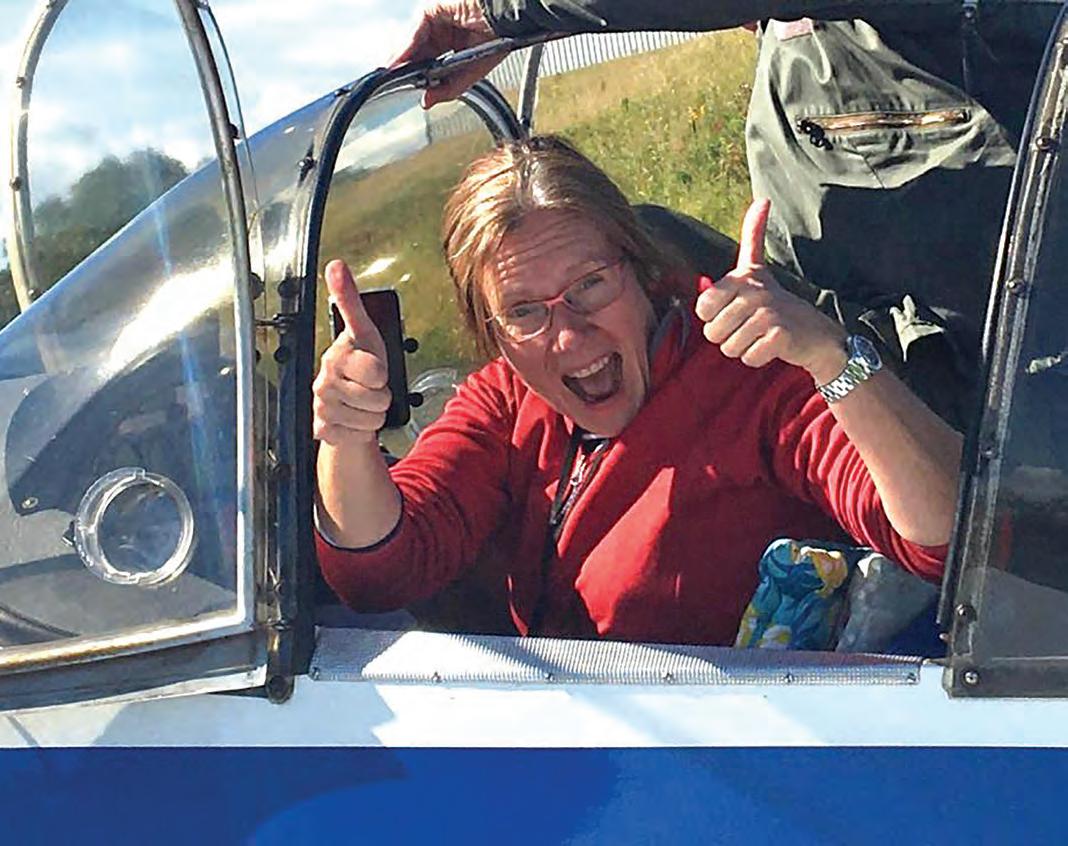
At the time I was travelling a lot with work, so it wasn’t until a beautiful sunny day in October 2016, with stunning views out towards the Isle of Arran and Ailsa Craig, that I took to the skies. Within that hour’s flight I was hooked –in fact it probably only took about five minutes! My PPL course books were purchased, whizz wheel at the ready, my instructor assigned, and my lessons started in a Robin DR400.
Now I must confess to be a bit of a perfectionist and I generally don’t do things by halves, so imagine my utter joy when I learned of the aviation career of my instructor. Fighter pilot, fighter pilot instructor, test pilot, test pilot instructor, commercial pilot – you name it, he’s flown it. I am so privileged to have learned from such an experienced aviator, or the ‘Boss’ as I call him. There are very, very few people who can say that from a standing start they’ve reached 45,000ft in three minutes. His stories are truly amazing!
Weather at Prestwick Airport can be amazing, but it can also be rather temperamental too, with low hanging cloud, challenging crosswinds and strong gusts.
However, undeterred I would venture to the flying club every weekend whether it was to fly, seek advice or blether about flying. Soon the hours started to add up, as did the number of take- offs and landings in the circuit, until that fateful day, in November 2017 ,when my instructor turned to me and said, “Would you like a go yourself?”. My immediate response was, “Are you sure?”, which we laugh about today. The stars were aligned that
November day, as the weather was perfect and I did my first solo flight. I was absolutely delighted when ATC congratulated me after I landed.
At this point I do have to mention my second solo flight. I had completed my pre-flight checks and was holding for Runway 30, as a C-17 took off right in front of me. Wow! We are very lucky at Prestwick to experience such sights, which have recently included the Antonov An-225 and the Red Arrows.
Am I the only person who really enjoyed doing circuits? There is something very satisfying about circuits, especially solo circuits when what initially seemed a rushed and difficult exercise, becomes smooth and well executed. And so my training continued. The standing joke was that if you flew your heading you really did get to your destination, as if it was a magic trick. Navigation was going well and the land aways were approaching, but unfortunately so too was a change in the weather. Attention turned to the exams and in October 2018 two other students from the club and I headed to Cumbernauld Airport for a week-long intensive course. Hard work but a good laugh too, and we all passed.
Winter storms came, but luckily so too did some beautiful clear, crisp days and in December 2018, I had two attempts at my qualifying cross-country (QXC). On the first attempt I flew to Cumbernauld and landed, but unfortunately I had to return to Prestwick due to a cloud
base that had no intention of rising. Similarly, on my second attempt I reached Carlisle, and then en route to Cumbernauld I had to make the decision to return to Prestwick as the low lying fog that was forecast to lift had decided to stay put at Cumbernauld. Two great experiences though, as I learned a lot from both flights, despite not being able to complete my QXC.
The Robin then departed for annual maintenance and the fitting of a new engine. While it was away, I did my radio licence, in anticipation of completing my QXC as soon as it was back. Unfortunately, work on the Robin took longer than anticipated and after a gap of over six months of no flying, I was persuaded to join the Tail Wheel Group. The syndicate bought a Jodel DR1050 in April 2018, and I had already taken up the position of treasurer so that I could have firsthand experience of how a group-owned Permit aircraft was operated. The primary intention of the group was to have an aircraft that students could transition to, post-PPL, as well as provide the opportunity for GA pilots to fly a tailwheel aircraft.
And so my tailwheel training started in the autumn of 2019. A very different aircraft to the Robin on the ground, during take-off and landing, but it otherwise handles pretty much the same in the air.
Landings were the hardest to master, however, once I was truly looking all the way down the runway, not giving the stick back and making sure I had ‘happy feet’ on the rudder, things started to fall into place. The biggest lesson of all was that the flight in a tailwheel aircraft doesn’t end until the engine has been closed down. I made my dad’s day by going solo for the first time in the Jodel on his birthday!
Once again, I found myself ready for my QXC, but alas COVID-19 arrived and another gap in flying of over six months followed. It wasn’t until towards the end of July 2020 that I was back in the Jodel, having put together an action plan with my instructor to get my PPL before my exams expired. First up was the QXC. Actually, that’s not entirely true – first up was remembering how to take off and land after so many months of not flying! Again a valuable lesson in the importance of keeping current.
This time I had to go to Perth, as Carlisle was closed. On leaving Cumbernauld, I had a lovely flight over Kincardine Bridge to Kinross and onwards to Perth. It was a bit of a surprise the first time I went to Perth though, as there were so many light aircraft in the circuit at any one time and no ATC, as I had always been used to at Prestwick. Nevertheless another great learning experience on the importance of clear radio calls and diligent lookout.
Having attempted my QXC twice before, I was blessed with the most glorious day, the visibility was fantastic, winds were light and I was determined that this was going to be ‘third time lucky’. Having landed and got my form signed at both Cumbernauld and Perth, there was one more leg to complete. I was feeling chuffed with my overhead join at Perth, as there were already three aircraft in the circuit with myself and another aircraft approaching. I just had to phone and tell my instructor that there had been five in the circuit.
I then flew from Perth back to Prestwick via Crieff, Drymen, Dunoon and Rothesay. The views were spectacular – I was surrounded by lochs, mountains and islands. I distinctly remember flying over Helensburgh with Dunoon and Rothesay in clear sight and relaxing just
that little bit, knowing that I was nearly there with my QXC What happened next can only be described as intense – revision ahead of my flight skills test. Having had two large gaps in my training, I had to revise what felt like the whole syllabus. Thankfully my instructor was available when the weather was good, and with the end in sight we pushed on to get me ‘test-ready’. At the end of August, I flew with our Chief Flying Instructor who put me through my paces and cleared me for test. I completed my PPL training on my mum’s birthday, and the next day sat my flight skills test.
What surprised me was how much I enjoyed the test. I was very thankful to my ‘ground crew’ who kindly opened up the hangar and got the Jodel out for me. Meanwhile, I was sitting in the clubhouse with my examiner waiting for the weather to improve. The cloud was a bit stubborn that morning but it was the right decision to wait as the cloud lifted so much so that by the time we returned to Prestwick we were in glorious sunshine.
Having completed the nav and diversion, followed by general handling, we returned to the airfield for circuits. I have to add that I did my best ever steep turn that day as I hit my slipstream on the way round.
Unbeknown to me at the time, my parents were in their back garden in Prestwick as I was doing my circuits. They described to me that they’d seen me do ‘two high ones and a low one’, which was exactly right as they’d seen me do a high glide, approach without the airbrake and a bad weather circuit.
Even after we landed there were still exam questions to answer and scenarios to talk through. I was, however, adamant that having taxied to the apron that we didn’t just park up. I made sure we continued to the fuel bowser and refuelled the Jodel as someone was flying after me.
And so, after just shy of four years from my first air experience flight, I am now a very proud PPL holder. I received first-class tuition and I can’t thank my instructor enough for his patience and guidance. His words of encouragement will always be with me, in particular ‘keep coming down, keeping coming down’ when on final! I am incredibly lucky that we will continue to fly together. Grass landings are next.
The support from Prestwick Flying Club was, and continues to be, fantastic. I have had the opportunity to fly in different types of aircraft including aerobatics in a Bulldog, formation flying, visiting the stunning airfield at Glenforsa on the Isle of Mull and flying over the peaks of the Isle of Arran. I’m now learning how to undertake maintenance on the Jodel – I can change the oil on my aeroplane, but not on my car!
Our chairman reliably informed me that I am the first woman in at least three decades to complete her PPL at the Prestwick flying Club, which is very sad, I think. My message to anyone who is thinking about wanting to learn to fly, or who is part way through their course is go for it and never give up. If you surround yourself with a great bunch of people, and have the passion and resilience to keep going, then you will succeed.
The final words have to be from my instructor. He has always said to me that a PPL is a licence to learn, and I very much look forward to consolidating and building on my experience, learning new routes and visiting new airfields over the coming years. ■
www.prestwickflyingclub.co.uk

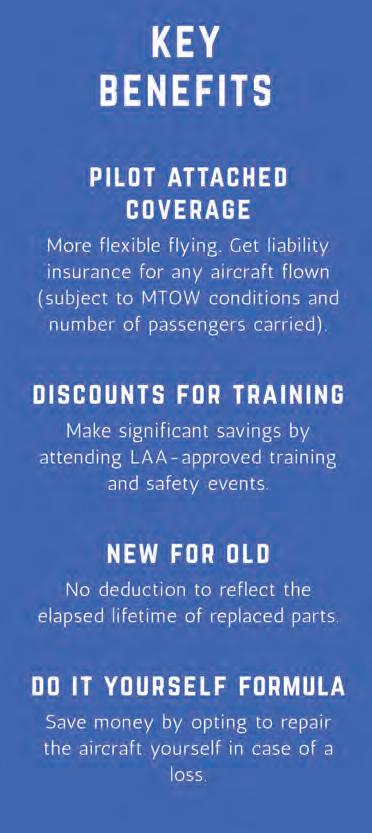




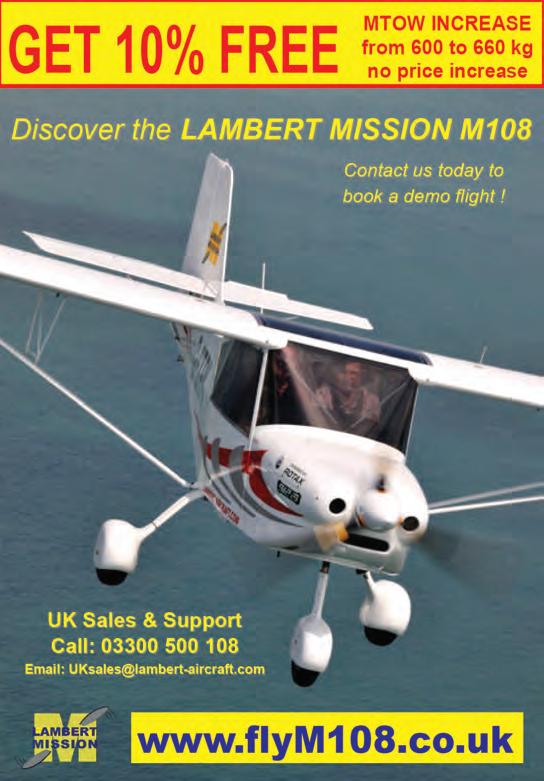




Over the last few months the Struts and LAA member clubs have found new ways of keeping in regular contact, and shown the resilience we have come to expect among LAA members! We asked some of the club and Strut leaders to send us their thoughts on the subject of ‘Strut Lockdown Challenges’ and were pleased to see that many positives have come out of this shared experience. We will publish a few of their comments over the winter months as an encouragement to us all, as we make our way towards the spring and, hopefully, a return to something more like normality.
“Roll the clock back to March. The lockdown was enforced, so, after driving to the airfield on our own, and keeping our distance from fellow pilots, we thought we would self-isolate at 2,000 and 2,500ft. However, our challenges began from this point as the airfields were closed down and we were unable to fly!
“Later, thanks to the CAA, we thought we would get half-an-hour a month in for engine health flights, but the airfields remained locked down and nothing happened for far longer than we had anticipated. When we found our permits were expiring, a backlog of permit inspections fell on our inspectors, resulting in a huge workload for LAA Engineering. After a long time out of the air, we finally began to fly again to discover the truth about perishable skills. How good it was to be among the clouds again and, back on the ground, how good it was to be with our fellow aviators!
“From a Strut management perspective, just prior to lockdown we were challenged with the dilemma of whether or not to cancel the monthly Strut meeting but went ahead with it anyway, and subsequently came the challenge of embracing Zoom for our meetings. Has all this made us stronger and more capable? Probably. Let’s make the most of what we have and the privilege of flight and, with the baton in one

hand and a stinging nettle firmly grasped in the other, move on to the blue skies of the future.” David Millin (Devon Strut).
“Unlike most LAA Struts, the UK Pietenpol Club was initially formed as an LAA Affiliated Club in January 2003 as a builder’s self-help group but, with more and more projects coming on the LAA Permit register, it has evolved into a healthy following of enthusiasts of the type. As well as a strong UK base, the Club now has members worldwide ranging from the USA, Canada, throughout Europe and in both Australia and New Zealand.
“The current pandemic has obviously curtailed most, if not all, of our social activities and fly-ins across our international membership. However, through our group email system, website and Facebook page, members are still able to remain in touch with each other, discussing the technical problems of building this plans-built type, originally designed in 1933, to a modern standard.
“On the positive side of things, with the enforced lockdowns and people having to remain at home, builders
have had the opportunity to press on with their projects, making best use of the extra time. Presently in the UK, there are 40 aircraft on the register, although not all currently have a Permit to Fly, with a further 50-plus projects registered with the LAA as ‘in-build’. For more information, visit www. pietenpolclub.uk or www.facebook.com/ukpietenpolclub” Peter Wright.
“Despite the Covid restrictions the Suffolk Coastal Strut has kept itself alive via monthly Zoom meetings, with chairman Mick Gill hosting the presentations booked and organised by Martyn Steggalls. Hot air ballooning, Electric aircraft racing, and Weather for pilots are just three of the excellent addresses our guest speakers have covered.
“With the continuing problems of ‘physical meetings’ probably extending towards next spring, the Strut committee has decided to continue with these Zoom sessions. Martyn is in the process of arranging the speakers for the New Year,
Twhile Mr Chair ‘Quizmaster’ Mick, is preparing our annual Christmas Quiz. Although lacking in drink, nibbles, personal contact and the Chairman’s ‘ritual heckling’, I’m sure drinks and nibbles WON’T be lacking – it’s just that this year members will have to provide their own!
“Every effort is being made to make the appropriate bookings for the 2021 flying season – hopefully without major restrictions. Fly-Ins (Boxted, Rougham etc.), BBQs and other events are being planned, we just hope we can see them all happening. Please watch both ‘this space’ and our website for confirmation of times, dates etc. for speakers and topics (Zoomed) to our 2021 diary.”
Thank you to everyone who has contributed to our ‘Strut Lockdown Challenge’. If you would like to share your thoughts and haven’t already done so, please send some words and photos. Next time we will hear from The Aeronca Club, the Vale of York Strut and more!
hroughout the next few months some Struts will be organising ‘virtual’ Strut meetings.
You can stay in touch with your local group using the details below and you are welcome to contact any Strut
Andover Strut: Spitfire Club, Popham Airfield, SO21 3BD. 1930. Contact keith. picton@ntlworld.com
Bristol Strut: BAWA Club, Filton, 1930. Room 4 or by Zoom. Contact chairman@ bristolstrut.uk www.bristolstrut.uk
3 November – Flying around Australia, by Fiona and Angus Macaskill
Cornwall Strut: The Clubhouse, Bodmin Airfield. Contact: Pete White pete@aeronca.co.uk / 01752 406660
Devon Strut: The Exeter Court Hotel, Kennford, Exeter. 1930. Contact : david. millin@sea-sea.com
East of Scotland Strut: Harrow Hotel, Dalkeith. 2000. Contact:inrgibson001@ btinternet.com / 0131 339 2351
East Midlands Strut: Please contact: tonyrazzell2@gmail.com for meeting details a few days before hand or to be added to our email circulation to get details automatically. We also have a Facebook group and upload recordings of meetings where we have speakers.
9 November: Back to the Skies – Pup Prototype restoration by Anne Hughes and David Collings – Illustrated Zoom talk.
Gloster Strut: The Flying Shack, Gloucestershire Airport 1930. Contact: harry.hopkins@talktalk.net
Highlands & Islands: Highland Aviation, Inverness Airport. Contact: b.w.spence@ btinternet.com / 01381 620535
Kent Strut: Cobtree Manor Golf Club, Maidstone, Kent. 2000. Contact: Brian Hope bfjjodel@talktalk.net / 01795 662508
LiNSY Trent Valley Strut: Trent Valley Gliding Club, Kirton Lindsey. pilotbarry1951@gmail. com http://linsystrut.wixsite.com/website
to see if you can be ‘linked in’ to their presentations, if numbers permit.
Please keep in touch and send your news and views to me at struts@laa.uk.com
North East Strut: Fishburn Airfield. Brunch on the third Sunday of each month. 1130-1330 at Fishburn Aviator Cafe. Contact: alannixon297@btinternet.com
North Western Strut: Veterans Lounge, Barton, Manchester, 1930 for 2000. Contact: cliffmort@btinternet.com / 07813 497427
North Wales Strut: Caernarfon Airport, Dinas Dinlle. HEMS Bistro Café 1300.
Contact: Gareth Roberts gtrwales@gmail.com / 07876 483414
Oxford Group: The Duke of Marlborough, Woodleys, Woodstock, Oxford, 2000. (second Wednesday each month).
Contact: LAAOxford@gmail.com www. oxfordlaa.co.uk
11 November – Electric Propulsion – The Future for Light Aviation. Zoom talk by Nick Sills. Email for joining details.
Redhill Strut: The Dog and Duck, Outwood, Surrey, RH1 5QU. Third Tuesday of each month at 1930. Contact: david@milstead.me.uk
Shobdon Strut: Hotspur Café, Shobdon Airfield, Hereford HR6 9NR. 1930. Meetings (once lockdown completed) second Thursday of month. Contact: Keith Taylor bushebiggles@sky.com
Southern Strut: The Swiss Cottage, Shoreham-by-Sea. 2000. Normal meetings are on the first Wednesday of the month. Contact: palmersfarm@sky.com
Strathtay Strut: Scottish Aero Club, Perth Airport, Scone. Scone Clubhouse. Contact: keith.boardman@peopleserve.co.uk / 07785 244146
Suffolk Coastal Strut: Crowfield Airfield Clubhouse. 1900. Contact: Martyn Steggalls events@suffolkcoastalstrut.org.uk / 07790 925142
18 Nov 1930 Virtual meeting over Zoom. Airspace Infringements by Rob Gratton. 16 Dec 1930 Virtual meeting over Zoom. Chairman’s Christmas Quiz and Nibbles – although this year the Quiz is virtual and members will have to provide their own Nibbles!
Vale of York Strut: Chocks Away Café, Rufforth East Airfield.
Thursday 17 November – 1930 Meeting over Zoom: Flying Safely. Contact: Chris Holliday 07860 787801 valeofyorkstrutlaa@ gmail.com www.valeofyorkstrutlaa. wordpress.com
Wessex Strut: Henstridge Airfield Clubhouse. Contact: neil.wilson@laa.uk.com No club meeting until further notice. November – Zoom Strut AGM TBA. West Midlands Strut: Navigator Café, Halfpenny Green Aerodrome 1930. No meetings until 2021. Contact: Graham Wiley westmidlandslaastrut@googlegroups. com or Stuart Darby st uartdarby134@ hotmail.com . or visit our website wmstrut. co.uk
West of Scotland Strut: Bowfield Country Club, Howwood, PA9 1DZ. 1900. Contact: Neil Geddes barnbethnkg@gmail.com / 01505 612493
Youth & Education Support (YES) Contact: Stewart Luck captainluck@ hotmail.com
NB: A huge thank you to all Strut coordinators and newsletter editors for keeping up to date with the continuous flow of information. You can contact me at struts@laa.uk.com
Anne Hughes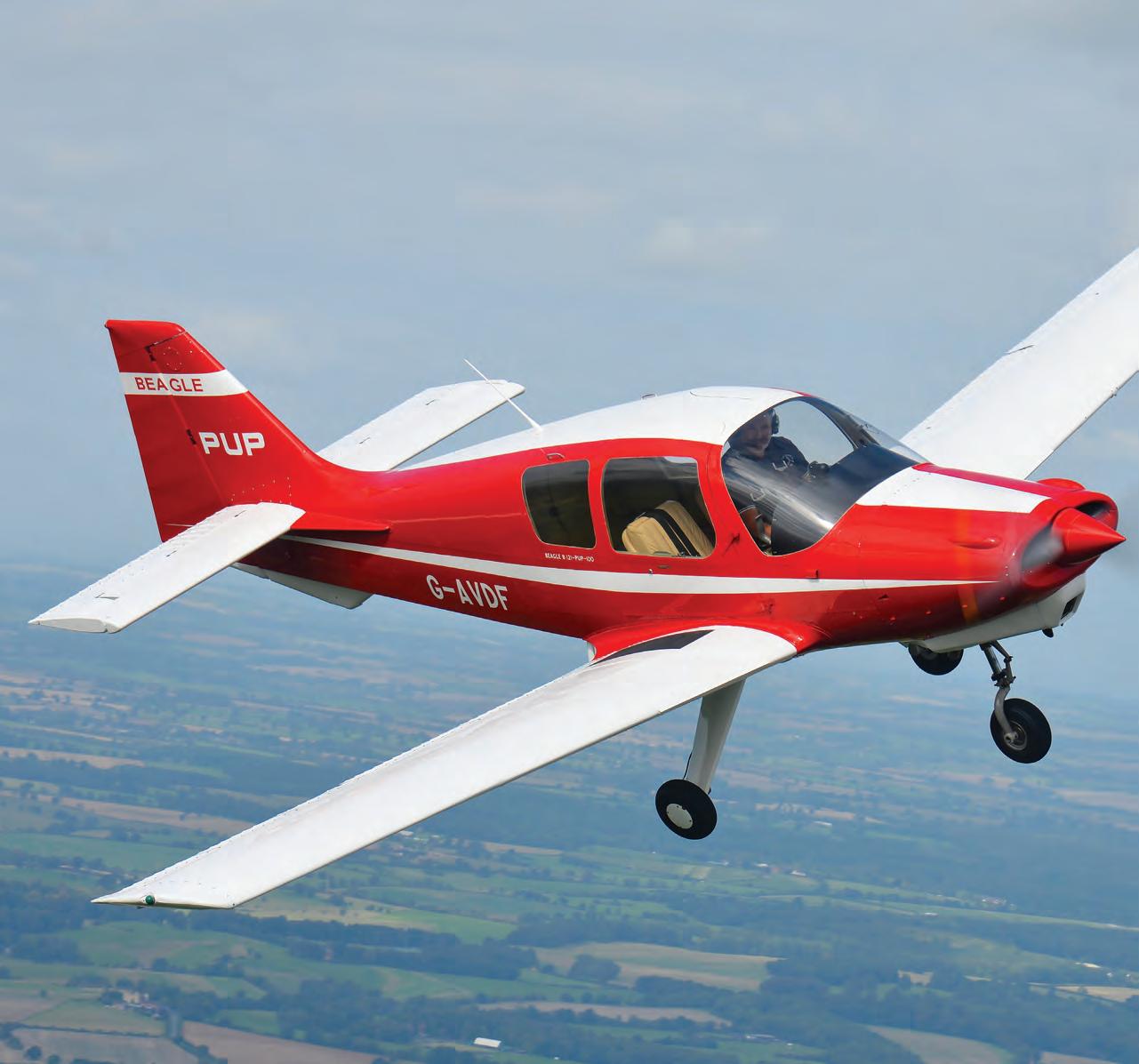
After completing the test flying of the recently rebuilt prototype Beagle Pup, LAA Chief Engineer Francis Donaldson tells the story…
Pictures Neil Wilson

For anyone interested in the history of aviation, access to the LAA’s visitor lounge at Turweston is an as yet little-known bonus of LAA membership – a comfortable place to sit and chat with like-minded enthusiasts or to immerse yourself in the wealth of reading matter on display. Looking out across the airfield, the lounge is decked out from floor to ceiling with aviation books and memorabilia. Back issues of aviation magazines stand boxed in orderly rows, stretching back to the immediate post-war era. Sadly, this great archive has stood largely unseen and unused through most of 2020 because of the office being closed to visitors due to COVID-19 precautions, and like so many of our assets at present, awaits better times.
If you should leaf through the aeronautical back issues from the mid-to-late 1960s, as I did recently, it’s striking that the Beagle Pup keeps popping up month after month. Recurring news items and reviews bubble over with enthusiasm and excitement about its imminent availability, and then the actual introduction of this genuinely modern British light trainer.
Writers positively purr at the prospect of Britain being poised to challenge the influx of US built Cessnas and Pipers with our own aircraft of all-metal construction and elegant appearance. At last there would be something that would be a step change in advance of the fabric covered Austers and recycled left-over Tiger Moths that were pretty much all that British manufacturers were turning out at the time for the civil market. As befits a ‘proper’ trainer, Beagle’s Pup would be aerobatic, with sticks rather than yokes, and like the American imports, a flat-four engine and a steerable nosewheel. The joining forces of long-experienced Rearsby folk from Auster with the remains of Miles’ equally proud design team, under the ‘Beagle’ flag, backed by the Pressed Steel Co, seemed to imply that the Shoreham-based firm would be not only bursting with expertise but, unusually amongst light aircraft enterprises, not perpetually strapped for cash.
The handling of the Pup and its modern looks created rave reviews, the price was very competitive, and the order books apparently soon filled. At a time when the military aircraft side were still recoiling after the judgement that manned aircraft would soon be replaced by missiles, the cancellation of TSR2, and embarrassment over the escalating development costs of Concorde, the Pup was one of the few good news stories of that time, and the press went to town on it.
First flying in 1967, Beagle went on to build 175 Pups in the next two years, either as the two-seater Pup 100 version with a 100hp Continental 0-200A engine, or as the four seat Pup 150 with a 150 horse Lycoming 0-320 – the airframes of both versions largely being the same. In the field, the Pups were generally a great success and sold well – pilots loved them. As with any new type, they had their teething troubles, and the lower powered two-seater became known for a less than
enthusiastic rate of climb on just a hundred horsepower, especially as the McCauley metal propeller was pitched more to benefit the cruise figures than the field performance.
The downfall of the Pup, sadly, was that famously, as time went on it became ever more clear that any realistic sales price was well below the cost of building a Pup, so Beagle was losing money on every aircraft sold. The curvaceous fuselage, with its double-curvature skins, cost a packet more to build than the more crudely shaped competition, and the fitting of the huge curved, shell-like cabin doors and proper adjustment of the slam-close door catches was a nightmare on production, and in maintenance.
The melding of one design and production team out of the mortal remains of two previously competing companies had not gone altogether smoothly, even under the leadership of Chief Designer John Larroucau. Optimised designs are usually the product of a single dominant controlling mind –and perhaps one outcome of this was that the Pup undoubtedly contained more parts than it might have done. It’s lever-action oil-damped oleo-sprung main undercarriage, perhaps inspired by the similar arrangement on Auster’s bush-flying AOP9, may have helped cushion the more careless of student landings. But when you compare it with the simple maintenance-free cantilever leaf spring legs on Cessna’s 150/152 or on the later Piper Tomahawk, Beagle’s arrangement added to the complexity and parts count – and created more of a maintenance burden. It’s not unusual to see a parked Pup seemingly dragging its tail or ‘one wing-low’ because the undercarriage seals are leaking and the oleos need pumping back up.
The Pup was also to have an automotive-style arrangement of cabin heat and demist controls, operated by sliders on the instrument panel. The airbox containing the flap valves that controlled the air temperature and its destination was connected to the engine exhaust heat muff and the cold air source by Scat hoses, and to the slider controls by push-pull cables that must naturally have needed adjustment and inspection from time to time. But Beagle chose to locate the heater box not in easy reach on the front of the firewall, but behind it, above the rudder pedal assembly and only reachable, as far as I can see, by removing the instrument panel – you get my drift. If a student were to report that the hot air didn’t seem to be working, checking whether one of the Scat hoses had come off would surely be quite a major job.
While some of the design choices may have been a little awkward, Beagle’s structural design appears beyond reproach and very nicely detailed. Years later I was lucky enough to work with ex-Auster Chief Designer ‘Dickie’ Bird, who after designing the Auster Agricola crop sprayer had played a large part in bringing together the Beagle design team on the Basset project, before moving on to work for Britten-Norman on the Islander. For a few months this hugely experienced but unassuming man worked with us as a design consultant at Old Sarum. I clearly remember Dickie impressing on us youthful engineers that ‘it doesn’t matter how low the stress levels are, if a thing is badly designed, in the end it will drop off’. This succinct lesson in the evils of the


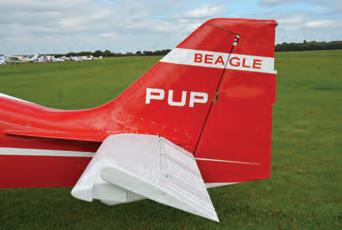


stress concentration was very apt, and certainly the details of the Pup’s structure, brainchild of the Beagle drawing office, reflected all that was classical ‘best practice’ in sheet metal airframes of that time.
Beagle’s original backers, Pressed Steel, had pulled out of Beagle after it became clear that the twin-engined B.206 Basset, on which Beagle had pinned their hopes as a replacement for the RAF’s ageing Ansons, was a commercial failure – the RAF preferring de Havilland’s Dove. Seeing a full order book for the new Pup, the Government stepped in to save Beagle, which effectively became a nationalised company in 1968. When it turned out that even with the Pup production in full swing it was losing money, the only hope on the horizon seemed to be the Bulldog which was being developed – basically the Pup reconfigured with a 200hp Lycoming engine, a constant speed propeller and a sliding bubble canopy. To compensate for the increased weight, the wingspan was to be extended by adding a centre section between modified Pup outer panels.
Unfortunate end
History has shown how difficult it is to survive financially by making civil light aircraft, unless sustained by more lucrative military contracts. No doubt recognising this, Beagle planned the Bulldog with an eye to the imminent need for a replacement for the 200-odd Chipmunks then in service with the RAF, as well as export opportunities for military trainers for a variety of foreign air forces. Sadly though, although the prototype flew in May 1969, and 70 Bulldogs were ordered by foreign air forces ‘off the drawing board’, it was doubtful that the price that had been negotiated for these was enough to cover their costs. The financial plug was pulled in December 1969 when the Government failed to respond to the company’s latest plea for further funding, and Beagle were forced to call in the receivers.
This setback spelled the end of the line for Pup series production. Although a dozen or so were completed piecemeal afterward under the receiver’s watchful eye, the many remaining part-built fuselages went for scrap. Of Beagle’s designs, the receiver only managed to sell the Bulldog project which went to Scottish Aviation at Prestwick, which successfully put the type into production. Scottish Aviation fulfilled the original orders from various foreign air forces, and in 1972, its investment in the Bulldog finally paid off when it contracted to sell over 130 Bulldogs to our own RAF, at roughly twice Beagle’s quoted selling price. Further orders were received from abroad, and when the last was completed in 1982, more than 300 Bulldogs had been built.
Happily, the Pup’s bloodline didn’t entirely peter out at this point. Imitation is the sincerest form of flattery, they say, and few would question that the Trago-Mills SAH-1, and its production derivative, the Sprint, which were produced in the early 1990s, bear more than a few marks of the illustrious Beagle predecessor. Syd Holloway, who designed and
Top left Superb ailerons encouraged pilots to enjoy the handling!
Left The incredibly large doors – what’s holding the fuselage together!
Mid-upper left Complex undercarriage added to maintenance and production costs.
Mid-lower Left The empennage is generously proportioned, unfortunately the original short chord rudder has been lost.
Bottom left Over 50 years since it first flew, the Pup remains a handsome piece of work.
largely single-handedly built the prototype SAH-1, was certainly a Pup fan, for aeromodellers may remember Syd’s amazing quarter scale model of the Pup built in the 1970s from rivetted sheet aluminium, just like the full-size. At a lecture given to the Royal Aeronautical Society that I attended in the late 1980s, we heard from co-designer Frank Robertson about the genesis of the SAH-1, which shared very similar proportions and aerodynamics to the sweet-handling Pup but with the emphasis this time on creating a design that would be straightforward to build and to maintain. Gone was the oleo sprung undercarriage, replaced by Cessna-like spring leafs, and gone were the big cabin doors, in favour of a fixed windscreen and rearward-sliding canopy. Gone too were the double-curved fuselage skins, replaced by a clever combo of flat-wrap panels that greatly simplified production.
Excitingly, the plot continues to unfold with plans afoot to relaunch the Sprint with new and thoroughly modern powerplant options. Will this allow this son-of-Pup to show its true mettle at last? Who knows, but as long as people want to learn to fly, there’ll surely be a need for a good basic and aerobatic trainer. But I digress…
My first experience of the Pup was in the late 1980s when I was lucky enough to be part of a large group owning Pup 100 G-AXNM, after force of circumstances had led to the majority of the other group owners being dispersed. For one glorious summer, the Pup was ‘there for the use of’, and my logbook records that quite a lot of avgas was burned that flying season, taking friends for joyrides, honing my tyro aerobatic skills and generally keeping her shipshape until the situation was resolved. ‘November Mike’ was always under a bit of a cloud because she had failed to meet the scheduled climb performance figure during the three yearly CofA renewal check flight, and her future relied rather perilously on a generous ‘writing down’ of her climb rate from the CAA Flight Department. With hindsight I expect that very few Pup 100s did climb to the book figures!
Eventually November Mike was sold to the flying club at Old Sarum and remained available, although now on an hourly rate, and later still, went into private ownership, and was eventually sold into Germany. I sometimes regret not buying her myself, but I suspect the maintenance costs of the now ageing airframe would have been crippling on a full CofA. Even now, G-registered Pups fly on an EASA CofA, because unlike the ex-military Bulldogs on the civil register, they’re not eligible for an LAA Permit.
This issue’s flight test is the first prototype Pup, G-AVDF, the very same machine that features in so many of those 1960s’ magazine cuttings. Hand-built as a B.121 Series 1 Pup 100, using quite basic jigs, Beagle’s flight-by-flight documentation shows ‘DF’ being used to fine-tune the control harmony, engine cooling, plus other practicalities in the hands of Beagle’s flight test department, led by Chief Test Pilot ‘Pee Wee’ Judge whose name features heavily as P1 throughout.
The records reveal the lengths that the team went to to get

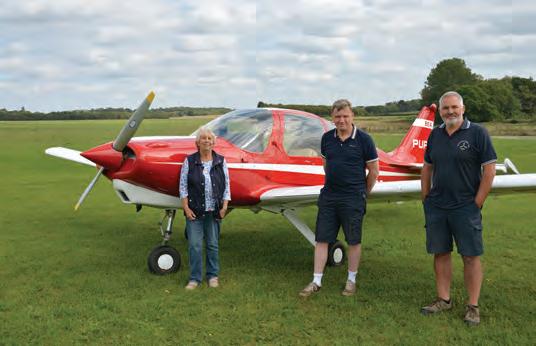

Above The interior and panel looks typically prototype, the niceties came later. Note substantial hinges.
Left (Left right) Anne Hughes and owner David Collings, both instrumental in the restoration, and Turweston Flying Club’s Paul Shenton who kindly flew her for the photo sortie.
Below ‘DF is finished exactly as she was when she first left the Shoreham factory.
the best out of the configuration. A moment of drama pops up among the rather dry notes about climb and cruise data with different propellers, after ‘Pee Wee’ commented on the unnecessarily high cockpit scuttle on the prototype blocking some of the forward view. Typically test-pilot succinct, Judge relates a distinctly close encounter with another aircraft on a reciprocal course which, in murky weather, had passed by a few feet underneath the Pup, unseen until it had been too late to do anything about it.
As the photos show, Beagle has taken this aspect to heart and maximised the forward view, even wrapping the upper engine cowl so tightly around the cylinders that they’ve had to add streamlined bulges to house the uppermost spark plugs and their HT leads – with an aircraft like this every inch saved here makes a worthwhile difference to the forward view.
‘DF first flew in April 1967, and appeared just a month later at the Paris Air Show. It flew extensively as a development tool and demonstrator until other production examples were available to take its place. In 1969 the prototype saw a second lease of life when it was used to trial a Lycoming IO-360 installation as part of the development of the Bulldog, first flying in that form on 1 April of that year. To help the structure of the Pup cope with an engine of twice the original power, the cabin doorway apertures were partly plated over to reinforce the fuselage. Whether this powerplant swap was done to check the performance that it would yield seems doubtful, as ‘firewall aft’ the airframe would not be representative of the Bulldog. I suspect it was maybe more to do with sorting out the detail design of the engine installation and developing the cooling arrangements while they were working up the prototype Bulldog airframe.
After the Bulldog project moved up to Prestwick, ‘DF remained at Shoreham, where both it and the prototype B.206 formed the basis of a small aviation museum. By 1990, the prospects for the future of the two prototypes seemed bleak but fortunately, Sir Peter Masefield, who had been responsible for the creation of Beagle in the first place, begged a favour from a haulage contractor friend and managed to get both aircraft roaded to Brooklands.
In 1993, ‘DF’s airframe, by now looking distinctly shabby, was spotted by Pup enthusiast David Collings, who managed to buy her with the aim of putting her back in the air. Reality stepped in however, when the difficulties of restoring the aircraft to a Certificate of Airworthiness became apparent. On closer scrutiny, it was found that the hand-built prototype differed from the production version, so David couldn’t replace the various crucial parts that had gone missing with standard Pup parts – they wouldn’t fit. Furthermore, the aircraft had spent most of its former short flying life operating on company ‘B conditions’ for test and demonstration use only, so EASA would likely look pretty askance at the idea of issuing a CofA all these years later.
The upshot was that it was not until 2015 that David, Anne Hughes and others of the Vintage Aircraft Club, formed a team around the aircraft and set to with the restoration. Pivotal to this was their successful application to the LAA to get CAA
permission for the aircraft to be dealt with as an LAA project to qualify for a Permit to Fly, rather than having to be cleared through the CAA and EASA, like all the other G-registered Pups. This application was accepted on the basis of the unique nature of the prototype airframe and non-conformity with the standard Pup’s configuration standard.
The restoration involved transplanting several major components from a derelict donor Pup, which created interesting challenges in matching them up. A particular problem was that the link plates which attach the outer wings to the fuselage had been lost at some stage. Of course, the numerous bolt holes on standard link plates didn’t quite match up to the holes on the hand-built prototype. None of the original drawings had survived, and new plates had to be specially made to suit, to the necessary close tolerances and with careful attention to the material specifications and heat treatment.
An overhauled Continental 0-200 was obtained, just like that originally fitted, so with the decision to return her to first flight configuration the ugly fuselage reinforcing plates that had partly blocked off the cabin door aperture were removed. Standard Pup 100 cowlings and engine mount fortunately fitted OK, but other elements of the engine installation differed in detail, requiring all the reverse engineering skills of Turweston-based ATCO Engineering’s Alan Turney, Simon Owen and others to resolve.
Looking at the photos, Pup aficionados will notice that the original narrow-chord rudder fitted to the prototype back in 1967 has been replaced with the wider, tapered Pup rudder of the type that became standardised across the range after trials with the prototype Pup 150, the second Pup to fly. ‘DF had acquired the wide chord rudder by 1969 when it flew with the 200hp engine, and the fate of the original rudder is unknown.
Other features that differ externally are the orientation of the noseleg scissors which for some reason, so far undetermined, project in front of the leg on ‘DF but sit behind it in all subsequent Pups and Bulldogs. Also noteworthy are the machined cabin door hinges, considerably beefier than the hinges used on the production Pups, and perhaps part of the reason why the door fit and latch adjustment were problematic on the production builds. If so, then it wouldn’t be the first time that a bit of penny-pinching at the productionising stage led to escalating costs in maintenance, and surely it won’t be the last either. As ever, the devil is in the detail.
I was lucky enough to be invited to participate in the flight testing after DF’s rebuild, along with Turweston Flying Club co-owner and master pilot, Paul Shenton. The aircraft’s first flight after 51 years was carried out shortly after the end of the COVID-19 full lockdown, in May of 2020, while still in primer. After shaking down the inevitable snags, Paul took the aeroplane to Sturgate for the spraying of the gorgeous scarlet paint job which replicates as far as possible exactly the same scheme she wore in 1967.
Looking into the cockpit, ‘DF is bereft of a headlining and all trim panels – there’s no indication that they were ever fitted to the prototype, which seems to have remained untrimmed throughout its two year flying career. The pilot is greeted by a
unique view of the naked inside of the cabin structure, the patchwork of shades of zinc chromated aluminium having a charm all its own.
You enter the Pup by way of a steel tube step that projects down to the rear of the wing trailing edge and a handgrip mounted over the rear window, allowing you to step onto the gritty black wing root walkway. The positioning of the step seems not quite right on the prototype, so it’s a bit awkward – if you’re tall it’s easier to get straight up onto the wing root. The front-hinged doors really are huge – when you open them the apertures take up the whole depth of the fuselage sides so one wonders what holds the front and back of the fuselage together. The door hinges are quite close together so it’s particularly important not to use the doors to hang on to as you step aboard, or they could distort.
The cabin of the Pup 100 is spacious and airy, with a large area of Perspex around the front and a huge baggage bay behind – being, after all, the space where the third and fourth seats are accommodated in the bigger-engined Pup 150 model. Whoever designed the Pup’s cockpit knew what they were doing, for the combination of seating position, curved sticks, and adjustable pedals seems just right with everything, as they say, ‘falling to hand’. The rudder pedals, which incorporate conventional toe brakes, are individually adjustable fore and aft, while the seat is fixed.
All the controls are reassuringly chunky, no-nonsense –not exactly military in appearance but thoroughly workmanlike and ‘right’. The throttle is a proper fist-sized lever-type job situated on the centre console, which also mounts the throttle friction lever, the (rather stiff) elevator trim wheel, the trim position indicator and the centre-sprung switch for the electric flaps. The carb heat is worked by a substantial push-pull control at the base of the panel (nothing like the ubiquitous flimsy ‘Mini choke cable’ type often seen on homebuilts), while the starter is by push-button.
The only poor bit of ergonomics, in my view, is the rotary fuel selector valve mounted on the floor in front of the pilot’s seat, which is somewhat ‘out of sight and out of mind’. Happily, there are a pair of permanently displaying fuel quantity gauges on the panel, one for each of the wing tanks, to remind you if you need to reselect your fuel source. But with the fuel selector outside of normal view it wouldn’t be that easy to switch the fuel off in a developing airborne emergency.
Getting these quantity gauges to work has been a challenge on ‘DF, the system being until recently dogged by an intermittent fault that left both gauges on the zero stop. The fuel quantity senders, mounted on each tank, are not too readily accessible and one’s naturally reluctant to keep removing and refitting the flush-mounted wing tanks for fear that they might develop a leak, this being another Pup quirk.
‘DF’s panel is bereft of installed radios at present, pending an 8.33 unit being obtained, so a hand-held connects to an external whip aerial. Instrumentation is analogue and original, instantly recognisable from the layout on our group-owned Pup back in the 1980s.
So how does this, the first of all Pups, behave in the air? Well firstly, with only the basic equipment, no paint and no interior, as Pups go she is light – her empty weight being 1,102lb (max gross is 1,600lb). You notice this when you take off in ‘DF’ because flown solo, she hops off the ground after quite a short run, without that prolonged slow-trundling acceleration that characterises a heavily loaded Pup. She may be noisier in the cockpit because of the lack of padded upholstery, but if so I can’t detect it behind the headset’s ear-hugging attenuation.
Fully loaded for the climb rate test, flying at the recommended 60kt between 1,000-2,000ft ‘DF manages respectably close to the POH figure of 500ft/min. Probably she could do even better with attention to sealing some of the leaks, for in flight one can see daylight past the door seals in some places, even though surprisingly, there’s no draft or whistle associated with them. Not a rate of climb to write home about, in these days of 100hp microlights climbing at more than twice that rate, but then the 0-200 powered Pup is an IFR-capable machine stressed for aerobatics at up to +4.4, -2.2g. It’s also built to last and has a considerably heavier structure, as well as being bigger dimensioned all round than today’s lightweight two seaters, sized around the 1,400cc Rotax engine.
It has to be admitted that the Pup 100 is not fast – with an 85 to 90kt cruise, and perhaps, 100kt ‘flat out’ she would be outpaced by the contemporary four seat Jodel 1050 with the same 0-200 engine. But then again, the 1050 has beautifully spatted undercarriage legs and wheels – and no unfaired noseleg hanging down in the prop slipstream, so the comparison really doesn’t stand scrutiny.
One of the seriously nice features of the Pup are its ailerons, which are a delight. Considering that neither Auster nor Miles’ aircraft had a reputation for crisp or very effective ailerons, it’s great that the collaboration of the two design teams at Beagle’s resulted in an aeroplane with such fine lateral control. Maybe someone had looked closely at the Chipmunk’s ailerons, we’ll never know, but the combination of the Pup’s fully skinned tapered wings and the bottom-hinged Frise ailerons works beautifully, making steep turns and turn reversals a treat. All the more remarkable is that this is achieved with cable-controlled ailerons, not pushrods.
DF’s stall characteristics are also immaculate, the tapered wings strongly resisting tip stalling however brutally they’re pulled into the stall regime. Beagle gave the Pup’s leading edge a distinct downturn that alters the leading edge’s aerofoil profile over the outboard part of each wing. These increase the leading-edge radius and droop the aerofoil’s nose progressively more from mid-span to tip. This cuff-like aerodynamic tweak is undoubtedly in part responsible for the benign high-alpha behaviour and is a very valuable safety feature. A pair of big stall-breaker strips along the inboard wing leading edges surely contribute to ensuring that the
inner part of the wing stalls before the tip. Despite the presence of a goodly natural tail buffet as pre-stall warning, there’s also a vane-type stall warner which operate a light on DF’s panel.
We’ve not tried spinning ‘DF yet, as owner David has decided not to get the aircraft cleared for aerobatics, at least for the present. Production Pups (including our old ‘November Mike’) are reluctant to spin and tend to automatically transition into a spiral dive unless you get the technique just right. There’s a tail ballast weight you can fit to bring the cg back to help get the aircraft to demonstrate a sustained spin – as an aerobatic trainer this would presumably be an important part of the syllabus.
The Pup’s tail surfaces are very generously sized, the fin particularly so with the big rudder and its sub-fin beneath the fuselage. With such a large keel area and anti-spin strakes in front of the tailplane, seemingly the Pup’s design team were determined not to get any trouble with spin recovery! Ironically though, with one particular set of control inputs, there were one or two delayed spin recoveries on Bulldogs, despite the Bulldog sharing all these spin recovery measures.
The big tail surfaces make the aeroplane quite stiff directionally, but nevertheless, the rudder power and fuselage lateral area allow a modest degree of sideslip to be achieved. In pitch, the Pup’s stability and its friction-free control system, aided by a down-spring, make it excellent at holding a trimmed speed by itself, particularly in the approach configuration which must have been a particularly welcome feature for tyro pilots and their instructors during the ‘learning to land’ phase.
In summary, it’s been great to get to fly a Pup again, and particularly, an honour to fly this unique born-again first-of-itskind. After all this time, and after flying many different types since, the Pup’s handling really is as nice as I remembered it, and Pup flying remains a thoroughly satisfying experience.
Hearty congratulations to David and his team for bringing ‘DF so ably back to life to represent the first of this fondly remembered line. ■
General characteristics
Length: 23ft 2in (7.06 m)
Wingspan: 31ft 0in (9.45 m)
Height: 7ft6 in (2.29 m)
Wing area: 119.5 sq ft (11.10 m2)
Aspect ratio: 8.04:1
Empty weight: 1,090lb (494kg)
Max take-off weight:
Fuel capacity: 24 imp gal (29 US gal; 11 L)
Powerplant: 1 ×
Continental 0-200 100hp (75 kW)
Performance
Maximum speed: 127mph (110kt)
Cruise speed: (75% power at 7,000ft) 117mph (101kt)
Stall speed: Flaps up 62mph (54kt)
Stall speed: Flaps down 53mph (47kt)
Never exceed speed: 172mph (149kt)

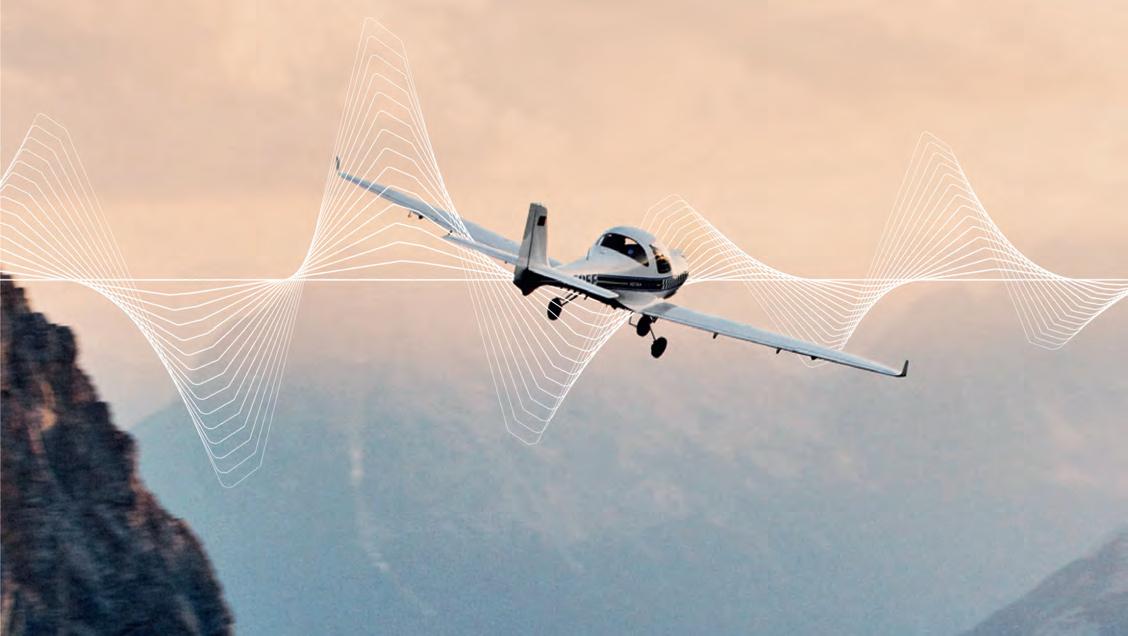

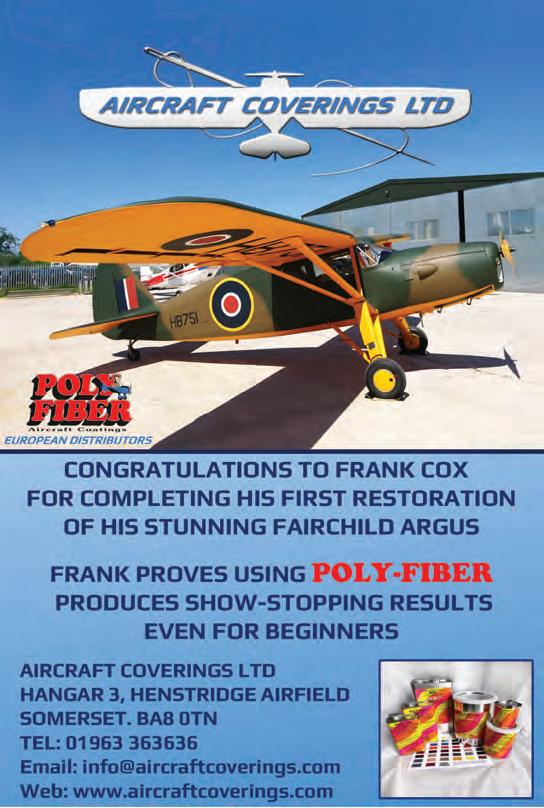



A TV ‘imposter’ led to the uncompleted star of the show languishing in a hangar. She has finally had her day in the spotlight, albeit not in front of television viewers, as Mike Wylde reports…
Longer term members may recall the TV series A Plane is Born (now available on YouTube, or DVD.) Made in 2000, it showed presenter Mark Evans gaining his PPL, building a Europa XS, and ultimately flying it, all in the space of a few months.
Or did it? Well the truth is that there was some artistic licence invoked. Mark certainly got his PPL, worked on building a Europa from a kit and flew a Europa in the final programme of the series, but the hand, especially if it is holding a television camera, is faster than the eye!
The aircraft being built was PFA project number PFA 247-13615 and was registered G-OIZI – the
television production company being called i2i (eye to eye). You saw Mark building, with the late Neville Eyre advising and inspecting, and other colleagues from i2i also got involved. The structure was completed in commendable time, and work started on fitting an engine and instrumentation, but it became clear that the scale of the task meant that completion was way beyond the planned series’ production schedule. We all know the ‘90% done, only another 90% left to do’ syndrome, don’t we? The next episode showed Mark unmasking a painted airframe in a spray booth but – it was not the same one. Indeed, the knowledgeable viewer could spot the engine was a Rotax 914 instead of the 912 ULS seen


earlier – what television people call a ‘continuity error’.
Mark flew this particular aircraft in the final episode, with appropriate decals applied but no registration marks visible. I believe this aircraft went to Europa’s US representative, but I have also heard an alternative identity suggested too.
So, what happened to G-OIZI? Initially it hung around in the workshop where it was being built. In 2006 it was re-registered as G-KIRB to a business owned by Jeremy Pratt, still unpainted and by then lacking the engine and instrument binnacle. In late 2007 it was sold, on untouched, to David Steade, who had previously owned a Europa taildragger conversion and had also built the
Left The project around the first change of ownership, unpainted with no engine or instruments. Photo: Unknown.
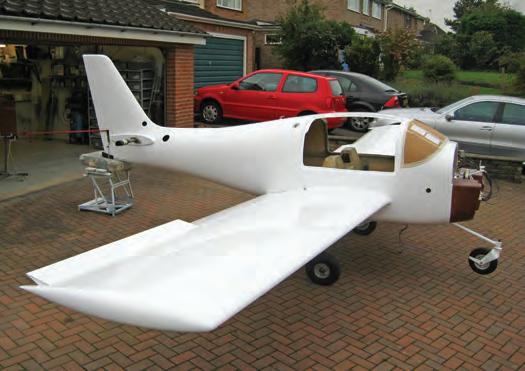
first Kitfox Mk 7 in the UK.
David did a huge amount of excellent work, including external finishing and painting, obtaining and fitting an instrument housing and designing, equipping and wiring the instrument panels. He also fitted a new Rotax 912 ULS engine and Arplast VP prop and embodied several mandatory mods. However, in 2011 he decided to stick with the Kitfox for easier cabin access and more space, and sold the project on to Peter Handford.
Peter had previously built an XS tri-gear G-PHXS but sadly it was destroyed, with several other aircraft and a hangar, by arson, after only 45 flying hours. Peter had his own engine and Airmaster VP prop completely

overhauled and substituted them for David’s fitments to recover some cost. He also fitted an 8.33kHz radio and a Trig transponder, completed the exterior finishing and upholstered the interior. As time went by, he found his enthusiasm and energy waning and decided not to complete the work that was left.
I looked at G-KIRB with my Inspector, Peter Kember, in September 2019 and we found it well-built and sound. I noted that the original build book had been lost along the way and a duplicate issued.
The early pages had been signed retrospectively by the Inspector, but not by the builder. Peter phoned the LAA and was assured this wouldn’t be a problem and on that basis, I went ahead and bought the aircraft. More about that later!
In late October I collected G-KIRB and shoehorned it into my garage, after cutting away part of my workbench. Over the winter I replaced most of the rubber components because of age – the Europa has nearly 14 metres of fuel hose, largely in a very inaccessible tunnel at the bottom of the fuselage, making replacement very difficult and uncomfortable. I think this is probably the worst engineering in the design and I now regret not changing to metal pipe, but that would be an even more difficult job – it should be done

that way in build.
I completed the wiring of the engine and fitted EGT probes and updated the instrumentation with MGL engine monitoring and an Avmap Ultra mini EFIS, linked to the Trig TT21 for ADSB-out. I fitted a SmartASS airspeed annunciator and a PilotAware Rosetta, interfaced the Funkwerk VHF to the existing Microair harness and to the SmartASS and Rosetta, and completely redid all the airframe wiring behind the panels, moving the battery to behind the seat to improve the balance. Fortunately, David Steade had put all the wiring on CAD and I was able to update his drawings. I stripped the braking system and replaced all the seals and the unsatisfactory Jamar master cylinder, and finally, I checked over everything else I could think of. I didn’t rush this work as it wasn’t very pleasant in the garage in bad weather, but it was complete by mid-March.
Peter signed off all the remaining stages except final inspection, for which I needed to move KIRB to the airfield at Kittyhawk Farm. It seemed reasonable then to target the first flight in April/May. Fate thought otherwise of course.
In the very same week, along came the lockdown and two months went by before the rules were relaxed a little and I could finally move the aircraft. On 26 May we rigged it and made the final inspection, an engine run and fuel flow checks, and later in the week I posted a large wodge of paper and the build book to the LAA, who got it on 1 June. Now began a period of frustration, watching the summer and flying season go by while we performed a seemingly endless ritual dance – the paperchase. A particular bugbear was reaching agreement on a rather unclear service bulletin. In the end I had to strip the aileron linkage out of one wing – a very fiddly job – to borescope it and confirm that it wasn’t affected.
Then, in the second week of July, I got a bombshell email from Engineering, I was now required to get the original nominated builder, Keith Duddy from i2i, to sign the duplicate stage inspection tickets. How on Earth was I to do that after 20 years? He could have been
anywhere! Linkedin, Facebook and Google couldn’t answer the question this time. However, fortunately I’d already made contact with Mark Evans through his own website and, after some asking around, he came up with a phone number. Like Mark, Keith was very interested to hear the situation and was quite happy to help – but was going on holiday the next day. True to his word he signed everything the day he got back, but even so, it delayed clearance by another avoidable three weeks until 6 August. It had seemed a very long nine weeks…
Too hot to handle…
Fate then interfered again with several days of glorious weather, brilliant sun and 30° temperatures! We felt obliged to wait for it to cool a little, for the benefit of the pilot as well as the aeroplane.
I drained the mogas and put in two cans of hard-toget UL91 and finally, on 13 August, my test pilot Carl Meek made the first flight, with Peter Kember and me watching and cheering. After 20 minutes, Carl gave us a gentle fly by and then landed. He had a big smile and reported that the aircraft flew beautifully and stalled dead straight and at the right speed. In true British fashion, rain then stopped play for the day.
I had to wait impatiently until 17 August for my first flight with Carl. A Spitfire flew over us on our initial climb out, an omen, and we had a glorious flight on a sparkling day with a few small cumulus clouds at around 3,000ft, and wonderful views of the South Downs and Beachy Head. It was magical and made it all feel worthwhile.
Since then we have completed the full testing programme with no problems to speak of, and no adjustments needed. Well, we did have one adrenaline moment when the engine started brrp brrp-ing quite convincingly! Switching to the reserve cleared it
immediately. It was a known Europa quirk, helpfully highlighted by the LAA in the test clearance paperwork, of fine plastic fibres from the tank blocking the filter despite several flushes. I already had spares and changing them takes minutes.
The post-test paperwork went in on 10 September and I received the full Permit on 1 October – not bad considering that included CAA involvement too. I also received a revised registration certificate adding Steade, Handford and myself as builders, at the LAA’s request. A few days later I had my first flight in the left seat for familiarisation and wobbly prop differences training with Carl.
What an absolute delight it is in the air! The handling is superb and cruising at 120kt feels very relaxed. I was really impressed by the wide speed range of the aircraft, the very effective flaps make a big contribution to this. It will take me a little time to get used to the CS prop, it seems very odd to move the throttle and at first nothing changes except the noise level. My take-off and landing were not the best but then I haven’t flown anything with a nosewheel for 20 years. I couldn’t find a Europa taildragger and I’m not going to butcher this one!
I’m really looking forward to getting to grips with it and I hope to go places next year. Thanks go to the builders and inspectors who were previously involved. They did the donkey work but I get the fun! (OK, building can be a type of fun too.) Thanks also to the LAA, the bureaucracy can be frustrating but we would be in a mess without them. TV presenter Mark Evans kept up his PPL for some years after the TV series. He let it lapse a while ago, but he is keen to have a flight in ‘his’ Europa when possible, as is David Steade, who still flies his Kitfox 7. I shall be delighted to take them… ■


In July we discussed the problems of refuelling your aircraft at private airstrips where there generally isn’t any form of fuel installation or bowser, and highlighted Dave James’ solution, the Gas Tapper Max. This is a commercially available batterypowered fuel pumping unit from the US that will transfer fuel from a can to your aircraft, and Dave has found that it works well for his high-wing Lambert Mission. The article elicited a degree of response, both positive and negative, enough in fact to warrant further
discussion, as refuelling from cans is a fact of life at airstrips up and down the country, and if we can find easier and safer ways of doing it, then that can only be a positive outcome. The starting point is not the complex and expensive professional fuelling station, it is improving on the current situation that is seen every weekend –balancing on a stepladder, holding a 20kg jerrycan at arm’s length, and slopping fuel into a funnel that refuses to stay upright.
The GasTapper Max is a pretty good solution but

member Trevor Nash raised a perfectly valid issues about how it is used, which are certainly worth passing on:
While refuelling as demonstrated with an open jerrycan and electric fuel pump, petrol vapour will be venting from the jerrycan and the tank being filled. Petrol vapour being heavier than air will descend to ground level, creating a potentially explosive mixture that only requires a spark. The emission of petrol vapour creates a hazardous environment when the fuel air mixture lies between the upper explosive limit and the lower explosive limit (LEL). Above or below these limits ignition is impossible. The upper limit is unlikely to be an issue in this scenario, but the lower limit is. At this end of the fuel/ air ratio the mixture requires the minimum spark energy to ignite it. Accidentally pulling the lead off the battery with the pump running could be enough to do it – electricity and petrol vapour are an extremely dangerous combination. The Petroleum (Consolidation) Regulations 2014 govern how petrol should be stored and dispensed in the UK. It covers everything from a refinery to your garden shed. For details go to: https://tinyurl.com/y3lrkexj
Trevor’s concerns should certainly be considered and great attention to detail made to ensure that the electrical contacts are fool proof as far as security and insulation, also that the jerrycan is placed as far away as possible from the electrical connections – it would also seem sensible to cover the open outlet with a cloth to prevent the escape of vapour as much as possible.
However, how about a system that does away with the need for an electric pump altogether! I also heard from Rans S-6 flyer, Bob Mathews, and Eurostar owner Gordon Verity, who both touted systems that use air pressure to
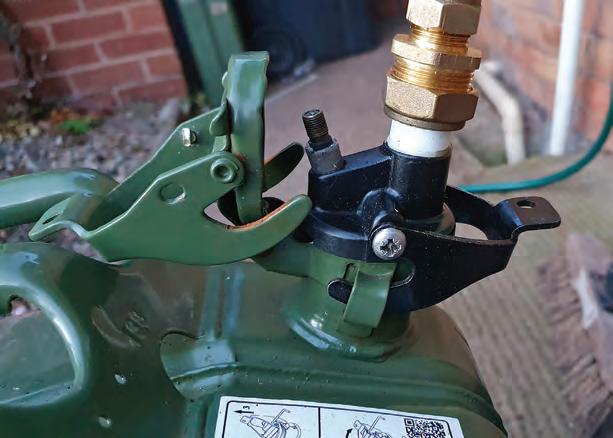

expel the fuel from the can and into the aircraft tank. Having considered something along these lines myself, I was delighted to see that their virtually identical solutions result from taking an existing product and improving it so that it works well and reliably.
Above The two ends of the refuelling attachment.
Effectively the systems allow the operator to pump a SMALL amount of pressure, certainly less than 10psi, into a fuel-filled jerrycan which forces the fuel up and out of the outlet pipe (which extends to the bottom of the can).
You may well have seen such devices available commercially, I certainly have, and indeed Bob’s system is based on a product sold by Demon Tweeks. The problem is that these commercial systems appear to be let down by pretty rubbish, plasticky hand pumps, which various reviews report can be problematic. What the Demon Tweeks one does have though, is by far the best jerrycan cap arrangement which screamed out for a sturdier pump arrangement to turn it into a very effective aircraft fuel transfer system.
The idea is that you get your fuel in standard 20 litre jerrycans and the transfer system attaches to the normal filler orifice – the cap on a jerrycan cleverly hinges back out of the way and the transfer assembly fits in its place and, by having reversed the clamp so that it pulls forward to lock the cap in place, it will work perfectly well on an unmodified jerrycan.
The transfer cap accommodates the fuel delivery hose, which extends down into the bottom corner diagonally opposite the filler hole and an automotive style Schrader valve to which you can attach a foot or hand pump. A gate valve type tap is included in the delivery hose so that a few psi can be pumped into the van, and
Below Gordon’s


then the valve slowly opened to regulate fuel flow – at full flow it will evacuate the can in about 10 seconds, so care is needed. As it is easy enough to add a few extra pumps – and jerrycans are certainly not approved pressure vessels – the minimum amount of pressure required to do the job is all you need.
The DT device costs £34 delivered, according to their website. Incidentally I have used DT several times recently for fuel hose and AN-style fittings, and they provide a speedy and reliable mail order service. It may be that you are happy with the device as it comes, but Bill, and one or two other people I know, have had problems with it. Gordon didn’t mention the origin of his version, but it is certainly of similar parentage.
It shouldn’t be beyond the wit of most members with a degree of technical nouse to adapt the DT or similar device to become better suited to the more frequent and arduous requirements of aviation use. Bill bonded a piece of 20mm dia (approx.) underfloor heating pipe into the cap, long enough to reach the bottom corner and to protrude a couple of inches out the top (this type of pipe has an aluminium liner which makes it more crush-proof when attaching fittings). Various brass compression fittings were then used to attach the five metres of fuel quality hose to this pipe, and a piece of 15mm underfloor heating pipe was attached at the outlet end so that a gate valve could be fitted. A Schrader valve, which you could steal from an old innertube, was also bonded into the cap to accommodate the pump. You can see from the pictures that Bill uses a bicycle pump and Gordon a foot-operated air bed style pump.
Bill comments: We have refuelled numerous times using the gate valve to control flow and directing the fuel through a water strainer funnel in the fuel tank opening, The normal procedure is that I get on a lightweight plastic step-up and girlfriend Julie uses the bicycle pump to pump a small amount of pressure into the jerrycan, topping up as required once I open the gate valve and start refuelling.
The only drawback was that when the jerrycan is nearly empty, the pick-up hose had no fuel, so blew air through, causing slight splattering on our wings – and two-stroke premix causes nasty staining on our unpainted fabric wing skins. This was cured by using a plastic top from one of Julie’s plastic containers, which fitted perfectly around the tank filler neck and drilled a hole through it to snugly fit the hose. This does limit the use of the funnel, however.
Bill also said that if you don’t wish to buy the Demon Tweeks version, you can buy a modified jerrycan fuel cap with two inlet tubes from a company called Wavian for about £15. See https://tinyurl.com/y5a9o2xm. This could be similarly modified to take an outlet pipe and Schrader valve, as indeed could a standard jerrycan cap, but with a fair degree more work.
I think this idea provides a worthwhile means of safely transferring fuel from your jerrycans into your aircraft, whether high of low-wing. It would make sense to have an earthing wire attached to a crocodile clip at one end and a steel spike at the other to earth the aircraft in case of static build up – you can’t be too careful when it comes to dealing with fuel.
My thanks to Trevor, Bill and Gordon for taking the time to get in touch and offer suggestions to this perennial problem – 20kg jerrycans definitely get heavier as you get older! ■

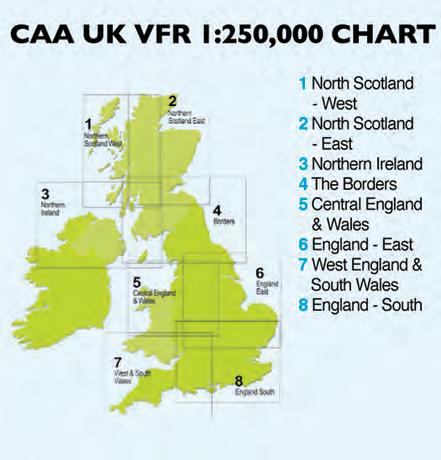





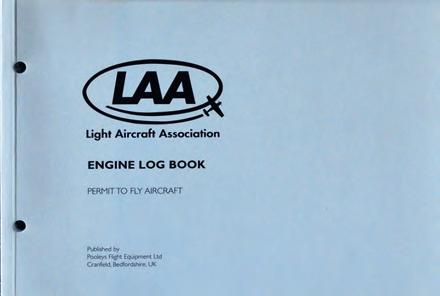



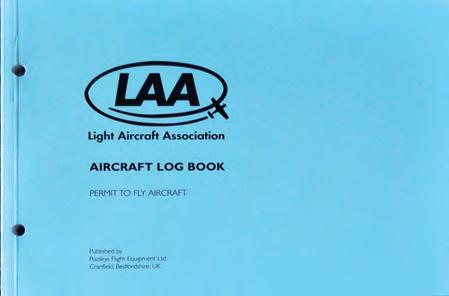

Hello again, and welcome to this November edition of Safety Spot. As always, I do hope that you and those around you are well, and that you are coping OK with the inevitable Covid-related changes most of us are battling with at this present time. Let’s hope this pandemic burns itself out in double-quick time. It’s not looking as though things are going in that direction, as I write this though: “Keep the wings level Malcolm, and keep an eye on that airspeed, you’ll be out of the cloud soon.”
“It’s an ill wind …” though, and the recent travel bans have meant that, seemingly like many others, we’ve been able to give a home to a new dog – ‘Yer need to be there for a puppy laddie’. Long-standing readers of this column will know that my last canine housemate, Jed, got involved in quite a few adventures with me – he was a keen flyer, although I’d better not shout about that too much. My new partner in crime, Sam, has a predilection for pinching things, he’s getting better and better at this, so good in fact that I question as to whether I actually put that box of screws down there… or at the bottom of the garden. Like most aircraft engineers, I’m a bit fastidious about ‘working tidy’, so Sam can be a touch ‘trying’ at times. But, he causes chaos with a sense of humour though, and they do say that laughter is a great medicine.
For me, November is the season in the UK that brings about winter. Of course, being an aviator and always having one eye on the weather I know that, officially, winter starts on 1 December… but for me it starts when I need the thermals on to safely ride my motorbike! I’m writing this in mid-October, and apart from getting rather wet a few times, I haven’t needed the thermal underwear – yet. So, what’s going on in the world of LAA Continuing Airworthiness?
Well, as always, the tales I tell are driven by events suffered (sometimes, though rarely, enjoyed) by our fellow members. Before moving on, it would be worth reminding ourselves that we all belong to an association of like-minded individuals – at least as far as our love of aviation in all its many forms goes – so we’re all playing for the same team, and team pursuits need ‘rules of engagement.’ Aviation is a frighteningly complex area for humans to engage themselves in, after all. This Safety Spot looks at some of these rules and, by looking at a few events reported by members, will try to explain why they’re very necessary.
Safety Spot is a place where we look at some of the things that haven’t gone that well for one reason or another; most aviators I know, when they read a tale where this and that went wrong, think ‘there but the grace of God, go I’, rather than ‘that bloke was a bit of a twit’.
Aircraft safety engineers start with a couple of basic premises; firstly, ‘no failure incident occurs in isolation’ and secondly, ‘every failure incident is, or was, preventable’. Often, much to the chagrin of some of my colleagues, I prefer to steer away from the, incorrectly labelled, ‘primary cause’ and look in a different direction – it’s amazing sometimes, just how events look completely different when viewed from another angle. The event hasn’t changed because you are shining your torch from the left rather than the right, but the safety response very often will.
One of my other little foibles, perhaps ‘sub-premise’, is that you can learn as much from an event that went right, as from one that didn’t have a good outcome. So, let’s start with a couple of great ‘spots’ by LAA Inspectors – albeit long after the initial mistakes were made.
elevator hinge rivet
‘Hats off’ to LAA Inspector Nick Stone for spotting an only half-completed hinge replacement job, quite probably, many years and perhaps hundreds of ‘inspections’ after the job was first completed. Nick emailed: Hello Malcolm, Good to speak the other day, it reminded me that I was going to send you a picture of the starboard elevator (both outer brackets) on an SAL Bulldog. It is an odd one but may affect other Bulldogs in service.
On inspection, I found that rivets from the elevator support brackets were missing. Further investigation revealed that, at some time in the past, the split elevator on the starboard side had been changed (during RAF service). To remove the bearing assembly from elevator, this has to be taken apart.
Potentially, with the rivets missing, the structure may be compromised, more so with two of the three retaining brackets missing rivets. To resolve the issue, after consulting DH Support at Duxford, A113 bolts have now been fitted in the vacant holes and, naturally, checked to ensure no movement has been restricted, or there’s any clash with structure. It was felt that replacing the rivets could potentially cause damage, so bolts were substituted.
Best wishes, Nick Stone.
We have two Bulldogs ‘resident’ at the LAA’s home airfield of Turweston, and one in the paint shop being tidied up so, armed with a torch, a mirror and my camera, I set about checking these aircraft. All the aircraft I checked were rivitus intactus, so I felt that this was more than likely a one-off mistake by an RAF fitter (and his or her inspection team). It does go to show you just how easy it is to look for problems, perhaps during a pre-flight inspection, but not, even when they’re fairly obvious, see them.
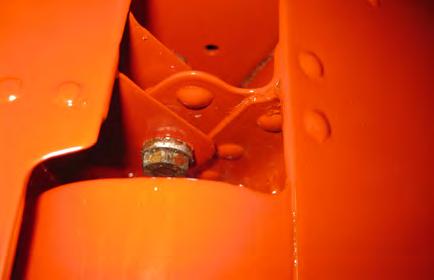
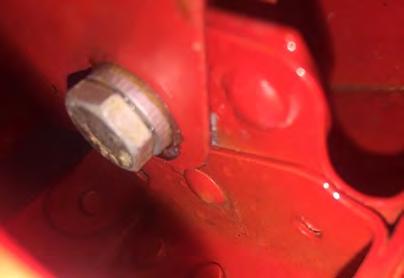
In a way, this is the difference between looking at something to see if it’s OK, a sort of ‘pre-flight waggle’ of an aileron, and a proper inspection of the aileron system. In the former, you aren’t expecting there to be any real issues – in fact, an issue, just before you go flying, wouldn’t be welcomed. In the latter, you need to be mindful that everything fails in the end, and the human that fitted this or that bolt, nut and split pin, probably fails quite regularly. So, if you are inspecting something, perhaps after having been asked to carry out a duplicate inspection of a disturbed flying control, keep this in mind.
I’ve always admired the Thorp T-18, if you haven’t seen one, and I wouldn’t be surprised if you haven’t, we’ve only one currently flying under LAA colours, look it up. The proud owner of the UK example, Peter Mair, has owned this imported example since 2007. In straightforward terms, the T-18 is an all metal, 200mph, side by side, two-seater taildragger, powered by a 140hp Lycoming O-290. Peter’s aircraft was built in 1970 and has accrued, in her longish life, just over 1,100 hours.
Peter writes: Good Morning Malcolm. Over the years I have flown my T-18, the mixture has always had to be pulled back by around 20mm and the plugs have regularly oiled up, I have had the carb overhauled and new magnetos fitted, and while this helped a little, it has never resolved the issue. Just over a year ago she started smoking badly to the point that one ATC said it looks like a B52.
My LAA Inspector, Sandy Hutton, suggested we replace the oil rings, we did this and this helped in the short-term, but by the end of last year she was back to smoking; worse, the engine felt like it was lacking power… down to the point that I was searching for a replacement engine.
Sandy decided to take one last look and, after a while alone with my machine, returned to the clubhouse exclaiming that the wrong carburettor had been fitted. “It’s an MA4 instead of an MA3”. I managed to source a second-hand MA3, which Sandy and I fitted, while in the meantime I had sleepless nights worrying how a smaller carb could give the same power.
Initial and duplicate inspections completed, we started the engine. My first thought was, ‘that feels smooth’’, I opened the throttle to give 1,500rpm and, worryingly, I found this was max power. Sandy said, ‘worry not, it’s the throttle fixing’ and after adjusting the rigging of the new carburettor the engine delivered 2,250rpm static, just right.
Due to the weather, it was later in the week before I could carry out the test flight, and I admit to being nervous about it. Power check, mags check, full and free, better get on with it – with half full fuel tanks and me at 75kg we were off the runway in less than half of the 600m available with a healthy 1,600fpm climb. Everything else was fantastic so I landed, filled her full of fuel and added a bit of ballast and conducted the annual check flight – at max weight achieving in excess of 1,100fpm. Paperwork sent to LAA HQ, the Permit being turned around and sent the same day
So, thank you Peter for letting us know that you’ve got your machine flying well again, and well done Sandy for looking at the ‘not so obvious issue’.
The lesson here is, perhaps, just because a part has been fitted to an aircraft you’re inspecting, don’t assume that it has (a) been fitted
Left ‘Now you see it –
Now you don’t (1)’. Inspecting an aircraft to ensure that it’s fit for flight takes skill and experience; a quick glance will never be enough to establish whether something is OK or not OK. Would you have noticed the missing rivet in this Bulldog elevator hinge?
Photos: Malcolm McBride/Nick Stone
correctly and (b) that it’s the correct part for the job… always check. This next story perhaps re-emphasises this point once again.
We all have bad days, and when Aeroprakt A-22 Foxbat flyer, David Howells, ran into some recently chopped down logs just after landing, he knew he was having one. Nose legs are definitely a vulnerable point on many aircraft in this class it’s true, but I cannot imagine any strong enough to resist bashing into a pile of logs. Fortunately, David was fully insured and the major damage was limited to the nose leg attachment at the firewall, and the aircraft’s floor. A ‘repairer’ was agreed upon and the fuselage was duly dispatched to the repair shop in a truck.
Changing the firewall on any aircraft is a complicated business and takes a lot of hours to complete. Because the firewall and floor were purchased from the manufacturer as items, the repairer considered the repair as being covered under the rules of ‘repair by replacement’ and on this basis, no reference about the repair to LAA HQ was considered necessary by the repairer.
The fuselage was returned to David and he, with the oversight of a local LAA Inspector, re-rigged the aircraft. He commented, “I noticed that the floor had changed from a corrugated floor to a flat sheet, and that the firewall was now made from stainless steel and not aluminium – I was also quite pleased to see that a strengthened nose undercarriage assembly had been fitted.
“I questioned the repairer about this and he assured me that all was OK and that these items were of the latest standard supplied by the manufacturer and had been approved by the LAA on recent examples of the Foxbat.” David continued, “So, notwithstanding the issues of COVID-19, I got back into the air in my own machine – fantastic – I absolutely love my Foxbat, she’s a wonderful machine.”
One morning, David decided to go flying but his hopes were dashed when he noticed that the trailing edge of the propeller was just clipping


David Howell
the front of the engine cowling. Clearly something was up, and it didn’t take long to spot the problem – the firewall and the cockpit floor had buckled and had allowed the front of the engine to drop.
Our design team looked at the pictures to see what may have gone wrong here, initially, and quite naturally, the change in the design of the floor was centre-stage – surely a flat sheet is nothing like as strong as a corrugated one? But the flat sheet floor has been approved on other the Foxbats, and a close look at the drawings showed that the main load path for the attachment of the nose leg and bottom engine mount runs through a hefty bolted block and a bracket rivetted to doublers in the floor of the fuselage. We asked for more pictures showing the inside of the fuselage.
Looking at the pictures when they arrived, the failure sequence became clear; probably after some sort of unplanned overload, the nose undercarriage support bracket had broken free from its mounting.
As you can see from the pictures, the two rivets holding the bracket in

and rigging checks carried out. He noticed
had previously been corrugated, had been replaced with a flat sheet. The LAA Inspector responsible for signing the aircraft out after reassembly insisted that the aircraft be checked by the UK manufacturer’s representative and, after this had been carried out, he received assurances that this design alteration was ‘factory approved’ and as accepted on other later LAA examples. Photo:

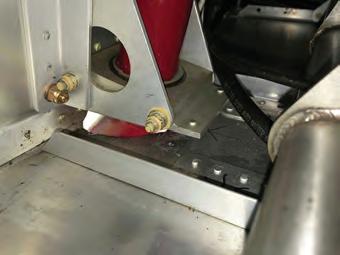
place had failed, allowing the bottom of the firewall to move back. Correspondence with the Foxbat’s designer and the UK agent revealed that the block and bracket had been supplied as repair items from the manufacturers with two ‘pilot’ holes drilled, but the installer was expected to drill additional holes on assembly for the extra rivets, making up the group of four rivets shown on the drawings, which were required to carry the expected loads generated by the nose undercarriage. Some of the Foxbat variants use three bolts rather than four rivets, apparently, so these repair items were perhaps intended as ‘universal’ components that could be drilled to suit either configuration, depending on the aircraft they were being fitted to.
LAA Engineering is carrying out a review to establish exactly what’s gone wrong with this aircraft’s repair process. We’re writing to all Foxbat owners to ensure that this error hasn’t occurred on any other aircraft in our fleet, and, I have no doubt, further advice about what is and, importantly, what shouldn’t be, considered a ‘repair-by-replacement’ will follow. We’ll also be contacting aircraft kit and parts manufacturers to remind them that an LAA Permit to Fly aircraft is certified ‘as initially cleared’. Any design change, however minor, or for whatever reason, must be first accepted by LAA Engineering before an aircraft can be cleared for flight with a new design fitted.
This is an example of a technical error that could very easily have gone unnoticed and the blame attributed solely to the pilot – as it was, as so often happens, there are multiple causes but I have to say that the repairer can see what’s gone wrong and will be putting the aircraft right for the owner – naturally, Engineering will be right behind him during this process. Well done to him and his team.
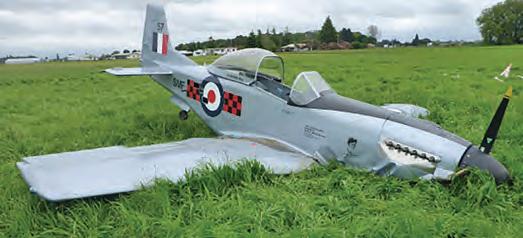

Above LAA Engineering has recently been made aware of an accident report published by the New Zealand Airworthiness Authority concerning a fatal accident involving a Titan T-51 Mustang. The pilot, the owner of the aircraft, suffered an engine failure shortly after take-off and conducted a ‘straight ahead’ forced landing. It is thought that he didn’t react quickly enough to get the nose down and, because the speed was low, the aircraft had a high rate of descent on impact. The fitting of the shoulder harness was apparently non-standard and the accident report suggested that it would have been survivable had the harness been fitted correctly and its attachment not failed in the crash. We’ve promulgated the NZ CAA Continuing Airworthiness Notice (25-01) to all our Mustang owners and issued an Airworthiness Alert, with a link to the accident report, which is available from the LAA website.
Stolp Starduster Too: Partial engine failure after take-off. One of our very experienced inspectors relayed a tale to me the other day which he felt would be worth passing on. It’s a story of multiple errors involving novices and experts alike. The event also involves, like many close shaves affecting sports aircraft, both operational and technical points. I suppose I should default to the usual term for incidents where pilots and engineers sit at the centre of a problem –human factors!
Initially, when I was told the tale, I imagined that the events had occurred over the last few weeks, but once I had finally assimilated the many chapters in the story, I realised that this tale had its origins with a misbehaving engine some 12 years ago. I asked the LAA Inspector involved to write a brief report before my brain exploded – I’ve never been that good at ‘whodunnits’, I always feel like telling the author as I read, ‘for goodness sake, get on with it’. Here’s the Inspector’s report: Report on rough-running engine, Stolp Starduster in the summer 2018 (written September 2020).
I made a Permit renewal recommendation for this aircraft in the early summer of 2018, and shortly afterwards it was sold and ferried to its new home. The new owner arranged for a familiarisation flight with an instructor, during which the engine suffered a partial loss of power after take-off, but it picked up again when the nose was lowered.
A tight circuit was carried out, and although the engine ran rough again on final, it was landed safely. I learned of this problem a year later in the summer of 2019, when I was asked to carry out another renewal inspection. Due to the lapse of time it was difficult to establish precisely what had happened, but it seemed clear that the problem was associated with fuel rather than ignition.
It should be borne in mind that a similar incident occurred in 2009, when the engine ran rough on a go-around at the end of a training session, when fuel quantity was low and the nose was high. The instructor lowered the nose, the engine picked up, and a safe landing was made. Investigation showed that the fuel pump had failed, but there was no way of knowing this in flight.
As a result of this incident the owner asked me to raise a Mod to fit a second fuel pump. This Mod was approved and embodied in 2010, it included two pumps with an either/or switch and a pressure gauge on the instrument panel. A check-valve was also fitted in the gravity supply line to prevent either pump back-feeding to the tank.
My initial investigation of the 2018 incident focused on fuel contamination as a primary suspect, but nothing was found. I widened the search to encompass the whole fuel system and eventually discovered that the check valve [NRV] was sticking – which reduced fuel flow under gravity alone to a significant degree.
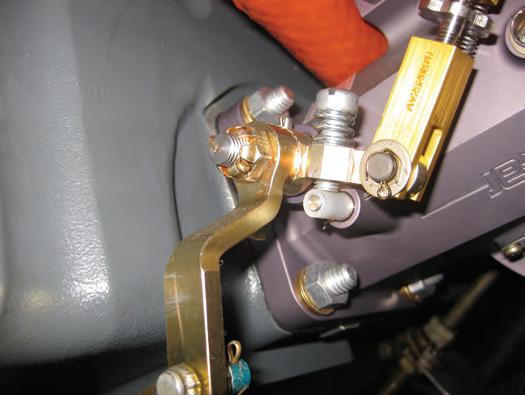
I have established that the instructor joined the aircraft for the check flight sometime after the new owner had started the engine. He doesn’t recall which cockpit he occupied, but it seems reasonable to assume that the new owner would be in the rear or solo cockpit, and the instructor in the front cockpit. The fuel pump switches and the fuel pressure gauge are in the rear cockpit only.
I am of the opinion that the occupant of the rear cockpit had not identified or switched on either of the fuel pumps, and this resulted in fuel starvation when demand from the engine was high. It is unlikely that the noise of a fuel pump – or the lack of same – would be noticed or remarked upon by any pilot who was not familiar with the individual aircraft.
We became aware of this at HQ when two things occurred simultaneously. Firstly we received a Permit renewal application and then we received a report that this aircraft had, again, suffered an inflight incident whilst on its test flight. Our Chief Engineer, Francis Donaldson, asked me to see what had happened, and to look more closely at the early fuel pump modification – after all, problems with fuel supply seemingly sat at two previous in-flight emergencies.
I spoke to the inspector, who was also the renewal check-pilot during the most recent ‘event’. He explained that the fuel system had been completely serviced, the sticking check valve had been replaced, and the carburettor – one of the culprits in the second inflight engine stoppage – removed, serviced and replaced… the other, of course, was that the trainee pilot didn’t turn the electrical fuel pump on before flight –we’ll come to that.
A third event was to follow, however – to check the aircraft out after all this work had been done, the inspector/check pilot took off after the usual ground runs and the engine performed well. He retarded the throttle to settle the engine into a more relaxed cruise-climb but, on doing this, there was no change in engine rpm. “Oh dear, what’s happened now?” Well, some pushing and pulling on the throttle lever showed that, somehow, the throttle lever had become disconnected. Our pilot, a very experienced engineer and pilot, carried out a ‘rather quicker than normal circuit and approach’ and cut the power using the mag switches when he was sure he was in, with no further drama (or damage).
It turns out that, although the throttle linkage had been connected to the carburettor, and adjusted to ensure that both idle and full throttle settings were available via the throttle lever, and a local PPL (and LAA member) had carried out a full duplicate inspection, the fact that there was no split pin locking the nut to the bolt, was missed. Of course, vibration unwound the nut and the bolt fell out, disconnecting the link.
So, what to learn? Well, the aircraft had been sitting about for some time between events and, as we know, components that remain unused
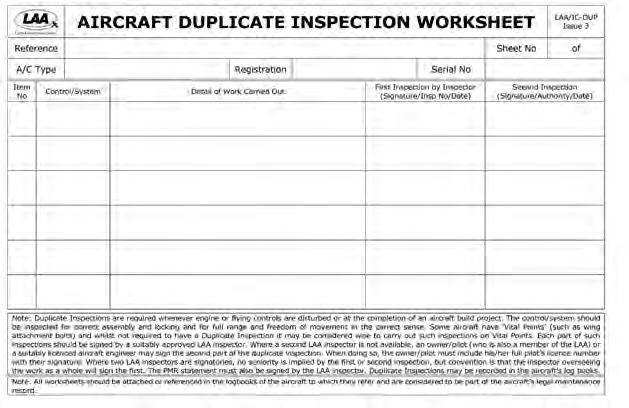
where things haven’t gone as well as they should have done, and
done on an aircraft. In this case, various normal engineering
done on flight or engine control systems there’s a formal
event, but second (duplicate) inspections carry
for a time can suffer in all sorts of ways. The check-valve sits at the bottom of the fuel system, so it’s likely that it had become ‘sticky’ through corrosion – remember that any water will sink to the lowest point in a fuel system over time. But really, in two of the three cases the reason for the power loss after take-off, was that the fuel pump wasn’t switched on before take-off – and this has to be the fault of an overly rushed, possibly non-existent, pre-flight briefing from the instructor to the trainee.
There are three big lessons here. One, if you’re going flying, take your time before the flight, to settle yourself down into pilot mode – sounds a bit wet I know, but you’re not going to perform well in the air if you’re carrying the weight of the working week on your shoulders, perhaps thinking ‘thank goodness for that, freedom at last’ as you taxi out.
Flying an aircraft can be stressful enough, you don’t need to be thinking about meeting other deadlines. This is just as true, by the way, if you’re a busy flying instructor or just starting out with a new aircraft. Two, before you fly any aircraft, yes before, understand the principle systems.
All aircraft have their foibles, and it’s important to understand them – in this case, because the gravity feed from the tank is marginal with low fuel levels we’ve asked that a placard, instructing the pilot to ensure that the fuel pump is on before take-off or landing, and whenever the fuel tank is less than ¼ full, is fitted in clear view of the pilot before further flight.
Of course, the third lesson is to remember that, if you are asked to perform a duplicate inspection, make sure that you actually do it properly. This can be a bit daunting for an owner inspecting work his or her ‘mentor’ has just done, but an LAA Inspector won’t thank you for missing something important if it’s failure ends up leading to an accident – inspection is not just ticking a box. A duplicate inspection, regardless of what some might say, carries the same responsibility as the initial one and, as an important aside, the initial inspection is a separate job function from carrying out the work… different hats required!

In retrospect, Pioneer 300 flyer James Mullen, thought that it probably wasn’t the best of ideas pushing on home after his exhaust system had failed in flight, he thought that he should have landed as soon as possible – I agreed. The sequence of pictures shows just how fortunate he was to get away with it!
Picture 1 is of the water bottle and picture 2 the battery, bad enough, but it wouldn’t have been long before serious structural damage could have occurred – the Pioneer 300 is a wooden aircraft after all.
To keep the underside of the fuselage clear of exhaust gasses and to help prevent exhaust gasses entering the cockpit, the Pioneer 300 exhaust tailpipe has been progressively lengthened. 1 2

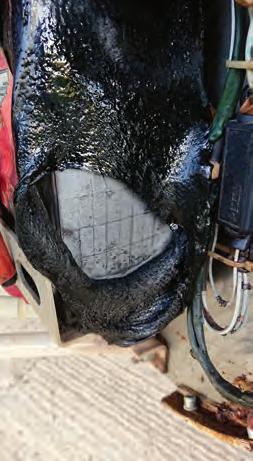
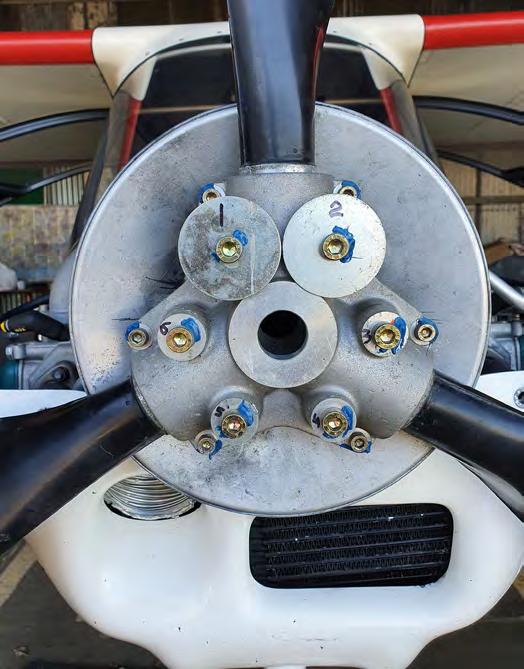
any sign of ‘smoke streaks’ created by
investigating. Photos: Philip Meech.
This lengthening has led to a number of failures of the welded connection between the tailpipe and the silencer box and the manufacturer of the system, CKT Engineering recognised this issue and have modified the exhausts by fitting a strengthening bracket – picture 3
If you have a Pioneer with the lengthened tailpipe, but haven’t had the strengthening bracket fitted, we’d recommend getting this done, and CKT will modify your exhaust free of charge.
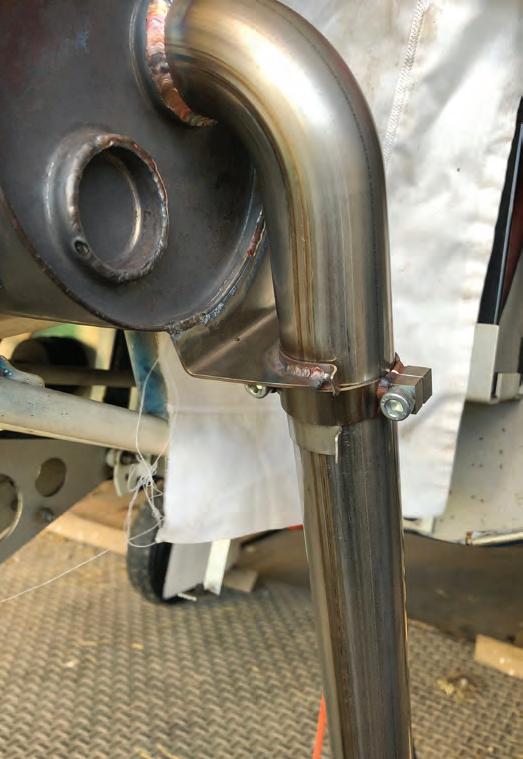
LAA
Initial
Up
Permit Renewal (can now be paid online via LAA Shop)
Up to
451-999kg
1,000kg
Factory-built gyroplanes (all weights)
Note: if the last Renewal wasn’t administered by the LAA an extra fee of £125 applies Modification application
Prototype

Above The picture shows another exhaust system failure, this one on a Rotax 914-powered Eurofox glider tug.
Whilst a complete failure of the welded joint connecting the pipe to the flange can lead to a dangerous inflight situation, which is why a thorough inspection of the exhaust is recommended at each pre-flight inspection, in this instance, the pilot wasn’t just confronted with the danger posed by fire and fumes, the failure occurred suddenly whilst launching a glider. Fortunately, both the glider and tug landed safely.
Photo: Ros SibbaldFour-seat
Manufacturer’s/agent’s
Project
Group A to
Microlight to Group A
Change of G-Registration fee
Issue of Permit documents following G-Reg change
Documents
Lost, stolen etc (fee is per document)
Latest SPARS – No 17 April 2018
PLEASE NOTE: When you’re submitting documents using an A4-sized envelope, a First Class stamp is insufficient postage.

This month we meet Frank Cox, former Fleet Air Arm and corporate jet pilot and owner / restorer of a lovely Fairchild Argus
Welcome Frank, can you tell us a bit about your career?
I spent my pre-teen years in Somerset, relatively close to RNAS Yeovilton where my interest in the Navy and flying was kindled. To that end I went to the Nautical College, Pangbourne, where the education was slanted towards a seagoing career. Having spent 21 years in the Fleet Air Arm, followed by a couple of years with the Fleet Requirements Unit, I then had a further 23 years in the private jet world, I have been retired for 12 years.
What started your interest in aviation?
As a very young lad, one of my earliest memories was to watch the Brabazon drone overhead, which I suppose subconsciously sparked my interest and started me into building models aged around five or six.
In what, where and when was your first flight?
After the war, my father had re-joined the Army following a period of farming and was based at Yeovilton as a Ground
Above Frank Cox with his stunning Fairchild Argus – a 25-year restoration
Liaison Officer. It was there, at an Air Day in 1952, that I managed to inveigle my mother into giving me 10 shillings for a joyride around the block in an Anson. After queuing for some two hours, I was ushered all the way forward into the right-hand seat. The rest, as they say, is history.
After Yeovilton, father was transferred to Germany where, aged 14, I joined the gliding club at RAF Gutersloh and flew there during the school holidays. A year later, after another move, I joined the RAF Laarbruch gliding club, where in July 1960, I flew my first solo in a Tutor, aged 16. I remember it well for its brick-like qualities compared with the relatively high performance Kranich two-seater I had previously been flying. I continued to glide when time permitted and at weekends while at school at RAF Benson, with the Chilton Gliding club.
Having joined the Navy at BRNC Dartmouth in September 1962, powered flying came my way in the shape of a Tiger Moth. Twelve of these, based at Plymouth Roborough Airport, were used for Flying Grading of potential aircrew to weed out those that did not show the required aptitude.
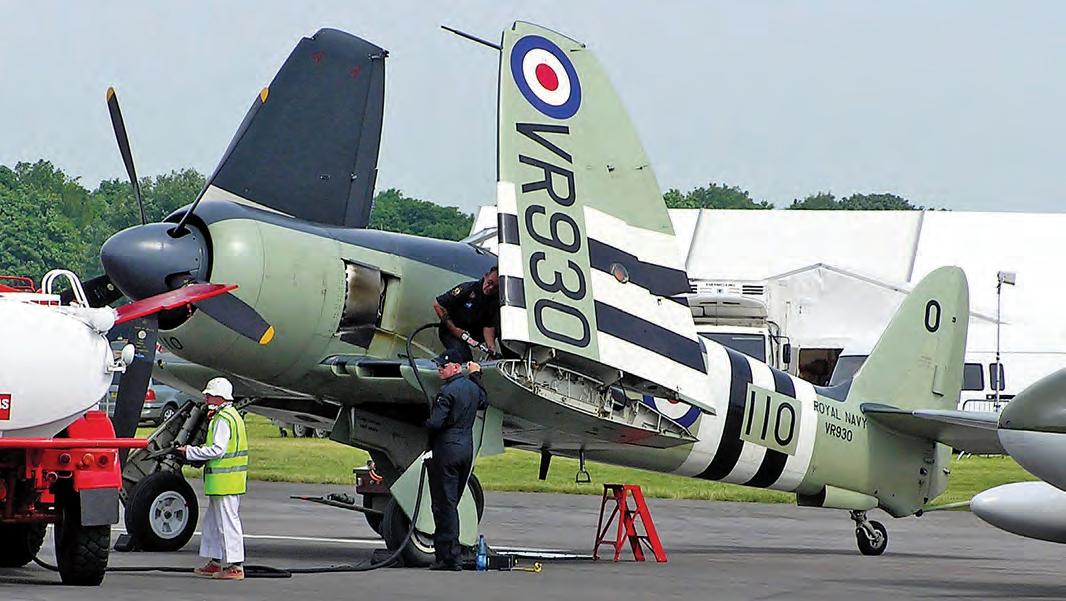

From Dartmouth it was up north to Yorkshire, and RAF Linton-on-Ouse for basic training on the Jet Provost Mk3 and 4. Then followed a return to the dark blue environment in Pembrokeshire at RNAS Brawdy for Advanced Flying Training and Operational Training, part one in the Hunter T8 and GA XI in 759 and 738 squadrons. I then finally got my hands on a Buccaneer, which would be the mainstay of my flying for the rest of my Navy career.
Having completed training I joined 800 squadron at Lossiemouth as a very junior pilot crewed with an ex Sea Vixen observer, who could finally see where he was going and keep an eye on me. We embarked on HMS Eagle in August 1965 and immediately sailed for the Mediterranean and the Middle East off Aden, and then on to the Far East.
During the time off Aden, I became night deck qualified, which kept the adrenalin level topped up. In March we had to hurry from Singapore across the Indian Ocean to replace HMS Victorious, who had suffered a serious fire while on station off the coast of Mozambique blockading the port of Beira against tankers offloading oil destined for Ian Smith’s Rhodesia. Having been away for a year we disembarked to Scotland in August 1966 and in October we changed over to Buccaneer Mk2s.
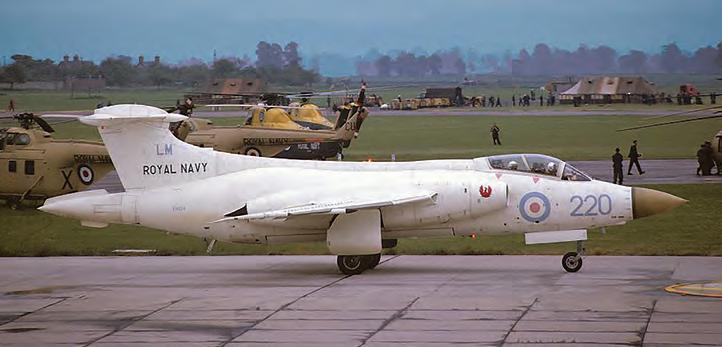
Top A spell with the Royal Naval Historic Flight saw Frank displaying the Hawker Sea Fury FB.11 (pictured) and T20 variants.
Above left Frank in the early 1980s with the Seafury, nearing the end of his Fleet Air Arm career.
Above right A Fleet Air Arm pilot for 21 years, Frank’s favourite aircraft is the Buccaneer.
Following an exhilarating two years of front line flying, I was appointed to 738 Squadron at RNAS Brawdy as a staff pilot, flying Hunter T8 and GA XIs mentoring students undergoing part one of operational training. Then back to Lossiemouth to undertake the Air Warfare Instructors (top gun) course – a very intense and fast moving four months which stretches one’s personal limits considerably. It was then a return to 738 Squadron as the AWI until July 1969.
The front line beckoned once more with an appointment to 809 squadron as the AWI and 11 months shore based until we embarked in June 1970 on HMS Ark Royal, for six months working around the UK and in the Med. We re-embarked in April 1971, proceeding to the east coast of the States where we made use of the great array of weapon ranges. Firing rockets at manoeuvring speed boats was particularly good sport, as were the runs ashore.
Having left the front line for a second time I moved on to be the AWI of 764 squadron (top gun school) instructing future AWIs.
I returned to the Buccaneer, albeit of a different colour, at RAF Honington, in 1972 for two years as a staff weapons instructor, and in March 1974. I went to the USA to spend two years with the US Navy. Returning to the UK in May
1976 saw me re-join 809 squadron and the Buccaneer, as the senior pilot via various short re-familiarisation courses. Land base at this time was Honington, because Lossiemouth had been handed to the Air Force. We embarked on Ark Royal once more in September for two months and made the final embarkation before the demise of the fixed-wing carriers in February 1978. Once again, the east coast of the States beckoned where great use of the Puerto Rican ranges was made with many different weapon loads.
My final Buccaneer flight was an inauspicious trip from Ark Royal, operating to the south of Marseilles, to St Athan with the wheels down and ground locks in due to a major problem which precluded retraction. So ended my embarked and Buccaneer flying days.
Next, came a return to Brawdy, by now RAF Brawdy, where I held the position of Senior Naval Officer and staff weapons instructor in 234 Squadron, flying the Hawk and overseeing the last of the naval fixed wing students destined for the Sea Harrier.
My final naval appointment began in March 1981 when I joined the staff of Naval Flying Standards Flight as a weapons and tactics instructor, specifically to introduce helicopter pilots destined for the Sea Harrier to the joys of high speed fixed-wing aviation, including weapon delivery and combat manoeuvring.
Also at this time I was lucky enough to be able to fly for the Royal Naval Historic Flight, flying the Firefly for the 1981 season and the Sea Fury for the 1982 season. Notable venues for the Firefly were the two-day shows at Biggin Hill and Mildenhall. Significant appearances in 1982 with Sea Fury were at Mildenhall again and three days at the Farnborough Airshow, I managed to achieve a total of 22 hours Firefly time and 40 in the Sea Fury T20 and FB11 combined. It was a great privilege to fly them. What great aeroplanes but so very different in their ways.
Incidentally, prior to my involvement with the Firefly and Sea Fury, in June of 1979 the Navy entered the Historic Flight’s Tiger Moth, T8191, into the Grouse Rally and I was fortunate, with another pilot, to take part. It was a superbly organised, slightly competitive, tour from Hatfield to Strathallen in Scotland, with fuel stops at Hucknall and Sunderland. We had the dubious pleasure of receiving the ‘wooden spoon’ for the worst fuel efficiency overall – the Queen was paying for the fuel so economics did not come into the equation when setting the mixture!
Carrier operations with conventional fixed-wing aircraft are just another skill to be learned but where the margins for error are greatly reduced and where one’s situational
Below After his Navy career, Frank flew HS125s worldwide as a corporate jet pilot and has great affection for the type.

awareness must be greatly increased. Any divergence from the ideal must be rapidly recognised and corrected. I found that practice day landings did not raise the adrenalin level to any degree. However, at night a couple of beers afterwards were required to bring it back to normal, especially in poor weather. After a busy and demanding sortie, it was an even more demanding task to get safely back on board.
This was in the days where it was possible to form a squadron display team without the several layers of oversight that are in place these days. At RNAS Brawdy 738 Squadron formed a seven-aircraft team in April 1969 and performed throughout the season at various open days and air days around the country. I was number four, in the centre, and therefore had to fly as smoothly as possible to give my wingmen an easy ride. We would practise first thing in the morning and then fly one or two syllabus sorties with students, and then occasionally fly another practice in the evening – a fairly hard day’s work.
The Navy always had several standing exchange positions with the USN and I was lucky to be appointed to VA42, the training squadron for the A6 Intruder. My job was to instruct the students passing through in the art of visual weaponry which, for the A6, was very much a reversionary mode after the radar and weapon release computer had failed. I was based at NAS Oceana in Virginia Beach, however, most of my working time was spent running detachments to MCAS Yuma in Arizona or NAS Fallon in Nevada where the airspace was uncluttered, and the relatively quiet weapons ranges enabled the booking of slots to fit the flying programme.
The A6 was an aeroplane with a remarkably clever weapon system and the ability to carry a huge weapon load, albeit relatively slowly. Manual flying at low level at night in mountainous terrain, purely by the use of the radar and the TV like presentation to the pilot, took a little getting used to; night vision goggles did not exist then.
I was extremely lucky in that I was given a government grant for my commercial licence training and the Navy kindly lent me a Sea Devon for my CAA instrument rating exam. Having a licence in my pocket led me to be offered a job flying an HS125 in Saudi Arabia for a construction company based in Riyadh. I was subsequently offered a position with British Aerospace, also in Riyadh, to set up and manage a VIP flight of four 125s with associated crews and engineers. After four years I left the desert and moved to Istanbul, where we flew mainly into Europe and occasionally to Moscow and the States, which invariably involved a fuel stop in Iceland although when eastbound we could usually make the UK in one hop from Gander.
Having left Turkey to get based nearer home I spent six months with a start-up ad hoc charter company in Dublin flying a very old and tired 125-700. From there I picked up possibly the most enjoyable job of my civilian career flying an 800XP based in Tel Aviv but living here in the UK and commuting as required for an owner that was always concerned as to our well-being. After six years I found myself based in the UK for the first time at Bournemouth for

five months, flying to UK and European destinations prior to retirement in 2008.
I found the 125 to be the most reliable aircraft I have ever flown, with the exception of the Irish one which had obviously suffered from a lack of care and attention throughout it’s life. Otherwise I only missed two trips due to unserviceability in over 4,500 hours’ 125 time. It is a delight to fly with crisp control response and gives a very comfortable ride.
Many years ago I had an L4 Cub and joined the PFA to cover the permit paperwork. I re-joined five years after the CAA finally allowed the Argus to become an LAA aircraft. The LAA route to airworthiness totally overcame the bureaucracy and ‘goal post moving’ that I was suffering at the hands of the CAA.
In 1993 I had a share in a fully restored Tiger Moth which, with a growing family, was not exactly practical and while searching for a four-seat taildragger came across an Argus for sale, based at Coventry. Being based overseas, I did not fly it very often but in 1994 I decided it had to be re-covered, as it was cosmetically a mess. As with most re-cover jobs, it was also a mess underneath, and so started a 25-year restoration, including an engine overhaul. It was not particularly difficult but as it was my first attempt, each phase required research into the procedure required. The internet came to the rescue many times.
I used Ceconite, which at the time was cheaper than, but is identical to, Poly-Fiber fabric but the finish is Poly-Fiber’s Polytone system, flattened for a matt finish. I did not need many spare parts, however I spent many hours cleaning and refinishing existing parts. What new/ serviceable parts I did need were sourced via the internet and mostly came from the States.
All that was required to get it onto the LAA was to submit the required paperwork to Engineering for approval and obtain the services of an approved test pilot. The flying was completed in one day, with a minor omission carried out later. There were no snags, which was very pleasing.
Thus far I haven’t ventured outside of the West Country but now that the engine is finally broken in and the oil consumption has reduced, the plan is to venture further afield from the West Country.
What is your total of types and hours flown?
I have flown 26 different types and amassed 10,800 hours
Above The Historic Flight’s Fairey Firefly, which Frank displayed throughout the 1981 air show season.
Do you have a favourite and not so keen on type flown?
The Buccaneer has to be my favourite, probably because I had a lot of time in it. It was an absolute joy to fly in its element at low level, although at slow speed one had to be on top of it. Not to be controversial and with great respect to owners of them, the Cessna 152 and 172 have to be the worst. I have little time in either, but first impressions count Being a fast jet man, I appreciate good performance and crisp handling – I find these two lacking on both counts.
What do you consider to be your best aviation moment?
One of the best was flying from the ship through the Norwegian fjords and mountains to reach and photograph a target in extremely marginal weather at 420kt, with my observer and I having absolute trust in each other as to each other’s ability to fly and navigate. This bond of trust is very difficult to describe.
Do you have any aviation heroes?
My heroes are those test pilots who were pushing the boundaries at the introduction of the high-speed jet age, especially during the transonic era. They really were nibbling at the unknown, and at some cost.
Any hairy ‘I learned flying from that’ experiences?
Diverting from HMS Eagle at night to Aden, having failed to hook on twice, to find that the ship was twice the distance she said she was from the diversion, and to lose one engine as we turned off the runway through lack of fuel.
The lesson learned was that however insistent and, in this case senior, the officer or ATC are, remember that you are the one in the aircraft and, if necessary, declare an emergency before matters get out of hand.
Do you have non-aviation interests?
Not really, aircraft restoration absorbs quite sufficient of a limited budget. However, I’d love to have my old 3.8 Series 1 E-Type Jaguar back.
What advice would you offer pilots?
To plan carefully and to have a ‘Plan ‘B’. When airborne keep well ahead of the aircraft in terms of situation awareness, and should an instrument not be indicating what you know to be ‘normal’, even if it is within limits, investigate before matters deteriorate. In the long run it is cheaper and saves on long ‘down time’. ■

For all display or commercial advertising enquiries please contact Neil Wilson: 07512 773532 neil.wilson@laa.uk.com
You can email your classified advertisement direct to the LAA at the following address: office@laa.uk.com
Deadline for booking and copy: 20 November 2020

Rare


Chipmunk Share (WK514/G-BBMO) - Rare opportunity to join the Wellesbourne based Chipmunk syndicate - a long established, knowledgeable and passionate group. 1/7th share in this historic example. Extensive spares, tooling and significant engine fund. £80month-£96/hr wet. Emigration forces sale. Details: skelly2020@protonmail.com or 07930146584

Tiger Moth. Share for sale in well-established group operating a Tiger Moth from White Waltham. Current LAA permit, good availability. Prospective buyers will need to be current on type, or to complete a full training course elsewhere. For further details, please contact Malcolm Ward, e-mail: mward57@t-online.de Mobile: 07752 818 534.
JPM, Oil filter adapters. Made to order, Continental O-200 -12 £320 and A65-8 from £390. Will help with Mod paperwork. These adapters replace the oil screen assembly. jpm.aviation@gmail.com
Julian Mills 07976 530563
Welding services (mobile). CAA approved for 4130 steel airframe manufacture and repair. Custom exhaust systems and aluminium fuel tanks undertaken. Manchester based. Contact Julian Mills, on 07976 530563
Design & Stress Analysis Service. Type submissions, modifications, engine frames and general advice. We cover everything from SSDR to A380 :- structures, powerplant (IC and electric) and avionic installations. Contact John Wighton enquires@acroflight.co.uk or call 07770399315.

HAPI Cygnet SF-2A project for sale. Almost complete (see photo) but ill-health forces sale. Powered by new Rotax 912. Instruments provided but not yet fitted. Sensible offers invited. Please email gcygi.sale@gmail.com for more information.









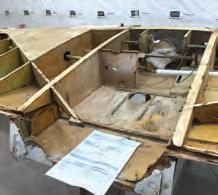


 By Steve Slater
By Steve Slater
One of the biggest safety enhancers in flying is contingency planning. Whether it is a thorough pre-flight weather and Notam briefing, or running through a quick ‘what if’ checklist just prior to your take-off roll, such planning can be vital should anything go pear-shaped. So, with COVID-19 infection rates still rising, what are our contingency plans here at LAA HQ?
After a period in which a relaxation of COVID-19 precautions allowed LAA HQ to return to relatively normal working, the current infection situation has again required a change in these activities. From 1 October, we have closed the offices to non-essential visitors and paired our engineering and commercial staff into two separate ‘cells’, with one group working from home while the other populates the office.
This has allowed us to maintain member services with the minimum of interruption, while at the same time maintaining appropriate precautions as per Government guidance. We additionally have contingency plans in place for a reversion to full home working should it be required. Permit renewals etc. are being processed as normal, but as many staff are home-working we recommend that you contact LAA HQ by email at office@laa.uk.com or engineering@laa.uk.com, rather than using direct e-mail addresses or phoning in.
The good news though, is that after the ‘lockdown slump’ the number of Permit renewals, the indicator of how many aircraft are active in the LAA fleet, has continued to recover and stood at 2,236 at 1 October in comparison to 2,311 in 2019. In total we look as if, even if it appears around 100 members have elected not to fly their aircraft this year, more than 2,600 LAA aircraft are active in 2020.
A big thank-you is due to all the members of the LAA Engineering team who worked together through the summer to handle a massive surge in post lockdown revalidation applications, with more than 1,200 renewals reviewed and processed in May, June and July, before numbers began to revert to more normal levels. Permit first issues and new projects registered however are more than 30% below expectation and, largely due to a lack of recruitment opportunities at events and the LAA Rally, membership is about 1% down with a resultant impact on LAA income.
Meanwhile, in view of the still rising COVID-19 infection rates, should we be contingency planning for our personal flying too? Seems like a good idea to me!
While we hope that future COVID-19 restrictions will not include any ban on GA flying itself and, as in the spring, we’re engaging with the CAA and DfT to minimise disruption while ensuring viable precautions are in place, the ‘second wave’ lockdown has already imposed movement restrictions in Wales and Northern Ireland,
which have inevitably curtailed flying activity. Whether as a club flyer or as an aircraft owner, perhaps it is time to do some personal contingency planning.
First of all, if you are an aircraft owner, now might be the time to do any pending maintenance and, if you are planning a winter lay-up, perhaps you might want to start preparatory work early, or even just schedule a good clean of the aircraft and an oil change. It will at least ensure that if we are denied access to airfields in the future, the aircraft will be left in the best possible condition.
And what about you? Perhaps it might be timely to check whether any of the licence currency or medical exemptions that you were offered back in March are not about to run out! Also, it might be worth giving some thought to future personal flying currency.
Hopefully you’ll have enjoyed some of the late summer good flying weather, but if not an hour with an instructor or pilot coach might just raise your currency level and make it easier to ‘get back in the saddle’ if, heaven forbid, our winter flying gets disrupted.
As you will have already read in News (unless like me, you start at the adverts in the back and then skim forwards) about the CAA and DfT rebate scheme offering 50% of the value, up to £250 per participant, for the acquisition of Electronic Conspicuity devices for GA aircraft and UAS systems.
This was initially intended by the CAA to be linked to the mandatory fitment of ADS-B devices, but after almost universal outcry by GA organisations at the mandatory fitment element, the DfT instructed that the scheme be launched based on personal choice and be ‘technologically agnostic’, helping to fund the acquisition of FLARM or PilotAware devices as well as ADS-B. Th is hopefully will ensure that the CAA drives the interoperability and mutual conspicuity of the different devices, rather than mandat ing fitment of a single type of EC device.
The DfT has put £2.5 million into the fund, enabling up to 10,000 people to potentially take advantage of the scheme. Whil e some have expressed concern that existing users cannot retrospectively take advantage of the scheme, it does offer an opportunity for them to upgrade older equipment and anything th at offers an opportunity to reduce the risk of mid-air collision h as to be welcomed.
Finally, I am delighted that two LAA members who have been closely involved with the electronic conspicuity and airspace infringement prevention, have had their work recognised in Her Majesty’s honours list. Both Keith Vinning of PilotAware and Ti m Dawson of SkyDemon, have been awarded OBEs for services to aviation safety. Both very well-deserved. Congratulations from all of us! ■

ANDAIR FUEL SYSTEM COMPONENTS COMBINE MODULAR DESIGN, SUPERB QUALITY AND THE FLEXIBILITY TO SUIT ANY AIRCRAFT BUILD PROJECT.



Having built a reputation for excellence in the design and manufacture of light aircraft fuel system components within the amateur-build aircraft sector, Andair has now established a significant presence in the commercial aviation market as well.
OUR PARTNERS:




